2020 Annual Report for: Noctuidae / Xyleninae
For species seen in 2020 that had less than or equal to 100 records, full details are included; for more common species, the earliest, latest and highest count by vice-county are shown. The narrative for each species is taken from the main Hantsmoths website, and it is possible that some information on abundance and occurrence can get out of date, as it is impossible to keep up with all changes; however it should give a good introduction to each species. The tables in each species account summarise the previous status, and that for the current year.
For the maps, all records prior to 2020 are shown by a blue dot (the larger the dot, the more recent), with the current year's records shown in red. As previous records are superimposed on any report for 2020, new sites have greater emphasis (i.e. will show as 'more red').
In the species accounts, an asterisk next to a location indicates a new 10km square record; earliest ever dates are highlighted in orange, and latest ever in red. Initials in the species accounts refer to the recorders listed here. Please get in touch if you identify any omissions or errors, in particular if you have records that have yet to be submitted. Details of how to submit records can be found here.
73.087 [B&F: 2385] Small Mottled Willow Spodoptera exigua (Hübner, [1808]) - Migrant
A common migrant from mainland Europe, appearing most frequently in southern coastal counties, less often inland and northwards to southern Scotland and the Inner Hebrides; recorded throughout Hampshire and the Isle of Wight. Wingspan 26-32 mm. The main confusion species are Pale Mottled Willow Paradrina clavipalpis and the rare migrant Dark Mottled Willow S. cilium, but combination of resting position, in which forewings are wrapped tightly around the body, and brownish centres to reniform and orbicular stigmata usually diagnostic. Larva feeds on Dandelion, Groundsel, Broad-leaved Dock, Curled Dock and Common Restharrow.
Records prior to 2020
| Vice County | #Records | #Individuals | First Record | Last Record |
|---|---|---|---|---|
| 10 | 118 | 557 | 1951 | 2019 |
| 11 | 674 | 867 | 1949 | 2019 |
| 12 | 213 | 259 | 1951 | 2019 |
2020 records
| Vice County | #Records | #Individuals | Max Quantity |
|---|---|---|---|
| 11 | 6 | 6 | 1 |
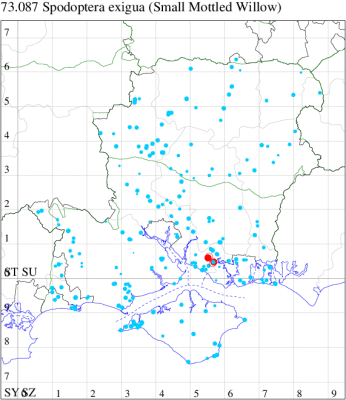
Records by year
Records by week (adult)
Records by week (larval)
Record Details
VC11: Catisfield, one, 25 May; one, 09 Jun (ALR); Fareham, one, 20 Sep (ADT)
73.0892 [B&F: 2386a] Asian Cotton Leafworm Spodoptera litura (Fabricius, 1775) - Import
Recorded infrequently through accidental importation in produce from Asia; usually recorded in the larval form and unlikely to reach Britain as a genuine migrant, first recorded at Manchester in 1978 on aquatic plants from Singapore. Not recorded in Hampshire or on the Isle of Wight to date. Wingspan 33-37 mm. Larva feeds on Tobacco, Rice and Cotton, causing sufficient damage to be a serious pest in some areas; no evidence of breeding in the UK.
Records prior to 2020
| Vice County | #Records | #Individuals | First Record | Last Record |
|---|
2020 records
| Vice County | #Records | #Individuals | Max Quantity |
|---|
Records by year
Records by week (adult)
Records by week (larval)
Record Details
VC12: New Vice-county Record: Farnborough*, one, field observation, 30 Sep (JSpr)
73.091 [B&F: 2396] Rosy Marbled Elaphria venustula (Hübner, 1790) - Nb
Nationally scarce (Nb) in deciduous woodland, heathland, roadside verges and rough ground in parts of south-eastern England. In Hampshire recorded infrequently in both vice-counties, and quite rare on the Isle of Wight. Most common in the New Forest where it favours bracken-clad open woodland and heath-margins where Tormentil grows. Wingspan 18-20 mm. Larva feeds on flowers of Tormentil and Creeping Cinquefoil, over-wintering as a pupa.
Records prior to 2020
| Vice County | #Records | #Individuals | First Record | Last Record |
|---|---|---|---|---|
| 10 | 11 | 8 | 1981 | 2019 |
| 11 | 534 | 713 | 1800 | 2019 |
| 12 | 86 | 108 | 1900 | 2019 |
2020 records
| Vice County | #Records | #Individuals | Max Quantity |
|---|---|---|---|
| 10 | 1 | 1 | 1 |
| 11 | 4 | 3 | 1 |
| 12 | 4 | 17 | 12 |
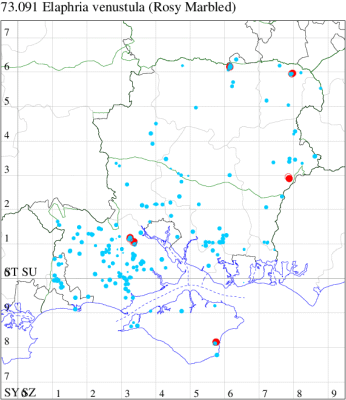
Records by year
Records by week (adult)
Records by week (larval)
Record Details
VC10: Shanklin, one, 15 Jun (IOu);
VC11: Woodlands, New Forest, present, 17 Jun (RBW); Ashurst, NF, one, 26 May (SAB); Wickham, one, 14 Jun; one, 23 Jun (JRDS);
VC12: Pamber Forest, 12, 25 Jun (GJD); Warren Hill, Liss Forest, two, 27 Jun (RJM); Castle Bottom NNR, two, 25 Jun (JHH, AMD)
73.092 [B&F: 2387] Mottled Rustic Caradrina morpheus (Hufnagel, 1766) - Common
Common in a wide range of low-land habitats, including grassland, farmland, heathland, scrub, woodland and gardens throughout the British Isles, a species of conservation concern under the UK Biodiversity Action Plan. Widespread and common in Hampshire and on the Isle of Wight. Wingspan 28-35 mm. Characterised by orbicular and reniform stigmata appearing blurred, without distinct edges. Larva feeds on Stinging Nettle, Curled Dock, Broad-leaved Dock, Goosefoot and Hedge Bedstraw, over-wintering in a cocoon.
Records prior to 2020
| Vice County | #Records | #Individuals | First Record | Last Record |
|---|---|---|---|---|
| 10 | 514 | 1174 | 1856 | 2019 |
| 11 | 5157 | 11583 | 1951 | 2019 |
| 12 | 1331 | 3162 | 1951 | 2019 |
2020 records
| Vice County | #Records | #Individuals | Max Quantity |
|---|---|---|---|
| 10 | 64 | 161 | 10 |
| 11 | 193 | 258 | 8 |
| 12 | 68 | 97 | 4 |
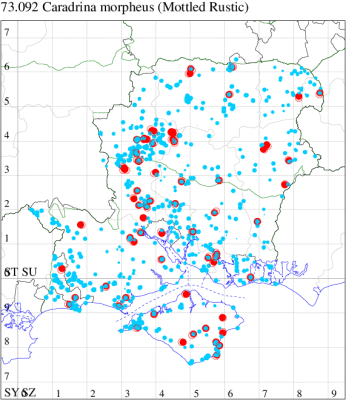
Records by year
Records by week (adult)
Records by week (larval)
Record Summary
VC10: Earliest: Freshwater Cliffs, 02 Jul, 1 (SDa) Latest: Sandown, 20 Jun, 2 (JMar) Max count: Freshwater Cliffs, 16 Jul, 10 (SDa)
VC11: Earliest: Brockwood, 23 May, 1 (SDut) Latest: Pennington, 01 Jul, 1 (RFC) Max count: Burton, nr Christchurch, 23 Jun, 8 (JSw)
VC12: Earliest: Cholderton, 17 Jul, 2 (TJN, HE) Latest: Farnborough, 17 Jul, 1 (KBW) Max count: Pamber Forest, 15 Jun, 4 (GJD)
73.093 [B&F: 2387a] Clancy's Rustic Caradrina kadenii (Freyer, [1836]) - Recent colonist
Increasingly common immigrant from southern Europe, appearing in southern England for the first time at New Romney, Kent, on 3 October 2002. Can now be found along the south coast, mostly in September and October, but occasionally as early as May. In our area first recorded in 2003, and 2006 saw a peak of 140 individuals in the southern two vice-counties: it was predicted that it may not be long before this species colonises the county, although to date no evidence has been found of breeding in our area; if it has done so then the Isle of Wight is most likely where counts have remained constant between 10 and 15 individuals for the past four years. Conversely, since 2010 counts are very low in South Hampshire. Reported three times in VC12. Wingspan 28-34 mm. On the continent, the larva feeds on various herbaceous plants.
Records prior to 2020
| Vice County | #Records | #Individuals | First Record | Last Record |
|---|---|---|---|---|
| 10 | 193 | 580 | 2005 | 2019 |
| 11 | 187 | 251 | 2003 | 2019 |
| 12 | 4 | 4 | 2007 | 2017 |
2020 records
| Vice County | #Records | #Individuals | Max Quantity |
|---|---|---|---|
| 10 | 41 | 79 | 5 |
| 11 | 20 | 21 | 3 |
| 12 | 2 | 2 | 1 |
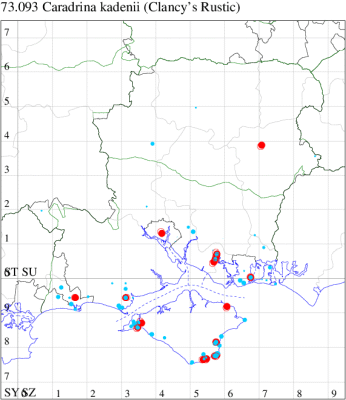
Records by year
Records by week (adult)
Records by week (larval)
Record Details
VC10: Freshwater Bay, one, 14 Sep; one, 20 Sep; one, 07 Nov (SDa); Freshwater, one, to actinic, 21 Sep; St Lawrence: Salem Close, four, to actinic, 26 Sep; two, to actinic, 27 Sep; four, to actinic, 28 Sep; one, to actinic, 29 Sep; Ventnor Botanic Garden, three, to actinic, 29 Sep (PBa); Wheelers Bay, one, 12 Jul; one, field observation, 30 Aug; one, 02 Sep; two, 10 Sep; five, 12 Sep; two, to actinic, 16 Sep; three, 16 Sep; one, 21 Sep; four, 30 Sep (ABu); Bonchurch, one, 26 May; one, 29 May; one, 02 Jun; one, 07 Jun; one, 08 Jun; four, 11 Jun; five, 15 Jun; two, 17 Jun; four, 19 Jun; two, 20 Jun; two, 22 Jun; one, 24 Jun; two, 25 Jun; three, 12 Jul; one, 13 Jul; one, 06 Sep; three, 07 Sep; one, 09 Nov (JHa); Shanklin, one, 11 Sep; one, 16 Sep; one, 18 Sep; one, 19 Sep (IOu); Ryde, one, 03 Sep (IPra det. OBea);
VC11: Southampton, one, to UV, 16 Sep (JVet); Sholing, Southampton, one, first since 2006, 19 Jun (ARC); Fareham, one, 14 Sep (ADT); one, 16 Sep (IMcP); one, to actinic, 08 Sep (MLO); three, 28 Sep (KJW); Portsmouth, one, 22 Sep; one, 28 Sep (IRT); Northney, Hayling Island, present, 28 Sep; present, 20 Oct (JWP); Burton, nr Christchurch, one, 23 Oct (JSw); Pennington, one, 19 Sep; one, 28 Sep (RFC);
VC12: Alton*, one, to actinic, 22 Sep; one, 07 Oct (BCA)
73.095 [B&F: 2389] Pale Mottled Willow Caradrina clavipalpis (Scopoli, 1763) - Common
Common in grassland, farmland and gardens throughout the British Isles. Widespread and common in Hampshire and on the Isle of Wight. Wingspan 24-32 mm. Very variable in size, but easy to recognise by the series of four small dots along the costa of each forewing, the first, at about one quarter distance from the base of the wing, often the least obvious; one of a number of superficially similar, fairly nondescript moths, which are often difficult for beginners, Pale Mottled Willow is relatively common from spring to autumn, while Small Mottled Willow Spodoptera exigua and Dark Mottled Willow S. cilium are both migrants, and differ in the way in which they hold their wings at rest. Larva feeds on seeds of various grasses and cereal crops.
Records prior to 2020
| Vice County | #Records | #Individuals | First Record | Last Record |
|---|---|---|---|---|
| 10 | 498 | 923 | 1951 | 2019 |
| 11 | 11971 | 24555 | 200 | 2019 |
| 12 | 2513 | 5098 | 1951 | 2019 |
2020 records
| Vice County | #Records | #Individuals | Max Quantity |
|---|---|---|---|
| 10 | 52 | 85 | 4 |
| 11 | 682 | 1239 | 24 |
| 12 | 201 | 401 | 15 |
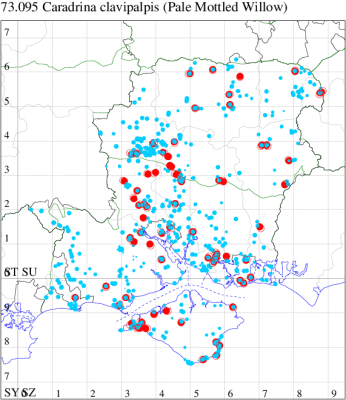
Records by year
Records by week (adult)
Records by week (larval)
Record Summary
VC10: Earliest: Totland, 18 Sep, 1 (RTe) Latest: Seaview, 11 Sep, 1 (JMas) Max count: Bonchurch, 24 Jun, 4 (JHa)
VC11: Earliest: Marchwood, 30 May, 1 (CTh) Latest: Southsea, 02 Jun, 0 (JRL) Max count: Southsea, 15 Aug, 19 (JGe)
VC12: Earliest: Cholderton, 22 Aug, 1 (TJN, LF) Latest: Yateley, 21 May, 1 (JHH) Max count: Farnborough, 02 Sep, 15 (KBW)
73.096 [B&F: 2381] Uncertain Hoplodrina octogenaria (Goeze, 1781) - Common
Common in a wide range of habitats, mainly in low-lying areas, including woodland, rough meadows and gardens throughout the British Isles. Widespread and common in Hampshire and on the Isle of Wight. Wingspan 31-33 mm. Easily and frequently confused with Rustic H. blanda, but generally H. octogenaria has broader and rougher forewing, stigmata contrasting with remainder of forewing, and more conspicuous cross-lines (MBGBI Vol 10). The general coloration of The Rustic is brown to grey with a glossy appearance, whereas The Uncertain is ochreous brown and coarser looking, and the orbicular stigma is usually smaller in The Rustic. The hindwings are greyer and glossier in The Rustic and the stigma smaller than The Uncertain. The Uncertain flies from late May, whereas The Rustic usually appears at the end of June. See the comparison photo in the collection above.
Please note that worn specimens of either species should be aggregated, if not determined by genitalia examination. It is also recommended that inexperienced recorders aggregate the two species, unless the specimen or photo is confirmed by their County Moth Recorder or an experienced local recorder.
Larva feeds on various herbaceous plants, including Chickweed, Primrose, Dock and Plantain.
Records prior to 2020
| Vice County | #Records | #Individuals | First Record | Last Record |
|---|---|---|---|---|
| 10 | 973 | 4239 | 1951 | 2019 |
| 11 | 12974 | 60783 | 1951 | 2019 |
| 12 | 3291 | 19055 | 1951 | 2019 |
2020 records
| Vice County | #Records | #Individuals | Max Quantity |
|---|---|---|---|
| 10 | 31 | 144 | 16 |
| 11 | 528 | 1776 | 26 |
| 12 | 297 | 1348 | 27 |
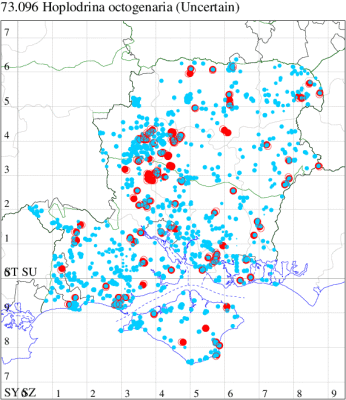
Records by year
Records by week (adult)
Records by week (larval)
Record Summary
VC10: Earliest: Cranmore, 22 Jun, 0 (CHic) Latest: Ryde, 30 Aug, 3 (IPra) Max count: Kingston, 24 Jun, 31 (ENes)
VC11: Earliest: Brockwood, 19 Jun, 1 (SDut) Latest: Southsea, 07 Sep, 1 (JGe) Max count: Fareham, 24 Jun, 26 (IMcP)
VC12: Earliest: Cholderton, 10 Jul, 11 (TJN, HE) Latest: Farnborough, 30 Jul, 1 (KBW) Max count: Basingstoke, 20 Jun, 27 (MJW)
73.097 [B&F: 2382] Rustic Hoplodrina blanda ([Denis & Schiffermüller], 1775) - Common
Common in a wide range of habitats, mainly in low-lying areas, including woodland, rough meadows and gardens throughout the British Isles, a species of conservation concern under the UK Biodiversity Action Plan. Common and well distributed in Hampshire and on the Isle of Wight. Wingspan 31-33 mm. Easily and frequently confused with Uncertain H. octogenaria, but generally H. blanda has a straighter costa, less rounded dorsum, smoother, more grey-brown forewing, stigmata less contrasting with remainder of forewing and slightly smaller. The Uncertain has broader wings, and is ochreous brown and coarser looking, with more obvious cross-lines, more contrasting stigmata, and a larger orbicular stigma. The Rustic has greyer and glossier in The Rustic, and appears later than The Uncertain, appearing towards the end of June, with the latter species appearing from late May. See the comparison photo in the collection above.
Please note - worn specimens of either species should be aggregated, if not determined by genitalia examination. It is also recommended that inexperienced recorders aggregate the two species, unless the specimen or photo is confirmed by their County Moth Recorder or an experienced local recorder.
Larva feeds on various herbaceous plants, including Chickweed, Dock and Plantain.
Records prior to 2020
| Vice County | #Records | #Individuals | First Record | Last Record |
|---|---|---|---|---|
| 10 | 496 | 1569 | 1950 | 2019 |
| 11 | 9656 | 34436 | 1951 | 2019 |
| 12 | 2246 | 10039 | 1950 | 2019 |
2020 records
| Vice County | #Records | #Individuals | Max Quantity |
|---|---|---|---|
| 10 | 22 | 43 | 8 |
| 11 | 297 | 813 | 18 |
| 12 | 135 | 316 | 19 |
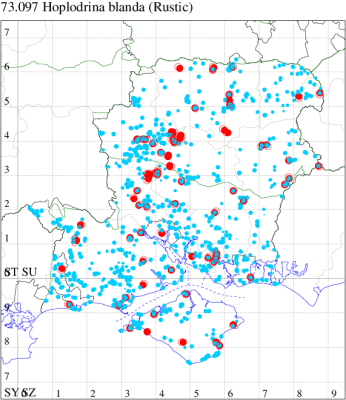
Records by year
Records by week (adult)
Records by week (larval)
Record Summary
VC10: Earliest: West High Down Quarry, 07 Aug, 1 (IOu) Latest: Bembridge Fort, 06 Aug, 1 (IOu) Max count: Kingston, 22 Jun, 8 (ENes)
VC11: Earliest: Brockwood, 14 Aug, 1 (SDut) Latest: Norleywood, NF, 09 Aug, 0 (RBW, MWa) Max count: Totton, 23 Jun, 18 (LH)
VC12: Earliest: Cholderton, 10 Jul, 9 (TJN, HE) Latest: Farnborough, 31 Jul, 1 (KBW) Max count: Cholderton, 17 Jul, 19 (TJN, HE)
73.099 [B&F: 2384] Vine's Rustic Hoplodrina ambigua ([Denis & Schiffermüller], 1775) - Local
Following an expansion in range and numbers in recent decades, now common in grassland, heathland, woodland rides and gardens throughout southern England and Wales, north to southern Scotland. Widespread and common in Hampshire and on the Isle of Wight. Wingspan 27-34 mm. The main confusion species are Uncertain H. alsines and Rustic H. blanda, but less variable and often slightly smaller than these species, generally rather pale grey-brown, with relatively large orbicular and reniform stigmata, usually slightly darker than the ground colour, and usually distinctly white-edged. Larva feeds on various herbaceous plants, including Dandelion, Greater Plantain, Ribwort Plantain, Primrose and Prickly Lettuce.
Records prior to 2020
| Vice County | #Records | #Individuals | First Record | Last Record |
|---|---|---|---|---|
| 10 | 956 | 4043 | 1856 | 2019 |
| 11 | 16459 | 75329 | 200 | 2019 |
| 12 | 3386 | 14741 | 1951 | 2019 |
2020 records
| Vice County | #Records | #Individuals | Max Quantity |
|---|---|---|---|
| 10 | 116 | 508 | 68 |
| 11 | 845 | 3095 | 57 |
| 12 | 312 | 1162 | 32 |
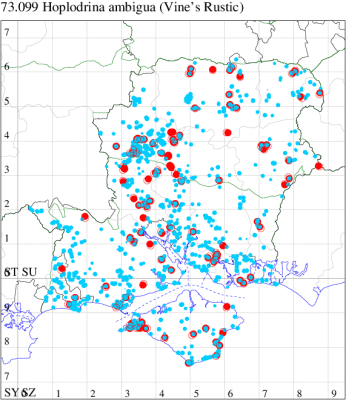
Records by year
Records by week (adult)
Records by week (larval)
Record Summary
VC10: Earliest: West High Down Quarry, 07 Aug, 6 (IOu) Latest: Ryde, 03 Sep, 2 (IPra) Max count: Shanklin, 14 Aug, 68 (IOu)
VC11: Earliest: Brockwood, 16 May, 1 (SDut) Latest: Southsea, 01 Jun, 3 (JRL) Max count: Southampton, 14 Aug, 57 (MEdg)
VC12: Earliest: Over Wallop, 27 Aug, 1 (CM) Latest: Yateley, 08 Sep, 3 (JHH) Max count: Alton, 15 Aug, 32 (DBO)
73.100 [B&F: 2391] Silky Wainscot Chilodes maritima (Tauscher, 1806) - Local
Local in reed-beds, on the south and east coasts of England. In Hampshire and on the Isle of Wight resident in most large reed-beds, and along the river valleys, with occasional wanderers turning up at light some distance from their breeding grounds. Wingspan 29-36 mm. Often found with the superficially similar Chilo phragmitella, which differs, for example, in having very long palps. Larva feeds on invertebrates, both living and dead, inside stems of Common Reed.
Records prior to 2020
| Vice County | #Records | #Individuals | First Record | Last Record |
|---|---|---|---|---|
| 10 | 39 | 63 | 1856 | 2019 |
| 11 | 430 | 567 | 1800 | 2019 |
| 12 | 38 | 33 | 1951 | 2018 |
2020 records
| Vice County | #Records | #Individuals | Max Quantity |
|---|---|---|---|
| 11 | 3 | 5 | 3 |
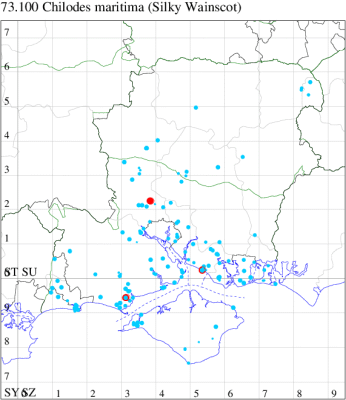
Records by year
Records by week (adult)
Records by week (larval)
Record Details
VC11: Romsey, one, 16 Jul (NRJ); Titchfield Haven NNR, three, 17 Jul (F.M.G.); Pennington, one, 26 Aug (RFC)
73.101 [B&F: 2380] Treble Lines Charanyca trigrammica (Hufnagel, 1766) - Common
Common in grassland, heathland, gardens and open woodland, and on sand-dunes and roadside verges throughout England. Widespread and common in Hampshire and on the Isle of Wight. Wingspan 33-40 mm. Unmistakable. Larva feeds on various herbaceous plants, including Common Knapweed, Greater Plantain and Dandelion.
Records prior to 2020
| Vice County | #Records | #Individuals | First Record | Last Record |
|---|---|---|---|---|
| 10 | 630 | 1397 | 1907 | 2019 |
| 11 | 7513 | 24118 | 1951 | 2019 |
| 12 | 2459 | 13654 | 1951 | 2019 |
2020 records
| Vice County | #Records | #Individuals | Max Quantity |
|---|---|---|---|
| 10 | 85 | 215 | 9 |
| 11 | 616 | 1780 | 31 |
| 12 | 318 | 2128 | 61 |
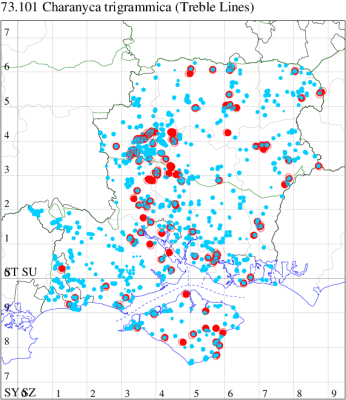
Records by year
Records by week (adult)
Records by week (larval)
Record Summary
VC10: Earliest: Freshwater Cliffs, 16 May, 1 (SDa) Latest: Sandpit Copse, 20 May, 2 (IOu) Max count: Shanklin Upper Chine, 02 Jun, 9 (IOu)
VC11: Earliest: Brockwood, 09 May, 1 (SDut) Latest: Southsea, 18 May, 1 (JRL) Max count: Wickham, 21 May, 31 (JRDS)
VC12: Earliest: Over Wallop, 16 May, 3 (CM) Latest: Yateley, 09 Jun, 7 (JHH) Max count: Pamber Forest, 18 May, 61 (GJD)
73.102 [B&F: 2302] Brown Rustic Rusina ferruginea (Esper, 1785) - Common
Common in broad-leaved woodland, gardens, parks, calcareous grassland, heathland and moorland throughout the British Isles. Widespread and common in Hampshire and on the Isle of Wight. Wingspan 32-40 mm. Fairly easy to recognise from combination of thin, black, antemedian and postmedian lines, between which runs a dark-shaded median fascia; also five or six white costal dots; with little variation in the overall pattern. Larva feeds on Vetch, Broad-leaved Dock, Curled Dock, Ribwort Plantain and Greater Plantain.
Records prior to 2020
| Vice County | #Records | #Individuals | First Record | Last Record |
|---|---|---|---|---|
| 10 | 89 | 95 | 1951 | 2019 |
| 11 | 1225 | 1956 | 1951 | 2019 |
| 12 | 1099 | 2040 | 1951 | 2019 |
2020 records
| Vice County | #Records | #Individuals | Max Quantity |
|---|---|---|---|
| 10 | 11 | 14 | 2 |
| 11 | 30 | 51 | 5 |
| 12 | 102 | 184 | 6 |
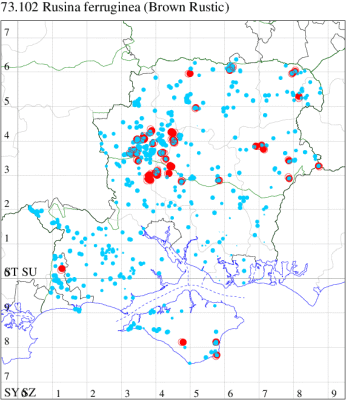
Records by year
Records by week (adult)
Records by week (larval)
Record Summary
VC10: Earliest: Kingston, 22 Jun, 1 (ENes) Latest: Shanklin, 21 Jun, 1 (IOu) Max count: Bonchurch, 07 Jun, 2 (JHa)
VC11: Earliest: Brockwood, 05 Jun, 1 (SDut) Latest: Wickham, 17 Jun, 1 (JRDS) Max count: Kings Somborne, 26 May, 5 (GCE)
VC12: Earliest: Broughton, 29 May, 1 (GCE) Latest: Yateley, 23 Jun, 3 (JHH) Max count: Wherwell, 13 Jun, 6 (GCE)
73.105 [B&F: 2301] Bird's Wing Dypterygia scabriuscula (Linnaeus, 1758) - Local
Local in broad-leaved woodland, parks, heathland and scrub throughout south-eastern England. In Hampshire fairly common in the south but rather scarce in the north and on the Isle of Wight. Wingspan 34-42 mm. Unmistakable. Larva feeds on Broad-leaved Dock, Curled Dock, Sheep's Sorrel, Common Sorrel and Knotgrass, over-wintering as a pupa.
Records prior to 2020
| Vice County | #Records | #Individuals | First Record | Last Record |
|---|---|---|---|---|
| 10 | 79 | 105 | 1904 | 2019 |
| 11 | 1296 | 1455 | 1951 | 2019 |
| 12 | 280 | 297 | 1951 | 2019 |
2020 records
| Vice County | #Records | #Individuals | Max Quantity |
|---|---|---|---|
| 10 | 21 | 35 | 4 |
| 11 | 46 | 50 | 4 |
| 12 | 26 | 37 | 4 |
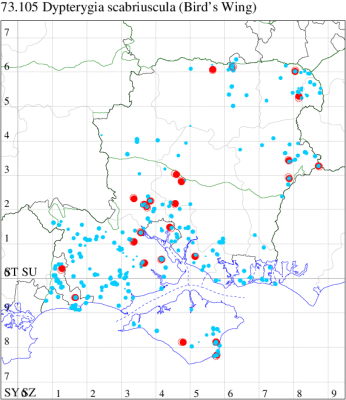
Records by year
Records by week (adult)
Records by week (larval)
Record Details
VC10: Kingston, three, 17 Jun; one, 22 Jun; three, 24 Jun; two, 01 Jul; one, 02 Jul (ENes); Bonchurch, one, 21 May; one, 25 May; one, 30 May; two, 02 Jun; one, 07 Jun; two, 08 Jun; two, 11 Jun; four, 15 Jun; three, 17 Jun; two, 19 Jun; one, 20 Jun; one, 22 Jun; one, 24 Jun; one, 12 Jul (JHa); Shanklin, one, 15 Jun; one, 17 Jun (IOu);
VC11: Brockwood, one, 13 Jun; two, 04 Jul; one, 30 Jul (SDut); Culverley, NF, one, 19 Jul (CL); Ashurst, NF, one, 26 May (SAB); Totton, present, 02 Jul (LH); Stanbrige Earls, one, to actinic, 23 Jun (JRMi); Romsey, one, 28 May (SLay); one, 20 May; one, 24 May (MB); one, 22 May (NRJ); Dibden Purlieu, one, to actinic, 24 Jun; one, to actinic, 25 Jun; one, to actinic, 28 Jul (RAC); Southampton, one, 19 May; one, 12 Jun; one, to actinic, 17 Jun; one, to actinic, 23 Jun (MEdg); one, to actinic, 23 Jun (MGP); Allbrook, one, 15 Jun (SI); Winchester, one, 23 Jun (THW); Teg Down, one, to actinic, 17 Jun (EmPe); Locks Heath, one, 09 Jun (PAS); Wickham, one, 12 Jun; one, 15 Jun; one, 17 Jun; one, 29 Jun; one, 11 Jul; one, 12 Jul; one, 13 Jul (JRDS); Burton, nr Christchurch, one, 19 Jun (JSw); Sway, one, 04 Jun; four, 14 Jun; one, 15 Jun; one, 17 Jun; two, 22 Jun (SKe);
VC12: Harestock, one, to actinic, 09 Jul (GRog); Axmansford, one, 02 Jun (ACB); Pamber Forest, one, 20 May; one, 23 Jun (GJD); Steep, one, 24 Jul (MSho); Liss Forest, four, 14 Jun; two, 27 Jun (RJM); Whitehill, one, to actinic, 09 May; one, to actinic, 24 May; two, to actinic, 17 Jun; three, to actinic, 20 Jun; three, to actinic, 23 Jun; one, to actinic, 25 Jun; one, to actinic, 30 Jun; one, to actinic, 02 Jul; two, to actinic, 07 Jul; one, to actinic, 13 Jul; one, to actinic, 31 Jul (ASto); Headley, Bordon, present, 10 Jul (iNat); Hammer Vale, Woolmer, one, 25 May; one, 03 Jun; two, 14 Jun; two, 16 Jun (ASw); Fleet, one, 02 Jun (MHals); Yateley, one, 09 Jun (JHH)
73.107 [B&F: 2300] Old Lady Mormo maura (Linnaeus, 1758) - Local
Local in marshes, gardens, hedgerows, scrub and woodland throughout much of the British Isles. In Hampshire and on the Isle of Wight is likely to be under-recorded, since it comes rarely to light, although it does come to sugar. Appears to favour watercourses through deciduous woodland, and is sometimes found roosting communally under bridges over streams. Wingspan 64-74 mm. Unmistakable. Larva feeds on various herbaceous and woody plants, such as Chickweed, Dock, Ivy and Hawthorn.
Records prior to 2020
| Vice County | #Records | #Individuals | First Record | Last Record |
|---|---|---|---|---|
| 10 | 49 | 48 | 1975 | 2019 |
| 11 | 1281 | 1397 | 1945 | 2019 |
| 12 | 579 | 820 | 1800 | 2019 |
2020 records
| Vice County | #Records | #Individuals | Max Quantity |
|---|---|---|---|
| 10 | 4 | 5 | 2 |
| 11 | 79 | 92 | 4 |
| 12 | 29 | 34 | 5 |
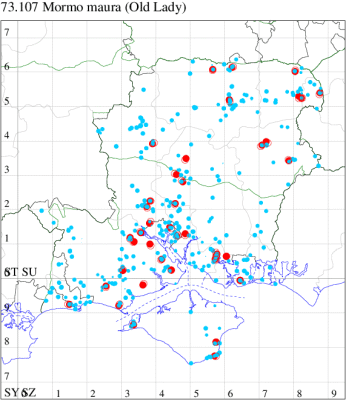
Records by year
Records by week (adult)
Records by week (larval)
Record Details
VC10: Freshwater, one, 16 Oct (DBW); Wheelers Bay, one, 10 Sep (ABu); Shanklin, two, 13 Sep; one, 15 Sep (IOu);
VC11: Brockenhurst, present, field observation, 20 Jul (iNat); one, field observation, 24 Aug (PDB); Marchwood, one, 29 Aug (CTh); Woodlands, New Forest, present, 25 Jun (RBW); Ashurst, NF, one, 12 Aug; two, 08 Sep; one, 11 Sep; one, 14 Sep (SAB); Totton, one, 13 Sep (LH); Southampton, one, 05 Jul (JClx); Romsey, one, 12 Sep; one, 14 Sep; one, 16 Sep (MB); one, 17 Jun (NRJ); Dibden Purlieu, one, 19 Aug; one, 13 Sep; one, 14 Sep (RAC); Blackfied, one, to lighted window, 01 Sep (PGS); Southampton, one, 31 Aug; one, 04 Sep; one, 06 Sep; one, 12 Sep; two, 14 Sep (MEdg); one, to actinic, 09 Sep; one, to actinic, 11 Sep (MGP); Thornhill, one, field observation, on Buddleia , 27 Aug (PAB); Wildern LNR, one, field observation, 13 Sep (TCr); Eastleigh, two, to actinic, 06 Jul; one, to actinic, 10 Jul; two, to actinic, 04 Sep (KArb); Allbrook, one, 18 Aug; one, 29 Aug (SI); St Faith's HIWWT NR, St Cross, one, field observation, 12 Jul (ThGr); Teg Down, one, to actinic, 08 Sep (EmPe); Fareham, one, 16 Sep; one, 29 Sep (IMcP); two, to actinic, 07 Sep; one, to actinic, 09 Sep (MLO); one, 02 Sep; one, 16 Sep (KJW); Portchester, one, 15 Jul; one, 16 Jul (JGe); Lovedean, one, 10 Aug; one, 06 Sep; one, 09 Sep; one, 22 Sep (ARJ); Northney, Hayling Island, present, 28 Sep (JWP); Petersfield, one, to actinic, 04 Jul (RAll); Tuckton, Bournemouth, one, 11 Sep (APar); Sway, one, to actinic, 23 Aug (S&SL); Milford on Sea, one, 17 Sep (MMcM); Keyhaven, present, field observation, 22 Jun (iNat); Norleywood, NF, present, 09 Aug (RBW, MWa); Southsea, one, 14 Jul; two, 10 Sep; one, 13 Sep; two, 16 Sep; one, 18 Sep; one, 19 Sep (JGe);
VC12: Chilbolton, larva, four, field observation, 11 Apr; larva, five, field observation, at least five present on Ivy in porch, probably more, 03 May (GCE); Kings Worthy, larva, one, field observation, 17 Apr (JtSm); Axmansford, one, to lighted window, 07 Aug; one, 03 Sep; one, 22 Sep (ACB); Beech, one, 14 Sep (NDP); Basingstoke, one, to actinic, 01 Jul (JHu); Bramley, present, field observation, 29 Jun; Tadley, present, field observation, 08 Aug (iNat); Pamber Forest, one, 08 Jul (GJD); Alton, one, to actinic, 08 Sep; one, to actinic, 12 Sep; one, to actinic, 19 Sep (DBO); one, 01 Sep; one, 07 Sep (EFig); one, 13 Jul (SMu); one, to actinic, 30 Aug; one, sugar, 31 Aug; one, to actinic, 07 Sep (NDP); Whitehill, one, to actinic, 24 Aug; one, 15 Sep (ASto); Lower Froyle, one, 11 Sep (EFig); Fleet, one, 15 Jul (MHals); Church Crookham, one, to actinic, 26 Jun; one, to actinic, 15 Sep (DDim); Farnborough, one, 08 Sep (KBW); Yateley, one, 23 Jun (JHH)
73.109 [B&F: 2303] Straw Underwing Thalpophila matura (Hufnagel, 1766) - Common
Common on calcareous grassland, moorland, sand-dunes, woodland rides, gardens and parks throughout England and Wales, but mainly coastal in Scotland. Widespread and common in Hampshire and on the Isle of Wight. Wingspan 38-46 mm. Identification easy to confirm by examination of the hindwing, which can be seen by gently lifting up the forewing with forceps, and which is pale straw-coloured with fuscous border extending to one-quarter (MBGBI Vol 10). Larva feeds on various grasses, including Annual Meadow-grass, Mat-grass and Silver Hair-grass.
Records prior to 2020
| Vice County | #Records | #Individuals | First Record | Last Record |
|---|---|---|---|---|
| 10 | 138 | 258 | 1959 | 2019 |
| 11 | 1567 | 2720 | 1949 | 2019 |
| 12 | 1094 | 3002 | 1951 | 2019 |
2020 records
| Vice County | #Records | #Individuals | Max Quantity |
|---|---|---|---|
| 10 | 28 | 65 | 12 |
| 11 | 163 | 349 | 13 |
| 12 | 131 | 461 | 20 |
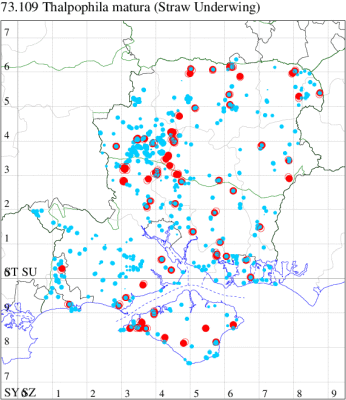
Records by year
Records by week (adult)
Records by week (larval)
Record Summary
VC10: Earliest: West High Down Quarry, 20 Aug, 5 (IOu) Latest: Bembridge Fort, 06 Aug, 1 (IOu) Max count: Compton Down, 14 Sep, 12 (PBa)
VC11: Earliest: Brockwood, 07 Aug, 1 (SDut) Latest: Norleywood, NF, 09 Aug, 0 (RBW, MWa) Max count: East Tytherley, 10 Aug, 13 (GCE)
VC12: Earliest: Over Wallop, 29 Aug, 1 (CM) Latest: Yateley, 08 Aug, 4 (JHH) Max count: Barton Stacey, 14 Aug, 20 (GCE)
73.113 [B&F: 2306] Angle Shades Phlogophora meticulosa (Linnaeus, 1758) - Common
Common in a wide range of habitats, including gardens, hedgerows, fens and woodland throughout the British Isles. Widespread and common in Hampshire and on the Isle of Wight. Wingspan 50-60 mm. Unmistakable resting posture with forewing folded in on itself at the costa only shared by the much smaller Small Angle Shades Euplexia lucipara. Larva polyphagous on a wide range of herbaceous and woody plants, including Stinging Nettle, Hop, Red Valerian, Broad-leaved Dock, Bramble, Silver and Downy Birch, Sessile and Pedunculate Oak, and Hazel.
Records prior to 2020
| Vice County | #Records | #Individuals | First Record | Last Record |
|---|---|---|---|---|
| 10 | 1140 | 1915 | 1908 | 2019 |
| 11 | 10726 | 18162 | 1900 | 2019 |
| 12 | 2315 | 3340 | 1951 | 2019 |
2020 records
| Vice County | #Records | #Individuals | Max Quantity |
|---|---|---|---|
| 10 | 96 | 197 | 20 |
| 11 | 339 | 437 | 13 |
| 12 | 88 | 95 | 3 |
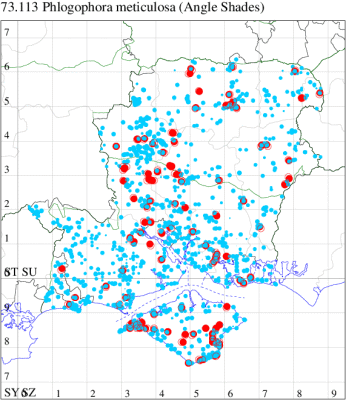
Records by year
Records by week (adult)
Records by week (larval)
Record Summary
VC10: Earliest: West High Down Quarry, 20 Aug, 4 (IOu) Latest: Ryde, 03 Sep, 1 (IPra) Max count: Freshwater Bay, 20 Sep, 20 (SDa)
VC11: Earliest: Brockwood, 29 Aug, 2 (SDut) Latest: Southsea, 30 Oct, 1 (JRL) Max count: Ashurst, NF, 15 Sep, 13 (SAB)
VC12: Earliest: Over Wallop, 12 Sep, 1 (CM) Latest: Yateley, 08 Sep, 1 (JHH) Max count: Cholderton, 05 Sep, 3 (TJN, LF)
73.114 [B&F: 2305] Small Angle Shades Euplexia lucipara (Linnaeus, 1758) - Common
Common in gardens, parks, woodland, heathland and moorland throughout the British Isles; well distributed across much of Hampshire and on the Isle of Wight. Wingspan 30-35 mm. Unmistakable resting posture with forewing folded in on itself at the costa only shared by the much larger Angle Shades Phlogophora meticulosa. The larva is one of the few to feed on bracken and other ferns, but will also feed on a variety of herbaceous plants and shrubs, including birch and sallow, over-wintering as a pupa.
Records prior to 2020
| Vice County | #Records | #Individuals | First Record | Last Record |
|---|---|---|---|---|
| 10 | 318 | 490 | 1908 | 2019 |
| 11 | 1493 | 1677 | 1951 | 2019 |
| 12 | 388 | 390 | 1951 | 2019 |
2020 records
| Vice County | #Records | #Individuals | Max Quantity |
|---|---|---|---|
| 10 | 10 | 16 | 6 |
| 11 | 22 | 22 | 2 |
| 12 | 5 | 5 | 1 |
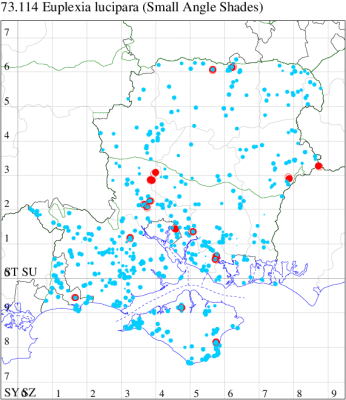
Records by year
Records by week (adult)
Records by week (larval)
Record Details
VC10: Parkhurst Forest, two, 29 Jun; Shanklin, one, 14 Jun; one, 15 Jun; one, 22 Jun; six, 24 Jun; one, 25 Jun; one, 06 Jul; one, 07 Jul; one, 12 Jul; one, 16 Jul (IOu);
VC11: Woodlands, New Forest, present, 01 Jul (RBW); Romsey, one, 24 Jun (SLay); one, 29 Jun; one, 18 Jul; one, 08 Aug (MB); one, 17 Jun (NRJ); Kings Somborne, one, to actinic, 11 Jun; one, to actinic, 09 Jul; one, to actinic, 26 May (GCE); West End, one, 16 Jul (PAB); Eastleigh, one, to actinic, 05 Aug (KArb); Fareham, one, 24 Jun (IMcP); one, to actinic, 29 Jun (MLO); Botley, one, to actinic, 12 Jul (SLB); Wickham, one, 14 Jun; two, 24 Jun; one, 04 Jul; one, 08 Jul; one, 12 Jul (JRDS); Burton, nr Christchurch, one, 02 Jun; one, 23 Jun (JSw);
VC12: Axmansford, one, 12 Jun (ACB); Pamber Forest, one, 17 Jun; one, 01 Jul (GJD); Liss Forest, one, 27 Jun (RJM); Hammer Vale, Woolmer, one, 02 Jul (ASw)
73.119 [B&F: 2368] Crescent Helotropha leucostigma (Hübner, [1808]) - Local
Local in fens, reed-beds, marshes, river-banks and other damp areas throughout much of the British Isles, a species of conservation concern under the UK Biodiversity Action Plan. In Hampshire and on the Isle of Wight mainly confined to the coast, principally at Titchfield Haven, with a scattering of inland records, along the Avon to the west of the New Forest and up the Test valley. Quite scarce on the Isle of Wight. Wingspan 35-41 mm. Forewing rather narrow and pointed, the costa arched, termen crenulate, dorsum weakly lobed beyond narrowed base (MBGBI Vol 10). Larva feeds on Great Fen-sedge and Yellow Iris, over-wintering as an egg.
Records prior to 2020
| Vice County | #Records | #Individuals | First Record | Last Record |
|---|---|---|---|---|
| 10 | 29 | 17 | 1906 | 2018 |
| 11 | 272 | 471 | 1949 | 2019 |
| 12 | 80 | 117 | 1951 | 2019 |
2020 records
| Vice County | #Records | #Individuals | Max Quantity |
|---|---|---|---|
| 11 | 1 | 2 | 2 |
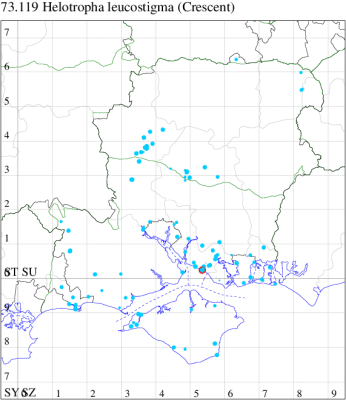
Records by year
Records by week (adult)
Records by week (larval)
Record Details
VC11: Titchfield Haven NNR, two, 17 Jul (F.M.G.)
73.120 [B&F: 2352] Dusky Sallow Eremobia ochroleuca ([Denis & Schiffermüller], 1775) - Common
Common in calcareous grassland, and on roadside verges and embankments throughout much of south-eastern England, north to Yorkshire. In Hampshire and on the Isle of Wight has increased and expanded its range spectacularly since the 1950s, and is now widespread, being particularly common on the chalk and along the coast. Wingspan 34-37 mm. The only likely confusion species is the very much rarer Viper's Bugloss Hadena irregularis, which see. Larva feeds on flowers and seeds of various cereal crops and grasses, including Cock's-foot, False Oat-grass and Common Couch, over-wintering as an egg.
Records prior to 2020
| Vice County | #Records | #Individuals | First Record | Last Record |
|---|---|---|---|---|
| 10 | 120 | 145 | 1856 | 2019 |
| 11 | 1497 | 2277 | 1951 | 2019 |
| 12 | 703 | 1222 | 1951 | 2019 |
2020 records
| Vice County | #Records | #Individuals | Max Quantity |
|---|---|---|---|
| 10 | 17 | 41 | 10 |
| 11 | 65 | 130 | 11 |
| 12 | 48 | 90 | 10 |
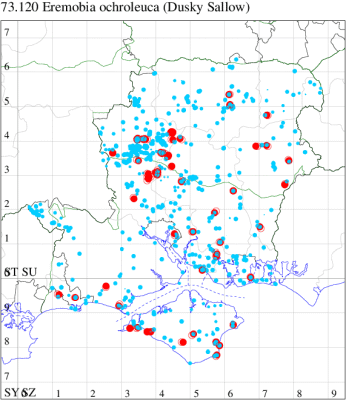
Records by year
Records by week (adult)
Records by week (larval)
Record Summary
VC10: Earliest: West High Down Quarry, 07 Aug, 2 (IOu) Latest: Bembridge Fort, 06 Aug, 2 (IOu) Max count: Kingston, 22 Jul, 10 (ENes)
VC11: Earliest: Stanbrige Earls, 06 Jul, 1 (JRMi) Latest: Milford on Sea, 24 Jul, 1 (MMcM) Max count: Ashley, 22 Jul, 11 (GCE)
VC12: Earliest: Nether Wallop, 22 Jul, 1 (MB) Latest: South Warnborough, 22 Jul, 1 (DLee) Max count: Wherwell, 19 Jul, 10 (GCE)
73.121 [B&F: 2364] Frosted Orange Gortyna flavago ([Denis & Schiffermüller], 1775) - Common
Common in rough grassland, woodland, waste ground, fens, marshes and gardens throughout much of the British Isles. In Hampshire and on the Isle of Wight fairly common, possibly increasing. Wingspan 32-42 mm. Larva feeds on various herbaceous plants, including Lesser Burdock, Greater Burdock, Foxglove, Creeping Thistle, Musk Thistle and Spear Thistle, over-wintering as an egg.
Records prior to 2020
| Vice County | #Records | #Individuals | First Record | Last Record |
|---|---|---|---|---|
| 10 | 219 | 302 | 1951 | 2019 |
| 11 | 1056 | 1216 | 1949 | 2019 |
| 12 | 456 | 536 | 1950 | 2019 |
2020 records
| Vice County | #Records | #Individuals | Max Quantity |
|---|---|---|---|
| 10 | 27 | 37 | 3 |
| 11 | 34 | 35 | 2 |
| 12 | 12 | 12 | 1 |
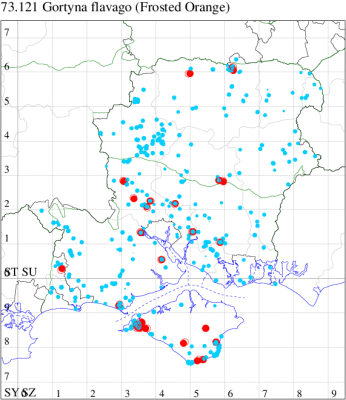
Records by year
Records by week (adult)
Records by week (larval)
Record Details
VC10: Freshwater Bay, one, 14 Sep (SDa); Afton Marsh, one, to light, 28 Sep (IOu); Freshwater Bay, two, to actinic, 13 Sep; two, to actinic, 15 Sep; two, to actinic, 17 Sep; one, to actinic, 19 Sep; one, to actinic, 21 Sep; Freshwater, one, to actinic, 21 Sep; two, to actinic, 22 Sep; one, to actinic, 23 Sep; one, to actinic, 12 Sep; two, to actinic, 16 Sep; one, to actinic, 15 Sep; two, to actinic, 20 Sep; Compton Down, one, to actinic, 13 Sep (PBa); Kingston, one, 05 Sep (CHer); Parkhurst Forest, one, 08 Sep (IM det. TJN); St Lawrence Undercliff, two, to actinic, 28 Sep; St Lawrence: Salem Close, one, to actinic, 27 Sep; two, to actinic, 28 Sep (PBa); Haseley Manor, three, 21 Sep; Shanklin, one, 11 Sep; one, 12 Sep; one, 15 Sep; one, 16 Sep; one, 30 Sep (IOu);
VC11: Brockwood, one, 12 Sep (SDut); Totton, one, 25 Sep; one, 29 Sep (LH); East Tytherley, one, to actinic, 14 Sep; one, to actinic, 14 Sep (GCE); Stanbrige Earls, one, to actinic, 02 Sep; one, 12 Sep (JRMi); Romsey, one, 14 Sep; one, 18 Sep; one, 26 Sep (MB); two, 18 Sep; two, 22 Sep (NRJ); Dibden Purlieu, one, 17 Sep; one, 18 Sep (RAC); Eastleigh, one, to actinic, 29 Aug (KArb); Allbrook, one, 19 Sep (SI); Botley, one, to actinic, 25 Aug; one, to actinic, 22 Aug; one, to actinic, 08 Sep; one, to actinic, 11 Oct (SLB); Wickham Common, one, 22 Aug (KC); Wickham, one, 22 Aug; one, 23 Aug; one, 05 Sep; one, 15 Sep; one, 16 Sep; one, 21 Sep (JRDS); Drayton, present, 11 Sep (iNat); Petersfield, one, to actinic, 26 Aug; Stroud, Petersfield, one, to actinic, 15 Sep (RAll); Milford on Sea, one, 17 Sep (MMcM);
VC12: Cholderton, one, field observation, 12 Sep (TJN, LF); Ecchinswell, one, to actinic, 05 Sep (MTa, CSu); Cheriton, one, to actinic, 20 Aug; one, to actinic, 14 Sep; one, to actinic, 18 Sep (DAS); Hinton Ampner, one, 19 Sep (ASD); Beech, one, 16 Sep (NDP); Pamber Forest, one, 14 Sep; one, 21 Sep; one, 07 Sep (GJD); Steep, one, 25 Jul (MSho)
73.123 [B&F: 2361] Rosy Rustic Hydraecia micacea (Esper, 1789) - Common
Common in gardens, hedgerows, fens and woodland rides, and on rough ground and at freshwater margins throughout the British Isles, a species of conservation concern under the UK Biodiversity Action Plan. In Hampshire and on the Isle of Wight widespread and locally common. Wingspan 34-50 mm. Fairly unmistakable, but variable in size. Larva feeds in the tap-roots of plants such as Dock, Hop, Plantain, Woundwort and Burdock, over-wintering as an egg.
Records prior to 2020
| Vice County | #Records | #Individuals | First Record | Last Record |
|---|---|---|---|---|
| 10 | 192 | 260 | 1951 | 2019 |
| 11 | 4024 | 6468 | 1949 | 2019 |
| 12 | 1152 | 1988 | 1951 | 2019 |
2020 records
| Vice County | #Records | #Individuals | Max Quantity |
|---|---|---|---|
| 10 | 30 | 51 | 8 |
| 11 | 173 | 330 | 18 |
| 12 | 47 | 67 | 5 |
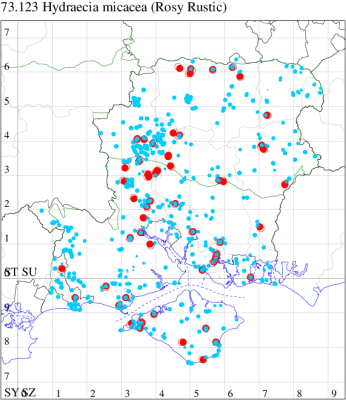
Records by year
Records by week (adult)
Records by week (larval)
Record Summary
VC10: Earliest: Totland, 18 Sep, 4 (RTe) Latest: Shanklin, 16 Sep, 1 (IOu) Max count: Freshwater, 12 Sep, 8 (PBa)
VC11: Earliest: Brockwood, 22 Aug, 1 (SDut) Latest: Pennington, 21 Sep, 1 (RFC) Max count: Botley, 26 Aug, 18 (SLB)
VC12: Earliest: Cholderton, 12 Sep, 1 (TJN, LF) Latest: Lower Froyle, 11 Sep, 1 (EFig) Max count: Ecchinswell, 22 Aug, 5 (MJN)
73.126 [B&F: 2358] Saltern Ear Amphipoea fucosa (Freyer, 1830) - Local
Local on coastal salt-marshes and sand-dunes, on the south and east coasts of England and Wales as far north as the Humber and Morecambe Bay, extending inland at low density in some areas, but distribution in northern Britain poorly known owing to confusion with Large Ear. In Hampshire and on the Isle of Wight locally common on the coastal salterns, with occasional records inland. Wingspan 29-35 mm. Very similar to Large Ear A. lucens, which see for details. In southern England, may be confused with Ear Moth A. oculea, however Saltern Ear is generally paler and longer-winged. Larva feeds on roots and lower stems of various grasses, over-wintering as an egg.
Records prior to 2020
| Vice County | #Records | #Individuals | First Record | Last Record |
|---|---|---|---|---|
| 10 | 37 | 19 | 1856 | 2018 |
| 11 | 348 | 441 | 1951 | 2019 |
| 12 | 5 | 1 | 1951 | 2009 |
2020 records
| Vice County | #Records | #Individuals | Max Quantity |
|---|---|---|---|
| 10 | 3 | 3 | 1 |
| 11 | 10 | 2 | 1 |
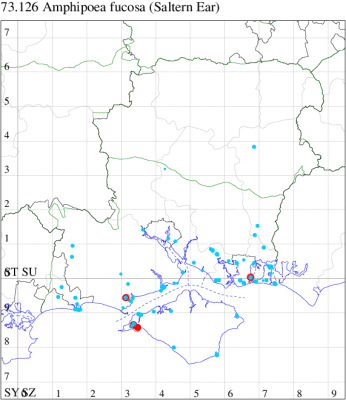
Records by year
Records by week (adult)
Records by week (larval)
Record Details
VC10: Freshwater, one, 14 Aug (DBW); Freshwater Cliffs, one, 09 Jul; one, 16 Jul (SDa);
VC11: Portsmouth, one, 19 Jul (IRT); Northney, Hayling Island, present, 17 Jun; present, 19 Jun; present, 25 Jun; present, 28 Jun; present, 11 Jul; present, 01 Aug; present, 12 Aug; present, 15 Aug (JWP); Pennington, one, 14 Aug (RFC)
73.128 [B&F: 2360] Ear Moth Amphipoea oculea (Linnaeus, 1761) - Common
Common in unimproved grassland, woodland rides, marshes, moorland, saltmarshes and gardens throughout much of the British Isles, a species of conservation concern under the UK Biodiversity Action Plan. In Hampshire and on the Isle of Wight widespread and still found in small numbers across the county. Wingspan 28-34 mm. Ear Moth is very like other Amphipoea species and those from northern Britain at any rate can only be identified with certainty by reference to the genitalia (MBGBI Vol 10). In southern England, it may be confused with Saltern Ear A. fucosa, however Saltern Ear is generally paler and longer-winged. Larva feeds within stems and roots of various grasses, including Annual Meadow-grass and Tufted Hair-grass, and herbaceous plants such as Butterbur, over-wintering as an egg.
Records prior to 2020
| Vice County | #Records | #Individuals | First Record | Last Record |
|---|---|---|---|---|
| 10 | 38 | 21 | 1951 | 2018 |
| 11 | 1140 | 1689 | 1951 | 2019 |
| 12 | 417 | 551 | 1951 | 2019 |
2020 records
| Vice County | #Records | #Individuals | Max Quantity |
|---|---|---|---|
| 11 | 13 | 11 | 1 |
| 12 | 19 | 33 | 7 |
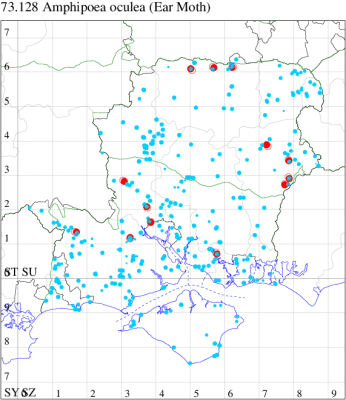
Records by year
Records by week (adult)
Records by week (larval)
Record Details
VC11: Ditchend Brook, Newfoundland, NF, present, 30 Jul (RBW, MWa); Woodlands, New Forest, present, 16 Jul (RBW); Rownhams, one, 29 Jul (AMS); East Tytherley, one, to actinic, 10 Aug (GCE); Romsey, one, 30 Jul (MB); Fareham, one, 01 Aug (KJW); Lovedean, one, 19 Jul; one, 29 Jul; one, 30 Jul; one, 06 Aug (ARJ);
VC12: Cholderton, one, field observation, 11 Aug (TJN, LF); Anna Valley, Andover, one, 07 Aug (TJN); Ecchinswell, one, 31 Jul (MJN); Axmansford, one, 13 Jul (ACB); Pamber Forest, one, 10 Aug (GJD); Liss, three, 14 Aug (LBe); Liss Forest, two, 11 Jul; one, 18 Jul; three, 25 Jul; two, 01 Aug; seven, 08 Aug; three, 15 Aug; one, 23 Aug; one, 29 Aug (RJM); Alton, one, to actinic, 16 Jul (CJP); Whitehill, one, to actinic, 15 Aug; one, to actinic, 21 Aug; one, to actinic, 24 Aug (ASto)
73.131 [B&F: 2353] Flounced Rustic Luperina testacea ([Denis & Schiffermüller], 1775) - Common
Common on calcareous grassland, sand-dunes, farmland and open woodland throughout the British Isles. Widespread and common in Hampshire and on the Isle of Wight. Wingspan 32-40 mm. Superficially resembles Common Rustic Mesapamea secalis and its congeners, but postmedian fascia highly dentate (sinuate in Mesapamea), with the main confusion species either extremely rare (Dumeril's Rustic L. dumerilii) or with a limited coastal distribution (Sandhill Rustic L. nickerlii). Larva feeds on roots and lower stems of various grasses, including Common Couch, Red Fescue, Sheep's-fescue, Tall Fescue and some cereal crops.
Records prior to 2020
| Vice County | #Records | #Individuals | First Record | Last Record |
|---|---|---|---|---|
| 10 | 456 | 2486 | 1951 | 2019 |
| 11 | 7325 | 24465 | 1949 | 2019 |
| 12 | 2517 | 10625 | 1951 | 2019 |
2020 records
| Vice County | #Records | #Individuals | Max Quantity |
|---|---|---|---|
| 10 | 58 | 243 | 20 |
| 11 | 447 | 1345 | 34 |
| 12 | 230 | 1252 | 93 |
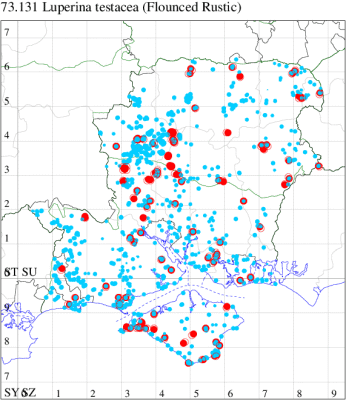
Records by year
Records by week (adult)
Records by week (larval)
Record Summary
VC10: Earliest: Headon Warren, 17 Sep, 2 (PBa) Latest: Ryde, 03 Sep, 1 (IPra) Max count: Compton Down, 14 Sep, 20 (PBa)
VC11: Earliest: Brockwood, 07 Aug, 1 (SDut) Latest: Southsea, 07 Sep, 1 (JGe) Max count: Broughton, 31 Aug, 34 (GCE)
VC12: Earliest: Over Wallop, 15 Sep, 1 (CM) Latest: Yateley, 08 Sep, 3 (JHH) Max count: Cholderton, 22 Aug, 93 (TJN, LF)
73.134 [B&F: 2375] Large Wainscot Rhizedra lutosa (Hübner, [1803]) - Common
Common in reed-beds throughout much of the British Isles, a species of conservation concern under the UK Biodiversity Action Plan. In Hampshire and on the Isle of Wight widely distributed in the drier parts of reed-beds in all three vice-counties. Wingspan 36-52 mm. The most likely confusion species is Bulrush Wainscot Nonagria typhae, which see for differences. Occasional wanderers, nearly always females, are taken at light some distant from known breeding colonies. Larva feeds on Common Reed, over-wintering as an egg.
Records prior to 2020
| Vice County | #Records | #Individuals | First Record | Last Record |
|---|---|---|---|---|
| 10 | 216 | 299 | 1856 | 2019 |
| 11 | 1227 | 2456 | 1949 | 2019 |
| 12 | 296 | 716 | 1951 | 2019 |
2020 records
| Vice County | #Records | #Individuals | Max Quantity |
|---|---|---|---|
| 10 | 3 | 5 | 2 |
| 11 | 29 | 28 | 2 |
| 12 | 3 | 3 | 1 |
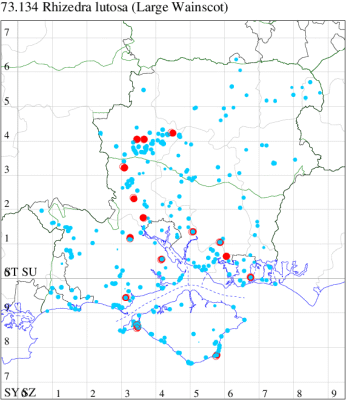
Records by year
Records by week (adult)
Records by week (larval)
Record Details
VC10: Freshwater Bay, two, 18 Oct (SDa); Afton Marsh, two, to light, 28 Sep (IOu); Bonchurch, one, 07 Nov (JHa);
VC11: Woodlands, New Forest, present, 22 Sep (RBW); Lee, one, 17 Oct (CTh); Stanbrige Earls, one, to actinic, 04 Jul; one, to actinic, 06 Jul; two, to actinic, 22 Oct (JRMi); Broughton, one, to actinic, 21 Sep; one, to actinic, 21 Sep (GCE); Dibden Purlieu, one, 20 Sep; one, 21 Sep; one, 22 Sep; one, 06 Oct; one, 08 Oct (RAC); Botley, one, to actinic, 28 Sep (SLB); Wickham Common, one, 25 Oct (KC); Portchester, one, 21 Oct (JGe); Portsmouth, one, 22 Oct (IRT); Northney, Hayling Island, present, 26 Aug; present, 21 Sep (JWP); Pennington, one, 17 Oct; one, 22 Oct (RFC);
VC12: Goodworth Clatford, one, to actinic, 17 Oct; Wherwell, one, to actinic, 17 Oct; Barton Stacey, one, to actinic, 22 Oct (GCE)
73.135 [B&F: 2376] Blair's Wainscot Sedina buettneri (Hering, 1858) - Nationally Rare
An endangered Red Data Book species, until recently known only from a single site in Dorset, where it was discovered in 1996; also recorded occasionally as a migrant in south-eastern England, with six individuals between 1966 and 2006, from Kent, Sussex, Essex and Suffolk. On the Isle of Wight, the species was discovered new to Britain in Freshwater Marsh in 1945, but was lost to the county when the marsh was drained and burnt in 1952. Two individuals, thought at the time to be possible migrants, were recorded on the Isle of Wight at Totland in 2007 and Afton Marsh in 2011; but three subsequent records in the same area from 2012 to 2015 raise the very strong possibility that the island has been re-colonised, either from migration from the continent or from the Dorset site. Not recorded from Hampshire to date. Wingspan 31-34 mm. Differs from small examples of Large Wainscot Rhizedra lutosa by the dark fuscous hindwing. Larva feeds on Lesser Pond-sedge, over-wintering as an egg.
Records prior to 2020
| Vice County | #Records | #Individuals | First Record | Last Record |
|---|---|---|---|---|
| 10 | 15 | 13 | 1945 | 2018 |
2020 records
| Vice County | #Records | #Individuals | Max Quantity |
|---|---|---|---|
| 10 | 1 | 1 | 1 |
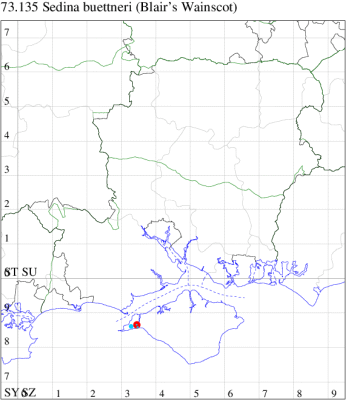
Records by year
Records by week (adult)
Records by week (larval)
Record Details
VC10: Afton Marsh, one, 28 Sep (IOu)
73.136 [B&F: 2369] Bulrush Wainscot Nonagria typhae (Thunberg, 1784) - Common
Common in fens, reed-beds and marshes throughout much of the British Isles. In Hampshire and on the Isle of Wight probably occurs wherever Bulrush Typha grows in numbers. Wingspan 40-54 mm. Similar to Large Wainscot Rhizedra lutosa but shows a subterminal row of interneural dots or short, wedge-shaped streaks. Moths taken at light away from known breeding locations are invariably wandering females. Larva feeds on Bulrush, over-wintering as an egg.
Records prior to 2020
| Vice County | #Records | #Individuals | First Record | Last Record |
|---|---|---|---|---|
| 10 | 19 | 11 | 1950 | 2019 |
| 11 | 321 | 281 | 1951 | 2019 |
| 12 | 102 | 82 | 1951 | 2017 |
2020 records
| Vice County | #Records | #Individuals | Max Quantity |
|---|---|---|---|
| 10 | 1 | 1 | 1 |
| 11 | 5 | 8 | 4 |
| 12 | 3 | 3 | 1 |
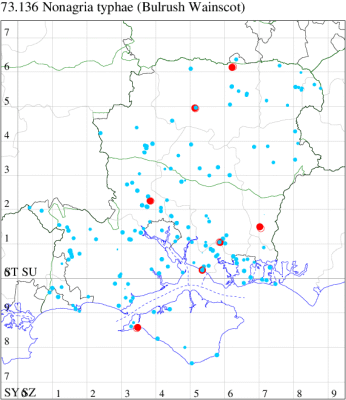
Records by year
Records by week (adult)
Records by week (larval)
Record Details
VC10: Freshwater Cliffs, one, 08 Sep (SDa);
VC11: Romsey, one, 16 Jul (NRJ); Titchfield Haven NNR, four, ♂s, 17 Jul (F.M.G.); Wickham Common, one, 20 Aug (KC); Wickham, one, 11 Aug (JRDS); Horndean, one, to actinic, 08 Aug (PHog);
VC12: Overton, one, 16 Sep (MSi); Pamber Forest, one, 15 Aug (GJD)
73.137 [B&F: 2377] Fen Wainscot Arenostola phragmitidis (Hübner, [1803]) - Local
Local in and around reed-beds, from Dorset to Yorkshire, and in Lancashire and Cumbria. Locally distributed in Hampshire, principally on the south-east coast, and inland from the upper Test valley and the lower Avon. Quite scarce on the Isle of Wight, but now annual in small numbers. Wanderers can occur far from suitable habitat. Wingspan 32-36 mm. The smooth creamy appearance of the forewing, darker towards the termen, precludes confusion with any other species (MBGBI Vol 10). Larva feeds on Common Reed.
Records prior to 2020
| Vice County | #Records | #Individuals | First Record | Last Record |
|---|---|---|---|---|
| 10 | 88 | 113 | 1902 | 2019 |
| 11 | 595 | 890 | 1951 | 2019 |
| 12 | 99 | 170 | 1951 | 2019 |
2020 records
| Vice County | #Records | #Individuals | Max Quantity |
|---|---|---|---|
| 10 | 1 | 1 | 1 |
| 11 | 13 | 52 | 29 |
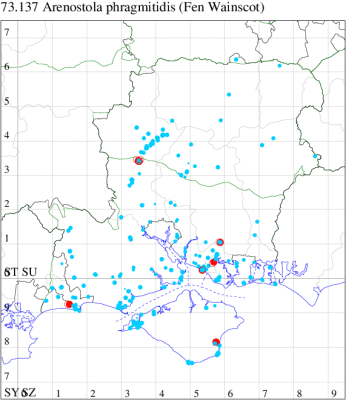
Records by year
Records by week (adult)
Records by week (larval)
Record Details
VC10: Shanklin, one, 17 Jul (IOu);
VC11: Houghton, one, to actinic, 24 Jul; one, to actinic, 24 Jul; Stockbridge Down NT, three, to actinic, 24 Jul; four, to actinic, 24 Jul; three, to actinic, 24 Jul; six, to actinic, 24 Jul (GCE); Hamble, one, to actinic, 13 Aug (PLyw); Titchfield Haven NNR, 29, 17 Jul (F.M.G.); Fareham, one, 16 Jul (ADT); Wickham Common, one, 17 Jul (KC); Northney, Hayling Island, present, 16 Jul (JWP); Tuckton, Bournemouth, one, not verified, 14 Jun (APar)
73.139 [B&F: 2370] Twin-spotted Wainscot Lenisa geminipuncta (Haworth, 1809) - Local
Local in reed-beds, marshes, fens and gardens throughout much of southern and eastern England, generally most frequent by the coast. In Hampshire and on the Isle of Wight locally abundant in reed-beds, especially those along the coast at Keyhaven, Lower Test and Titchfield Haven, and extending inland along the valleys of the Avon, Test and Itchen. Wingspan 28-37 mm. Characterised by the narrow reniform stigma, with a small white dot in each half, or sometimes only in dorsal half, and minute orbicular stigma (MBGBI Vol 10). Larva feeds on Common Reed, over-wintering as an egg.
Records prior to 2020
| Vice County | #Records | #Individuals | First Record | Last Record |
|---|---|---|---|---|
| 10 | 27 | 28 | 1950 | 2018 |
| 11 | 241 | 251 | 1951 | 2019 |
| 12 | 47 | 42 | 1951 | 2019 |
2020 records
| Vice County | #Records | #Individuals | Max Quantity |
|---|---|---|---|
| 10 | 1 | 2 | 2 |
| 11 | 4 | 3 | 2 |
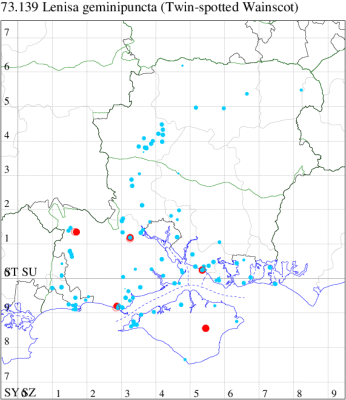
Records by year
Records by week (adult)
Records by week (larval)
Record Details
VC10: Haseley Manor, two, one retained and examined, 11 Aug (IOu);
VC11: Ditchend Brook, Newfoundland, NF, present, 30 Jul (RBW, MWa); Woodlands, New Forest, present, 30 Jul (RBW); Titchfield Haven NNR, two, 17 Jul (F.M.G. det. KJW); Milford on Sea, one, 10 Aug (MMcM)
73.141 [B&F: 2371] Brown-veined Wainscot Archanara dissoluta (Treitschke, 1825) - Local
Local in reed-beds, marshes, river-banks, fens and gardens throughout much of south-east England, discontinuously north to Lancashire and north-west Wales. In Hampshire and on the Isle of Wight present in most reed-beds, especially on the coast. Wingspan 27-33 mm. The main confusion species is White-mantled Wainscot A. neurica, but A. dissoluta has small black central spot on the underside of both hindwing and forewing, absent in A. neurica. Larva feeds on Common Reed, over-wintering as an egg and pupating low down in the stem of the foodplant, head downwards.
Records prior to 2020
| Vice County | #Records | #Individuals | First Record | Last Record |
|---|---|---|---|---|
| 10 | 21 | 20 | 1946 | 2018 |
| 11 | 286 | 327 | 1951 | 2019 |
| 12 | 47 | 38 | 1951 | 2018 |
2020 records
| Vice County | #Records | #Individuals | Max Quantity |
|---|---|---|---|
| 10 | 2 | 2 | 1 |
| 11 | 1 | 1 | 1 |
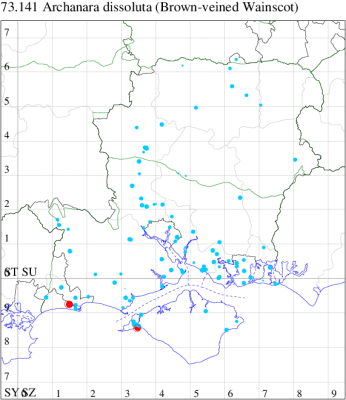
Records by year
Records by week (adult)
Records by week (larval)
Record Details
VC10: Freshwater Cliffs, one, 16 Jul; one, 09 Aug (SDa);
VC11: Tuckton, Bournemouth, one, 30 Jul (APar)
73.142 [B&F: 2379] Small Rufous Coenobia rufa (Haworth, 1809) - Local
Local in fens, damp meadows, bogs and damp grassland throughout much of England, Wales and southern Scotland. In Hampshire and on the Isle of Wight widespread but local in bogs and marshes, most common in the New Forest. Wingspan 22-25 mm. Could be confused with Small Dotted Buff Photedes minima, however in Small Rufous the hindwing is always paler than the forewing. Larva feeds on Jointed Rush, Soft-rush and Rush.
Records prior to 2020
| Vice County | #Records | #Individuals | First Record | Last Record |
|---|---|---|---|---|
| 10 | 31 | 40 | 1950 | 2019 |
| 11 | 517 | 576 | 1951 | 2019 |
| 12 | 74 | 60 | 1951 | 2018 |
2020 records
| Vice County | #Records | #Individuals | Max Quantity |
|---|---|---|---|
| 10 | 7 | 50 | 29 |
| 11 | 39 | 51 | 3 |
| 12 | 8 | 8 | 1 |
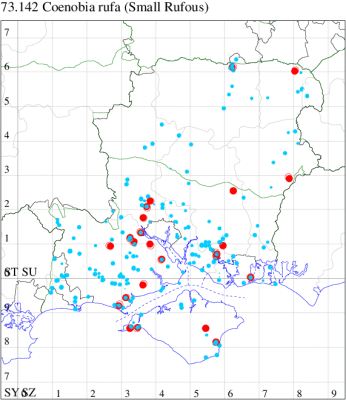
Records by year
Records by week (adult)
Records by week (larval)
Record Details
VC10: West High Down Quarry, three, 07 Aug (IOu); Freshwater Cliffs, four, 09 Aug (SDa); Haseley Manor, 29, 11 Aug; Shanklin, one, 17 Jul; one, 02 Aug; one, 06 Aug; 11, 09 Aug (IOu);
VC11: Acres Down, one, 08 Aug (CWlk); Marchwood, one, 29 Jul (CTh); Woodlands, New Forest, present, 09 Aug (RBW); Ashurst, NF, one, 31 Jul (SAB); Totton, one, 08 Aug; three, 09 Aug; one, 10 Aug (LH); Lee, three, 08 Aug (CTh); Romsey, one, 08 Aug (MB); one, 12 Aug; one, 15 Aug (NRJ); Dibden Purlieu, one, to actinic, 12 Aug; one, to actinic, 13 Aug (RAC); Southampton, one, 11 Aug (MEdg); Fareham, one, to actinic, 09 Aug (MLO); one, 09 Aug (KJW); Wickham, one, 07 Aug (F.M.G.); Bishop's Waltham., one, 31 Jul (CMor); Wickham, three, 05 Aug; one, 06 Aug; two, 07 Aug; one, 08 Aug; one, 09 Aug; three, 10 Aug; two, 11 Aug; one, 17 Aug (JRDS); Portsmouth, one, 09 Aug (IRT); Lovedean, one, 11 Aug (ARJ); West Meon, one, 31 Jul (F.M.G.); Milford on Sea, one, 07 Aug (MMcM); Pennington, one, 07 Aug; two, 10 Aug; one, 13 Aug (RFC); Norleywood, NF, present, 09 Aug (RBW, MWa);
VC12: Cheriton*, one, to actinic, 10 Aug (DAS); Pamber Forest, one, 31 Jul; one, 07 Aug; one, 10 Aug; one, 13 Aug (GJD); Liss Forest, one, 08 Aug (RJM); Yateley*, one, to actinic, ♀, gen det, 31 Jul; one, 07 Aug (JHH)
73.144 [B&F: 2350] Small Wainscot Denticucullus pygmina (Haworth, 1809) - Common
Common in fens, marshes, river-banks, damp woodland and gardens throughout the British Isles. Locally common in marshes in Hampshire and on the Isle of Wight, with occasional wanderers appearing at light elsewhere. Wingspan 22-25 mm. Small size and dark suffusion on veins make this an easy species to recognise. Larva feeds on Lesser Pond-sedge, Glaucous Sedge, Rough Meadow-grass and other grasses.
Records prior to 2020
| Vice County | #Records | #Individuals | First Record | Last Record |
|---|---|---|---|---|
| 10 | 20 | 10 | 1856 | 2018 |
| 11 | 820 | 1029 | 1946 | 2019 |
| 12 | 314 | 471 | 1951 | 2019 |
2020 records
| Vice County | #Records | #Individuals | Max Quantity |
|---|---|---|---|
| 11 | 30 | 34 | 3 |
| 12 | 23 | 44 | 6 |
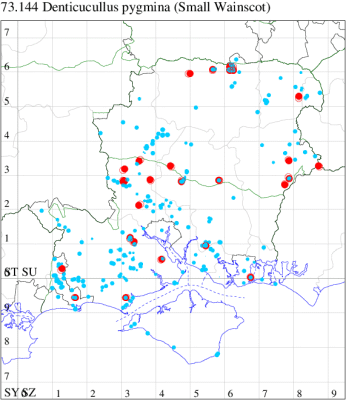
Records by year
Records by week (adult)
Records by week (larval)
Record Details
VC11: Brockwood, one, 14 Aug; one, 22 Aug; two, 12 Sep; one, 19 Sep (SDut); Woodlands, New Forest, present, 25 Jul (RBW); Ashurst, NF, one, 15 Sep (SAB); East Tytherley, three, to actinic, 10 Aug; one, to actinic, 10 Aug; two, to actinic, 10 Aug; one, to actinic, 10 Aug; one, to actinic, 10 Aug; one, to actinic, 14 Sep; one, to actinic, 14 Sep (GCE); Romsey, one, 31 Jul (SC); Kings Somborne, one, to actinic, 03 Sep; Broughton, one, to actinic, 06 Aug; Stockbridge Down NT, one, to actinic, 24 Jul (GCE); Dibden Purlieu, one, 27 Aug; one, 29 Aug (RAC); Hamble, one, to actinic, 13 Aug (PLyw); Winchester, one, 31 Jul (THW); Botley Wood, one, 18 Sep (F.M.G.); Portsmouth, one, 08 Aug (IRT); Burton, nr Christchurch, one, 10 Jul; two, 23 Jul (JSw); Pennington, one, 07 Aug; one, 26 Aug; one, 20 Sep (RFC);
VC12: Crawley, one, to actinic, 26 Aug (GCE); Ecchinswell, one, to actinic, 15 Aug (MTa, CSu); Cheriton, one, to actinic, 07 Aug (DAS); Axmansford, two, 16 Aug (ACB); Pamber Forest, four, 02 Sep; two, 14 Sep; one, 06 Aug; three, 31 Jul; two, 06 Aug; one, 10 Aug; three, 13 Aug; two, 15 Aug; three, 26 Aug; two, 07 Sep; one, 14 Sep; two, 21 Sep; two, 28 Sep; six, 07 Sep (GJD); Liss, one, 29 Aug (LBe); Liss Forest, one, 29 Aug (RJM); Whitehill, one, to actinic, 31 Jul (ASto); Hammer Vale, Woolmer, one, 03 Sep (ASw); Fleet, one, 11 Aug (MHals)
73.147 [B&F: 2345] Small Dotted Buff Photedes minima (Haworth, 1809) - Common
Common in damp grassland, woodland rides, marshes, river-banks and other damp areas throughout the British Isles; reasonably well distributed and common throughout Hampshire and on the Isle of Wight. Wingspan male 25-30 mm, female 20-24 mm. Small size and relatively plain appearance may admit confusion with faded examples of similar sized moths. Larva feeds on Tufted Hair-grass.
Records prior to 2020
| Vice County | #Records | #Individuals | First Record | Last Record |
|---|---|---|---|---|
| 10 | 140 | 142 | 1981 | 2018 |
| 11 | 900 | 987 | 1951 | 2019 |
| 12 | 337 | 371 | 1951 | 2019 |
2020 records
| Vice County | #Records | #Individuals | Max Quantity |
|---|---|---|---|
| 11 | 21 | 29 | 4 |
| 12 | 4 | 3 | 1 |
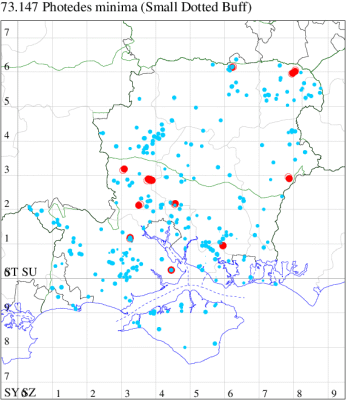
Records by year
Records by week (adult)
Records by week (larval)
Record Details
VC11: Woodlands, New Forest, present, 07 Jun (RBW); Romsey, one, 31 Jul (SC); Kings Somborne, one, to actinic, 09 Jul; four, to actinic, 09 Jul; one, to actinic, 11 Jun; one, to actinic, 09 Jul; two, to actinic, 11 Jun; three, to actinic, 09 Jul; four, to actinic, 11 Jun; one, to actinic, 11 Jun; one, to actinic, 09 Jul; one, to actinic, 11 Jun; one, to actinic, 09 Jul; Broughton, one, to actinic, 06 Aug (GCE); Blackfied, one, to lighted window, ♂, 31 Jul (PGS); Allbrook, one, 15 Jul (SI); Wickham, one, 07 Aug (F.M.G.); one, 22 Jul (JRDS); Sway, one, 25 Jun (SKe);
VC12: Pamber Forest, one, 13 Jul (GJD); Warren Hill, Liss Forest, one, 04 Jul (RJM); Castle Bottom NNR, present, 25 Jun (JHH, AMD); Yateley*, one, 31 Jul (JHH)
73.151 [B&F: 2373] Webb's Wainscot Globia sparganii (Esper, 1789) - Nb
Nationally scarce (Nb) in reed-beds, marshes and gravel pits, on the coasts of southern England from Scilly to Lincolnshire. In Hampshire and on the Isle of Wight locally common in the marshes in the south of the county and on the Island, but only recorded once in the north of the county, at Bramshill Plantation in July 2006. Wingspan 34-44 mm. The most likely confusion species is Rush Wainscot A. algae, but in Webb's Wainscot the postmedian line is usually more conspicuous, and represented by about seven neural dots absent in Rush Wainscot (MBGBI Vol 10). Larva feeds on Bulrush, Lesser Bulrush, Yellow Iris and Branched Bur-reed, over-wintering as an egg.
Records prior to 2020
| Vice County | #Records | #Individuals | First Record | Last Record |
|---|---|---|---|---|
| 10 | 48 | 40 | 1900 | 2019 |
| 11 | 359 | 409 | 1900 | 2019 |
| 12 | 7 | 7 | 2006 | 2019 |
2020 records
| Vice County | #Records | #Individuals | Max Quantity |
|---|---|---|---|
| 10 | 4 | 10 | 6 |
| 11 | 14 | 17 | 4 |
| 12 | 1 | 1 | 1 |
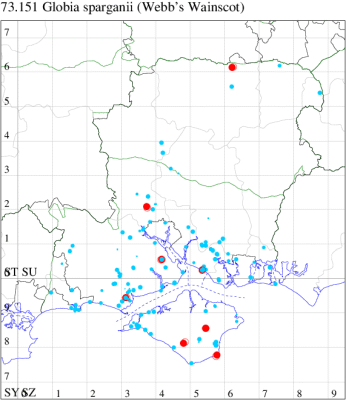
Records by year
Records by week (adult)
Records by week (larval)
Record Details
VC10: Kingston*, one, 05 Sep (CHer); Bonchurch, one, 13 Aug (JHa); Haseley Manor, two, 06 Jul; six, 11 Aug (IOu);
VC11: Romsey, one, 08 Aug (MB); Dibden Purlieu, one, 14 Sep; one, to actinic, 24 Jul; one, to actinic, 13 Aug; one, 22 Aug; one, 23 Aug (RAC); Titchfield Haven NNR, four, 17 Jul (F.M.G.); Pennington, one, 05 Aug (RFC);
VC12: Pamber Forest*, one, 07 Aug (GJD)
73.154 [B&F: 2330] Dusky Brocade Apamea remissa (Hübner, [1809]) - Common
Common in damp meadows, calcareous grassland, gardens, hedgerows and open woodland throughout the British Isles, a species of conservation concern under the UK Biodiversity Action Plan. Widespread and still moderately common in Hampshire and on the Isle of Wight. Wingspan 36-42 mm. Very variable, with several forms, some of which could be confused with a number of other species, including Dark Brocade Blepharita adusta and Light Brocade Lacanobia w-latinum. Larva feeds on flowers and seeds of various grasses, including Reed Canary-grass and Common Couch.
Records prior to 2020
| Vice County | #Records | #Individuals | First Record | Last Record |
|---|---|---|---|---|
| 10 | 119 | 144 | 1951 | 2019 |
| 11 | 1389 | 2045 | 1951 | 2019 |
| 12 | 285 | 274 | 1951 | 2019 |
2020 records
| Vice County | #Records | #Individuals | Max Quantity |
|---|---|---|---|
| 10 | 5 | 10 | 5 |
| 11 | 22 | 22 | 2 |
| 12 | 4 | 4 | 1 |

Records by year
Records by week (adult)
Records by week (larval)
Record Details
VC10: Kingston, two, 17 Jun; five, 22 Jun (ENes); Bonchurch, one, 15 Jun (JHa); Rookley, one, to actinic, 05 Jul; one, to actinic, 10 Jul (JBa);
VC11: Woodlands, New Forest, present, 07 Jul (RBW); Ashurst, NF, one, 24 Jun (SAB); Romsey, one, 19 Jun (MB); Kings Somborne, two, to actinic, 09 Jul; Hursley, one, to actinic, 09 Jul (GCE); Southampton, one, to UV, 01 Jul (JVet); Eastleigh, one, to actinic, 12 Jun (KArb); Locks Heath, one, 09 Jun (PAS); Fareham, one, 13 Jun; one, 25 Jun; one, 30 Jun (KJW); Botley, one, to actinic, 14 Jun; one, to actinic, 20 Jun; one, to actinic, 14 Jun; one, to actinic, 17 Jun; one, to actinic, 18 Jun (SLB); Wickham, one, 13 Jun (JRDS); Lovedean, one, 31 May; one, 24 Jun; one, 29 Jun (ARJ); Pilley Bailey, NF, one, 07 Jul (RBW, MWa);
VC12: Basingstoke, one, 08 Aug (RHil); Pamber Forest, one, 25 Jun (GJD); Liss, one, 29 May (LBe); Whitehill, one, to actinic, 04 Jul (ASto)
73.155 [B&F: 2327] Clouded Brindle Apamea epomidion (Haworth, 1809) - Common
Common in broad-leaved woodland, scrub, parks and gardens throughout much of England and Wales. In Hampshire and on the Isle of Wight Widespread and fairly common in all three vice-counties, though generally less so than A. crenata, and more of a woodland species. Wingspan 40-46 mm. Pale examples could be confused with Clouded-bordered Brindle A. crenata. Larva feeds on various grasses, including Cock's-foot and Tufted Hair-grass.
Records prior to 2020
| Vice County | #Records | #Individuals | First Record | Last Record |
|---|---|---|---|---|
| 10 | 127 | 153 | 1951 | 2019 |
| 11 | 676 | 755 | 1951 | 2019 |
| 12 | 395 | 521 | 1951 | 2019 |
2020 records
| Vice County | #Records | #Individuals | Max Quantity |
|---|---|---|---|
| 10 | 7 | 7 | 1 |
| 11 | 41 | 46 | 5 |
| 12 | 29 | 44 | 3 |
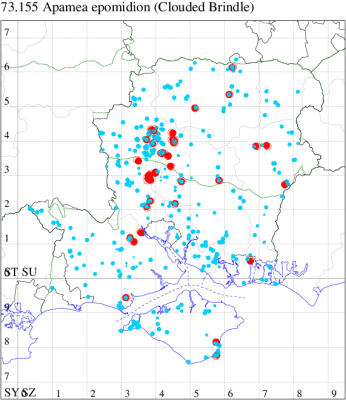
Records by year
Records by week (adult)
Records by week (larval)
Record Details
VC10: Bonchurch, one, 30 May; one, 08 Jun; one, 20 Jun; one, 24 Jun; one, 25 Jun; one, 12 Jul (JHa); Shanklin, one, 12 Jul (IOu);
VC11: Woodlands, New Forest, present, 19 Jun (RBW); Ashurst, NF, one, 07 Jun (SAB); Totton, one, 28 May; one, 23 Jun (LH); Romsey, one, 19 Jun (MB); Kings Somborne, one, to actinic, 09 Jul; one, to actinic, 23 Jun; Ashley, one, to actinic, 23 Jun; Kings Somborne, one, to actinic, 11 Jun; five, to actinic, 23 Jun; Ashley, one, to actinic, 23 Jun (GCE); Romsey, one, 15 Jun; one, 04 Jul (NRJ); Kings Somborne, two, to actinic, 09 Jul; one, to actinic, 11 Jun; Houghton, one, to actinic, 19 Jun; Ashley, one, to actinic, 23 Jun; Kings Somborne, two, to actinic, 15 Jun; one, to actinic, 15 Jun; one, to actinic, 15 Jun; one, to actinic, 15 Jul (GCE); Allbrook, one, 18 May; one, 14 Jun; one, 15 Jun; one, 16 Jun; one, 22 Jun; two, 23 Jun; one, 24 Jun (SI); Winchester, one, 29 May (THW); Drayton, Portsmouth, present, 11 Jun (VJB); Lovedean, one, 15 Jun (ARJ); Northney, Hayling Island, present, 17 Jun (JWP); Pennington, one, 17 Jun (RFC);
VC12: Cholderton, one, 10 Jul (TJN, HE); Chilbolton, one, to actinic, 02 Jul; Wherwell, one, to actinic, 29 Jun; Harewood Forest, three, to actinic, 24 Jun; two, to actinic, 24 Jun; two, to actinic, 24 Jun; Chilbolton, two, to actinic, 16 Jun; two, to actinic, 16 Jun; one, to actinic, 14 Jul; three, to actinic, 16 Jun; one, to actinic, 14 Jul; one, to actinic, 16 Jun; Crawley, one, to actinic, 21 Jul; one, to actinic, 09 Jun; Barton Stacey, three, to actinic, 22 Jun; one, to actinic, 27 May; two, to actinic, 22 Jun; one, to actinic, 22 Jun; one, to actinic, 25 Jun; one, to actinic, 22 Jun; three, to actinic, 22 Jun (GCE); Cheriton, two, to actinic, 24 Jun (DAS); Overton, one, 25 Jun (MSi); Beech, one, 23 Jun (NDP); Basingstoke, two, 26 Jun (MJW); Pamber Forest, one, 17 Jun (GJD); Liss, one, 16 May (LBe); Alton, one, to actinic, 14 Jun; one, to actinic, 24 Jun (NDP)
73.156 [B&F: 2326] Clouded-bordered Brindle Apamea crenata (Hufnagel, 1766) - Common
Common in grassland, fens, moorland, woodland rides and gardens throughout the British Isles. Widespread and moderately common in Hampshire and on the Isle of Wight. Wingspan 36-44 mm. The common form could be confused with pale forms of Clouded Brindle A. epomidion, which see, while the reddish brown f. combusta may be misidentified as the rare immigrant Scarce Brindle A. lateritia. Larva feeds on Cock's-foot and various other grasses.
Records prior to 2020
| Vice County | #Records | #Individuals | First Record | Last Record |
|---|---|---|---|---|
| 10 | 96 | 97 | 1978 | 2019 |
| 11 | 833 | 831 | 1951 | 2019 |
| 12 | 628 | 1026 | 1951 | 2019 |
2020 records
| Vice County | #Records | #Individuals | Max Quantity |
|---|---|---|---|
| 10 | 3 | 3 | 1 |
| 11 | 18 | 17 | 2 |
| 12 | 20 | 20 | 2 |
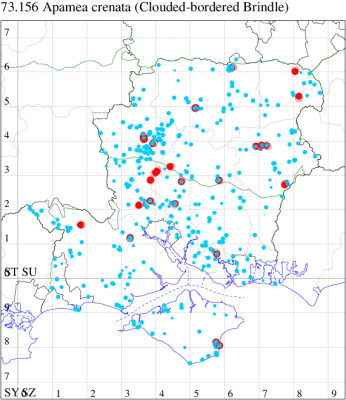
Records by year
Records by week (adult)
Records by week (larval)
Record Details
VC10: Shanklin, one, 20 May; one, 25 Jun; Shanklin Upper Chine, one, 21 May (IOu);
VC11: Godshill, NF, present, 12 Jul (RBW, MWa); Woodlands, New Forest, present, 04 May (RBW); Romsey, one, 22 May (SC); two, 15 May; one, 25 Jun (NRJ); Kings Somborne, one, to actinic, 21 May; one, to actinic, 15 Jun (GCE); Southampton, one, 25 May (MEdg); Eastleigh, one, to actinic, 12 May; one, to actinic, 21 May (KArb); Allbrook, one, 07 May (SI); Winchester, one, 09 Jun (THW); Kings Somborne, one, to actinic, 26 May (GCE); Fareham, one, 21 May (KJW); Wickham, one, 14 Jun; one, 29 Jun; one, 22 Jul (JRDS);
VC12: Chilbolton, one, to actinic, 21 May; Wherwell, one, to actinic, 15 May; two, to actinic, 15 May; one, to actinic, 15 May; Crawley, one, to actinic, 09 Jun (GCE); Cheriton, two, to actinic, 19 May (DAS); Overton, one, 10 May; one, 08 Jun; present, 26 Jun (MSi); one, 09 May (ACr); Beech, one, 25 May; one, 28 Jun (NDP); Pamber Forest, one, 10 Jun (GJD); Liss, one, 16 May (LBe); Alton, one, to actinic, 20 May; one, to actinic, 07 Jul (BCA); one, to actinic, 07 Jul (NDP); Fleet, one, 24 Jun (MHals); Yateley*, one, 26 May (JHH)
73.157 [B&F: 2333] Large Nutmeg Apamea anceps ([Denis & Schiffermüller], 1775) - Local
Local in calcareous grassland, farmland, gardens and woodland edges throughout England, mainly in the south-east, a species of conservation concern under the UK Biodiversity Action Plan. In Hampshire the species has shown a marked decrease in recent years and there are now only scattered records from the county; very rarely recorded on the Isle of Wight. Wingspan 38-44 mm. Fairly distinctive, with light ochreous forewing often longer and narrower than in other Apamea species; reniform and orbicular stigmata rounded, slightly paler than ground colour; pale cross-lines extremely weak; and a row of narrow blackish crescent marks along termen (MBGBI Vol 10). Larva feeds on the flowers and seeds of various grasses, including Cock's-foot and Common Couch, and of cereal crops.
Records prior to 2020
| Vice County | #Records | #Individuals | First Record | Last Record |
|---|---|---|---|---|
| 10 | 6 | 0 | 1856 | 1951 |
| 11 | 78 | 222 | 1945 | 2019 |
| 12 | 252 | 523 | 1948 | 2019 |
2020 records
| Vice County | #Records | #Individuals | Max Quantity |
|---|---|---|---|
| 11 | 1 | 1 | 1 |
| 12 | 4 | 4 | 1 |
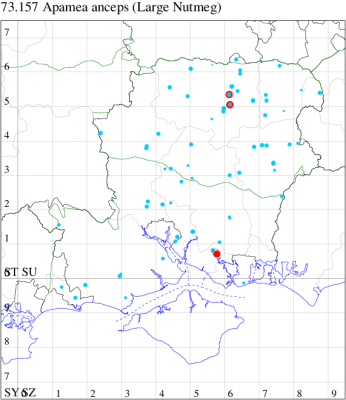
Records by year
Records by week (adult)
Records by week (larval)
Record Details
VC11: Fareham, one, ♂, 09 Jun (KJW);
VC12: Cholderton, one, 31 Jul (TJN, HE); Basingstoke, one, 16 Jun; one, 26 Jun (MJW); one, 26 May (RHil)
73.158 [B&F: 2334] Rustic Shoulder-knot Apamea sordens (Hufnagel, 1766) - Common
Common in grassland, farmland, gardens and woodland rides throughout the British Isles. In Hampshire and on the Isle of Wight some evidence of a decrease in numbers in recent years. Wingspan 34-42 mm. The conspicuous undulating black basal streak is highly distinctive and precludes confusion with most species (MBGBI Vol 10). Larva feeds on seeds and leaves of various grasses, including Cock's-foot and Common Couch, and some cereal crops.
Records prior to 2020
| Vice County | #Records | #Individuals | First Record | Last Record |
|---|---|---|---|---|
| 10 | 38 | 29 | 1951 | 2019 |
| 11 | 1447 | 2147 | 1951 | 2019 |
| 12 | 1483 | 4462 | 1951 | 2019 |
2020 records
| Vice County | #Records | #Individuals | Max Quantity |
|---|---|---|---|
| 10 | 1 | 1 | 1 |
| 11 | 97 | 111 | 3 |
| 12 | 44 | 55 | 4 |
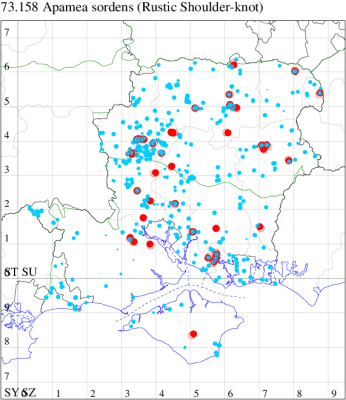
Records by year
Records by week (adult)
Records by week (larval)
Record Summary
VC10: Earliest: Rookley, 22 Jun, 1 (JBa) Max count: Rookley, 22 Jun, 1 (JBa)
VC11: Earliest: Marchwood, 28 May, 1 (CTh) Latest: Horndean, 06 Jun, 1 (P&AHo) Max count: Wickham, 25 May, 3 (JRDS)
VC12: Earliest: Broughton, 29 May, 1 (GCE) Latest: Yateley, 26 May, 1 (JHH) Max count: Basingstoke, 26 May, 4 (MJW)
73.159 [B&F: 2331] Small Clouded Brindle Apamea unanimis (Hübner, [1813]) - Common
Common in marshes, river-banks, damp woodland and damp grassland throughout most of Britain, but absent from northern Scotland. Widespread and moderately common in Hampshire, but very scarce on the Isle of Wight, where not seen since 1900. Wingspan 30-38 mm. Larva feeds on grasses such as Reed Canary-grass and Wavy Hair-grass.
Records prior to 2020
| Vice County | #Records | #Individuals | First Record | Last Record |
|---|---|---|---|---|
| 10 | 5 | 4 | 1900 | 2015 |
| 11 | 403 | 430 | 1951 | 2019 |
| 12 | 190 | 261 | 1951 | 2019 |
2020 records
| Vice County | #Records | #Individuals | Max Quantity |
|---|---|---|---|
| 11 | 2 | 3 | 2 |
| 12 | 1 | 0 | 0 |
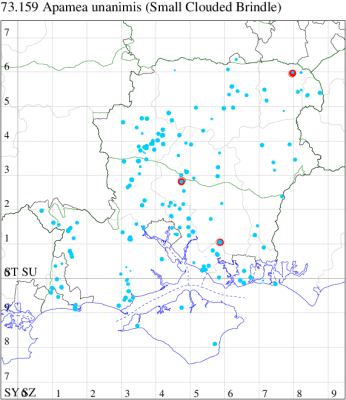
Records by year
Records by week (adult)
Records by week (larval)
Record Details
VC11: Winchester, two, 26 May (THW det. JCl); Wickham Common, one, 17 Jul (KC);
VC12: Castle Bottom NNR, present, 25 Jun (JHH, AMD)
73.160 [B&F: 2335] Slender Brindle Apamea scolopacina (Esper, 1788) - Local
Local in woodland throughout much of England and Wales. In Hampshire widespread and fairly common and is possibly increasing: 1990 saw the first Isle of Wight records, since which it is gradually increasing but cannot yet be said to be widespread in VC10. Wingspan 32-36 mm. Characterised by fuscous patch on dorsum near base of wing (MBGBI Vol 10). Larva feeds on flowers, stems and leaves of various grasses, including Wood Meadow-grass and False-brome.
Records prior to 2020
| Vice County | #Records | #Individuals | First Record | Last Record |
|---|---|---|---|---|
| 10 | 23 | 30 | 1981 | 2018 |
| 11 | 530 | 585 | 1951 | 2019 |
| 12 | 345 | 500 | 1951 | 2019 |
2020 records
| Vice County | #Records | #Individuals | Max Quantity |
|---|---|---|---|
| 11 | 14 | 20 | 4 |
| 12 | 13 | 20 | 4 |
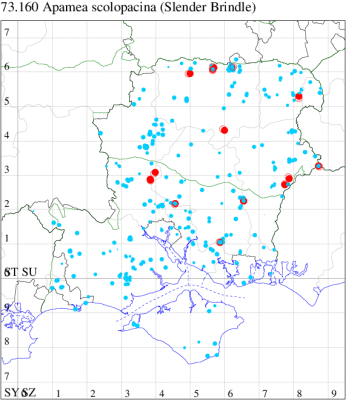
Records by year
Records by week (adult)
Records by week (larval)
Record Details
VC11: Kings Somborne, one, to actinic, 09 Jul; two, to actinic, 31 Jul; one, to actinic, 31 Jul; one, to actinic, 15 Jul (GCE); Allbrook, one, 04 Jul (SI); Wickham Common, one, 17 Jul (KC); Wickham, one, 11 Jul; two, 12 Jul; one, 13 Jul; one, 14 Jul; one, 18 Jul; two, 22 Jul (JRDS); Hen Wood, four, 24 Jul (F.M.G.); Petersfield, one, to actinic, 07 Jul (RAll);
VC12: Ecchinswell, one, to actinic, 27 Jul (MTa, CSu); Preston Candover, one, 12 Jul (MJW); Axmansford, one, 04 Jul; one, 23 Jul; four, 13 Jul (ACB); Pamber Forest, two, 01 Jul; two, 03 Jul; two, 24 Jul (GJD); Liss, one, 04 Jul (LBe); Liss Forest, one, 25 Jul (RJM); Hammer Vale, Woolmer, two, 16 Jul; one, 28 Jul (ASw); Fleet, one, 03 Jul (MHals)
73.161 [B&F: 2325] Crescent Striped Apamea oblonga (Haworth, 1809) - Nationally Scarce
Nationally scarce (Nb) on saltmarshes, mud-flats, estuaries and brackish marshes, along the coasts of England and Wales. In Hampshire confined to the coastal salterns on the south coast and the Isle of Wight, where it is locally fairly common; its headquarters appear to be on Hayling Island. Wingspan 42-50 mm. Larva feeds on roots and lower stems of Common Saltmarsh-grass, Reflexed Saltmarsh-grass and Bulbous Meadow-grass.
Records prior to 2020
| Vice County | #Records | #Individuals | First Record | Last Record |
|---|---|---|---|---|
| 10 | 25 | 20 | 1800 | 1991 |
| 11 | 104 | 130 | 1800 | 2015 |
2020 records
| Vice County | #Records | #Individuals | Max Quantity |
|---|---|---|---|
| 11 | 1 | 1 | 1 |
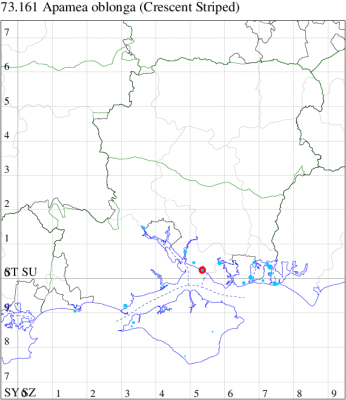
Records by year
Records by week (adult)
Records by week (larval)
Record Details
VC11: Titchfield Haven NNR, one, ♂, gen det, 17 Jul (F.M.G.)
73.162 [B&F: 2321] Dark Arches Apamea monoglypha (Hufnagel, 1766) - Common
Common often abundant, in a wide range of habitats, including gardens, hedgerows, roadside verges, woodland, heathland and moorland throughout the British Isles. Widespread and common in Hampshire and on the Isle of Wight. Wingspan 46-54 mm. Quite variable, with occasional very dark individuals, but so ubiquitous the species soon becomes easily recognisable. Larva feeds on various grasses, including Common Couch, Cock's-foot and Tufted Hair-grass.
Records prior to 2020
| Vice County | #Records | #Individuals | First Record | Last Record |
|---|---|---|---|---|
| 10 | 1504 | 11554 | 1951 | 2019 |
| 11 | 15874 | 67786 | 1951 | 2019 |
| 12 | 4618 | 25442 | 1951 | 2019 |
2020 records
| Vice County | #Records | #Individuals | Max Quantity |
|---|---|---|---|
| 10 | 114 | 504 | 29 |
| 11 | 955 | 2529 | 111 |
| 12 | 313 | 827 | 41 |
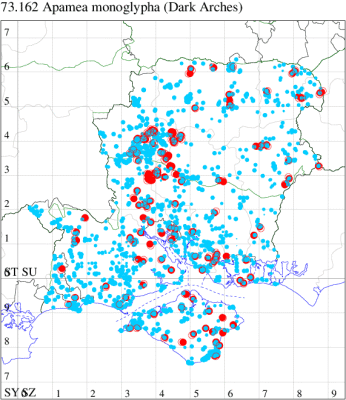
Records by year
Records by week (adult)
Records by week (larval)
Record Summary
VC10: Earliest: West High Down Quarry, 07 Aug, 10 (IOu) Latest: Bembridge Fort, 06 Aug, 3 (IOu) Max count: Kingston, 24 Jun, 29 (ENes)
VC11: Earliest: Brockwood, 13 Jun, 1 (SDut) Latest: Southsea, 01 Jun, 1 (JRL) Max count: Pennington, 17 Jun, 111 (RFC)
VC12: Earliest: Cholderton, 10 Jul, 3 (TJN, HE) Latest: Yateley, 17 Aug, 1 (JHH) Max count: Basingstoke, 20 Jun, 41 (MJW)
73.163 [B&F: 2322] Light Arches Apamea lithoxylaea ([Denis & Schiffermüller], 1775) - Common
Common in a wide range of habitats, including calcareous grassland, woodland rides and gardens throughout the British Isles. Widespread and fairly common in Hampshire and on the Isle of Wight. Wingspan 44-50 mm. Has been compared to Reddish Light Arches A. sublustris, but Light Arches appears lighter and better marked in comparison. Larva feeds on flowers and seeds of Annual Meadow-grass and other grasses.
Records prior to 2020
| Vice County | #Records | #Individuals | First Record | Last Record |
|---|---|---|---|---|
| 10 | 221 | 348 | 1951 | 2019 |
| 11 | 2194 | 3111 | 1949 | 2019 |
| 12 | 908 | 1352 | 1948 | 2019 |
2020 records
| Vice County | #Records | #Individuals | Max Quantity |
|---|---|---|---|
| 10 | 15 | 21 | 4 |
| 11 | 57 | 58 | 4 |
| 12 | 18 | 21 | 3 |
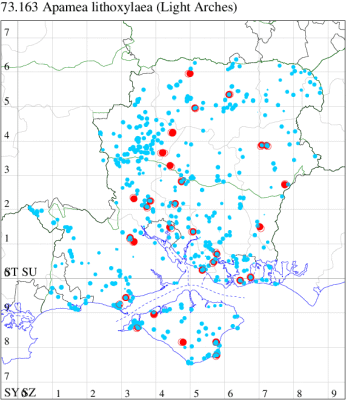
Records by year
Records by week (adult)
Records by week (larval)
Record Details
VC10: Freshwater Cliffs, one, 16 Jul (SDa); Cranmore, present, to actinic, 23 Apr (CHic); Kingston, one, 17 Jun; one, 22 Jun; four, 24 Jun; one, 28 Jun; one, 02 Jul (ENes); Bonchurch, one, 27 May; two, 30 May; one, 07 Jun; one, 15 Jun; two, 24 Jun; three, 25 Jun; one, 12 Jul (JHa); Shanklin, one, 05 Jul (IOu);
VC11: Woodlands, New Forest, present, 25 Jun (RBW); Ashurst, NF, one, 24 Jun (SAB); Stanbrige Earls, one, to actinic, 16 Jun (JRMi); Romsey, one, 07 Jun; one, 19 Jun (MB); one, 15 Jun (NRJ); Southampton, one, to actinic, 14 Jun (MEdg); one, to actinic, 22 Jun; one, to actinic, 23 Jun (MGP); Allbrook, one, 24 Jun (SI); Winchester, one, 27 Jun (THW); Titchfield Haven NNR, one, 17 Jul (F.M.G.); Fareham, one, 08 Jun; one, 24 Jun; one, 06 Jul (ADT); one, 25 Jun; one, 23 Jul (KJW); Botley, one, to actinic, 11 Jun; one, to actinic, 15 Jun; one, to actinic, 17 Jun; one, to actinic, 25 Jun; one, to actinic, 29 Jun; one, to actinic, 07 Jul; one, to actinic, 08 Jul; one, to actinic, 13 Jul; one, to actinic, 16 Jul (SLB); Shirrell Heath, one, 24 May (LEdg); Wickham, one, 28 Jun (JRDS); Portsmouth, one, 13 Jun; four, 18 Jun; one, 20 Jun; one, 21 Jun; three, 25 Jun; two, 26 Jun; one, 07 Jul; one, 08 Jul; one, 13 Jul (IRT); Northney, Hayling Island, present, 09 Jun; present, 19 Jun; present, 28 Jun; present, 07 Jul; present, 08 Jul (JWP); Horndean, one, to actinic, 19 Jun (P&AHo); two, to actinic, 24 Jun; one, to actinic, 04 Jul (PHog); Sway, one, 25 Jun (SKe); Milford on Sea, one, 25 Jun; one, 09 Jul (MMcM); Pennington, one, 24 Jun (RFC); Southsea, one, 21 Jun (JGe);
VC12: Cholderton, one, 24 Jul (TJN, HE); Chilbolton, one, to actinic, 14 Jul; one, to actinic, 16 Jun; Crawley, one, to actinic, 09 Jun (GCE); Harestock, one, to actinic, 09 Jul (GRog); Barton Stacey, one, to actinic, 25 Jun; one, to actinic, 25 Jun (GCE); Ecchinswell, one, to actinic, 15 Jun; one, to actinic, 10 Jul (MTa, CSu); Overton, one, 25 Jun (MSi); Basingstoke, one, 16 Jun; three, 20 Jun; two, 26 Jun (MJW); Liss, one, 25 Jun; one, 17 Jul (LBe); Alton, one, indoors, 08 Jul (BCA); one, to actinic, 15 Jun; one, to actinic, 24 Jun (NDP)
73.164 [B&F: 2323] Reddish Light Arches Apamea sublustris (Esper, 1788) - Local
Local on chalk and limestone grassland, sand-dunes and shingle beaches throughout England. In Hampshire locally common on the chalk and in places on the coast, well-known localities being Martin Down, Broughton Down, Danebury and other places on the chalk around Winchester, and Noar Hill. Relatively scarce on the Isle of Wight but increased effort has revealed it still occurs, particularly on the south-east coast. Wingspan 42-48 mm. The main confusion species is Light Arches A. lithoxylaea, which see. Larva feeds on flowers and seeds of various grasses.
Records prior to 2020
| Vice County | #Records | #Individuals | First Record | Last Record |
|---|---|---|---|---|
| 10 | 43 | 49 | 1856 | 2019 |
| 11 | 261 | 347 | 1800 | 2019 |
| 12 | 236 | 490 | 1948 | 2019 |
2020 records
| Vice County | #Records | #Individuals | Max Quantity |
|---|---|---|---|
| 10 | 4 | 4 | 1 |
| 11 | 4 | 5 | 2 |
| 12 | 7 | 8 | 2 |
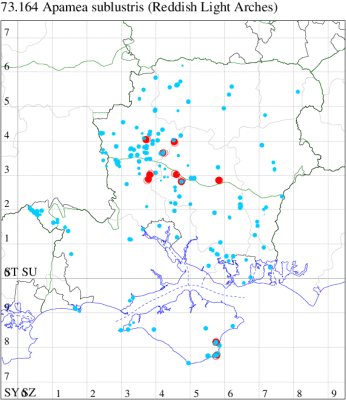
Records by year
Records by week (adult)
Records by week (larval)
Record Details
VC10: Bonchurch, one, 12 Jul; one, 13 Jul (JHa); Shanklin, one, 24 Jun; one, 25 Jun (IOu);
VC11: Kings Somborne, one, to actinic, 11 Jun; Ashley, one, to actinic, 23 Jun (GCE); Winchester, two, 19 Jun (THW); Teg Down, one, to actinic, 17 Jun (EmPe);
VC12: Cholderton, one, 10 Jul; two, 17 Jul; one, 24 Jul (TJN, HE); Wherwell, one, to actinic, 29 Jun; Chilbolton, one, to actinic, 16 Jun; Barton Stacey, one, to actinic, 12 Jul (GCE); Cheriton, one, to actinic, 24 Jun (DAS)
73.168 [B&F: 2336] Double Lobed Lateroligia ophiogramma (Esper, 1794) - Local
Local in fens, marshes, water meadows, damp woodland and gardens throughout much of the British Isles. In Hampshire and on the Isle of Wight local in marshes, where the larva feeds within Reed Canary-grass, and occasionally in gardens, where it uses various ornamental grasses. Wingspan 32-35 mm. Generally the easiest of the Apamea to identify. Larva feeds within stems of various grasses, including Reed Canary-grass, Reed Sweet-grass and Pampas-grass.
Records prior to 2020
| Vice County | #Records | #Individuals | First Record | Last Record |
|---|---|---|---|---|
| 10 | 31 | 31 | 1933 | 2019 |
| 11 | 530 | 825 | 1951 | 2019 |
| 12 | 260 | 711 | 1940 | 2019 |
2020 records
| Vice County | #Records | #Individuals | Max Quantity |
|---|---|---|---|
| 11 | 4 | 4 | 2 |
| 12 | 1 | 1 | 1 |
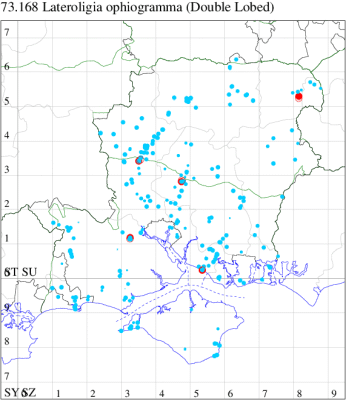
Records by year
Records by week (adult)
Records by week (larval)
Record Details
VC11: Woodlands, New Forest, present, 16 Jul (RBW); Stockbridge Down NT, one, to actinic, 24 Jul (GCE); Winchester, one, 07 Jul (THW); Titchfield Haven NNR, two, 17 Jul (F.M.G. det. KJW);
VC12: Fleet, one, 13 Jul (MHals)
73.169 [B&F: 2343] Common Rustic Mesapamea secalis (Linnaeus, 1758) - Local
Common in calcareous grassland, gardens, farmland, heathland and woodland throughout much of the British Isles. Only separated from M. didyma and M. remmi in the 1980s, and individuals are mostly recorded as an aggregate of the three species. In Hampshire and on the Isle of Wight widespread, but since most Mesapamea are not specifically identified, the maps do not reflect the full picture. Wingspan 28-34 mm. Highly polymorphic, and impossible to distinguish from Lesser Common Rustic M. didyma and Remm's Rustic M. remmi, except by dissection of the genitalia. Larva feeds on various grasses, including Cock's-foot, Tall Fescue, Tufted Hair-grass and certain cereal crops.
Records prior to 2020
| Vice County | #Records | #Individuals | First Record | Last Record |
|---|---|---|---|---|
| 10 | 75 | 129 | 1981 | 2018 |
| 11 | 2741 | 13827 | 1951 | 2019 |
| 12 | 251 | 1049 | 1970 | 2019 |
2020 records
| Vice County | #Records | #Individuals | Max Quantity |
|---|---|---|---|
| 10 | 2 | 2 | 1 |
| 11 | 25 | 25 | 5 |
| 12 | 14 | 35 | 7 |
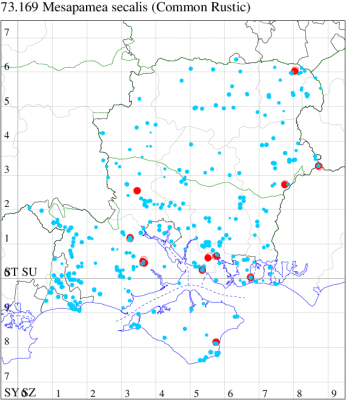
Records by year
Records by week (adult)
Records by week (larval)
Record Details
VC10: Shanklin, one, gen det, 16 Jun; one, gen det, 26 Jul (IOu);
VC11: Pig Bush, NF, four, 17 Jul; Culverley, NF, four, 19 Jul (CL); Woodlands, New Forest, present, 17 Jun (RBW); Timsbury, five, 12 Jul; three, 31 Jul (TRa); Titchfield Haven NNR, one, ♂ gen det, 17 Jul (F.M.G.); Catisfield, two, gen det, 16 Jul (ALR det. KJW); Fareham, one, to actinic, gen det, 21 Jun; one, to actinic, 15 Jul (MLO); Portsmouth, one, gen det, 22 Jul (IRT); Northney, Hayling Island, present, 19 Jun; present, 20 Jun; present, 26 Jun; present, 02 Jul; present, 03 Jul; present, 04 Jul; present, 05 Jul; present, 06 Jul; present, 07 Jul; present, 08 Jul; present, 08 Jul; present, 09 Jul; present, 10 Jul (JWP);
VC12: Liss, one, 10 Jul; four, 17 Jul; five, 31 Jul; seven, 07 Aug; two, 14 Aug; one, 29 Aug (LBe); Alton, one, 10 Jul; Lower Froyle, one, 11 Aug (EFig); Hammer Vale, Woolmer, two, 24 Jul; one, 30 Jul; three, 01 Aug; two, 17 Aug (ASw); Yateley, four, 3 ♂s, 1 ♀, gen det, 13 Aug (JHH)
73.170 [B&F: 2343a] Lesser Common Rustic Mesapamea didyma (Esper, 1788) - Common
Common in calcareous grassland, gardens, farmland, heathland and woodland throughout much of the British Isles. Only separated from M. secalis and M. remmi in the 1980s, and individuals are mostly recorded as an aggregate of the three species. In Hampshire and on the Isle of Wight distinctly less common than M. secalis, but since most Mesapamea are not specifically identified, the maps do not reflect the full picture. Wingspan 28-34 mm. Highly polymorphic, and impossible to distinguish from Common Rustic M. secalis and Remm's Rustic M. remmi, except by dissection of the genitalia. Larva feeds on various grasses, including Cock's-foot, Red Fescue, Sheep's-fescue, Tall Fescue and certain cereal crops.
Records prior to 2020
| Vice County | #Records | #Individuals | First Record | Last Record |
|---|---|---|---|---|
| 10 | 15 | 5 | 1981 | 2017 |
| 11 | 451 | 594 | 1951 | 2019 |
| 12 | 56 | 50 | 1981 | 2019 |
2020 records
| Vice County | #Records | #Individuals | Max Quantity |
|---|---|---|---|
| 10 | 1 | 1 | 1 |
| 11 | 5 | 5 | 1 |
| 12 | 4 | 5 | 2 |
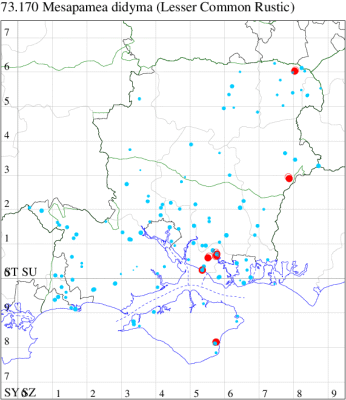
Records by year
Records by week (adult)
Records by week (larval)
Record Details
VC10: Shanklin, one, gen det, 26 Jul (IOu);
VC11: Titchfield Haven NNR, one, ♂, gen det, 17 Jul (F.M.G.); Catisfield, one, 12 Aug (ALR det. KJW); Fareham, one, to actinic, gen det, 23 Aug (MLO det. RJD); one, ♂, gen det, 15 Jul (KJW);
VC12: Liss Forest, one, 01 Aug (RJM); Alton, one, 28 Jul; one, 20 Aug (EFig); Yateley, two, to actinic, 2 ♂ gen det, 31 Jul (JHH)
73.171 [B&F: 2342] Rosy Minor Litoligia literosa (Haworth, 1809) - Common
Common in calcareous grassland, fens, scrub, gardens, sea cliffs and sand-dunes throughout much of the British Isles, a species of conservation concern under the UK Biodiversity Action Plan. In Hampshire and on the Isle of Wight found mainly on the coast and on the chalk downs, where it is less frequent than Cloaked Minor M. furuncula. Wingspan 25-30 mm. Characterised by rosy light grey forewing, bisected by a straight transverse line immediately basal to the reniform stigma, the area between this and antemedian line purplish brown forming a distinct median band (MBGBI Vol 10). Larva feeds on various grasses, including Lyme-grass, Marram-grass, Cock's-foot and some cereal crops.
Records prior to 2020
| Vice County | #Records | #Individuals | First Record | Last Record |
|---|---|---|---|---|
| 10 | 63 | 89 | 1943 | 2019 |
| 11 | 1000 | 1522 | 1951 | 2019 |
| 12 | 210 | 218 | 1951 | 2019 |
2020 records
| Vice County | #Records | #Individuals | Max Quantity |
|---|---|---|---|
| 10 | 8 | 11 | 3 |
| 11 | 18 | 20 | 2 |
| 12 | 7 | 8 | 2 |
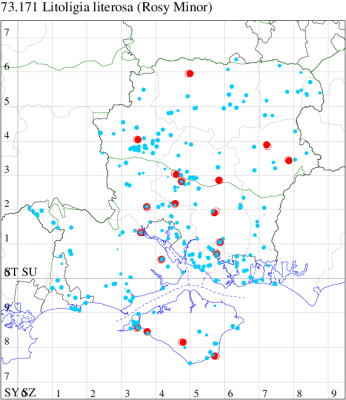
Records by year
Records by week (adult)
Records by week (larval)
Record Details
VC10: Freshwater Cliffs, three, 03 Aug; two, 09 Aug (SDa); Shippards Chine, Compton Bay, one, 16 Jul (IOu); Kingston, one, 16 Jul; one, 22 Jul; one, 29 Jul; one, 01 Aug (ENes); Wheelers Bay, one, 08 Aug (ABu);
VC11: Totton, one, 31 May; one, 22 Jun (LH); Romsey, one, 08 Aug (MB); Dibden Purlieu, one, to actinic, 07 Aug; one, to actinic, 09 Aug; one, to actinic, 14 Aug (RAC); Allbrook, one, 30 Jul (SI); Winchester, one, 31 Jul (THW); Teg Down, one, to actinic, 11 Aug (EmPe); Fareham, one, 05 Aug (KJW); Hilltop, The Hangers, two, 01 Aug (SI); Wickham Common, one, 09 Aug (KC);
VC12: Cholderton, one, 24 Jul (TJN, HE); Anna Valley, Andover, one, 20 Jul (TJN); Goodworth Clatford, one, to actinic, 19 Jul (GCE); Ecchinswell, one, to a lighted window, 01 Jun (MTa, CSu); Cheriton, one, to actinic, 16 Jul (DAS); Alton, two, to actinic, 04 Aug (CJP); Whitehill, one, 23 Jul (ASto)
73.172 [B&F: 2341] Cloaked Minor Mesoligia furuncula ([Denis & Schiffermüller], 1775) - Common
Common in dry grassland, sand-dunes, chalk downland and gardens throughout the British Isles. Widespread and common in Hampshire and on the Isle of Wight. Wingspan 22-28 mm. Generally easy to recognise on account of the straight line which bisects the forewing, and often coloured differently either side of this line, but in a fairly common variant the wing is concolorous. Larva feeds on various grasses, including Sheep's-fescue, Tufted Hair-grass and False Oat-grass.
Records prior to 2020
| Vice County | #Records | #Individuals | First Record | Last Record |
|---|---|---|---|---|
| 10 | 132 | 199 | 1951 | 2019 |
| 11 | 2917 | 4855 | 1949 | 2019 |
| 12 | 1093 | 2140 | 1951 | 2019 |
2020 records
| Vice County | #Records | #Individuals | Max Quantity |
|---|---|---|---|
| 10 | 18 | 57 | 16 |
| 11 | 279 | 504 | 10 |
| 12 | 117 | 322 | 20 |
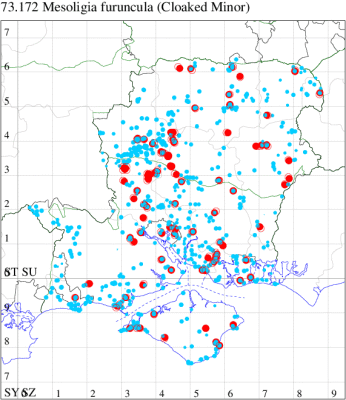
Records by year
Records by week (adult)
Records by week (larval)
Record Summary
VC10: Earliest: West High Down Quarry, 07 Aug, 5 (IOu) Latest: Bembridge Fort, 06 Aug, 16 (IOu) Max count: Bembridge Fort, 06 Aug, 16 (IOu)
VC11: Earliest: Woodlands, New Forest, 24 Jul, 0 (RBW) Latest: Southsea, 13 Aug, 2 (JGe) Max count: Hilltop, The Hangers, 01 Aug, 10 (SI)
VC12: Earliest: Cholderton, 17 Jul, 2 (TJN, HE) Latest: Yateley, 17 Aug, 1 (JHH) Max count: Cholderton, 08 Aug, 20 (TJN, HE)
73.173 [B&F: 2337] Marbled Minor Oligia strigilis (Linnaeus, 1758) - Common
Common in grassland, woodland rides, gardens and a wide range of other habitats throughout much of the British Isles. In Hampshire and on the Isle of Wight widespread and common in all three vice-counties. Wingspan 24-27 mm. Marbled Minor O. strigilis, Rufous Minor O. versicolor and Tawny Marbled Minor O. latruncula, especially their melanic forms, can only reliably be separated by dissection of the genitalia, although it may possible with experience to assign well-marked individuals to Marbled Minor at a particular site once the observer is familiar with the forms present in that area. In its typical form, Marbled Minor is the most easily recognised of the three: a short, black projection from the postmedian line into the white area outside it, near the dorsum, appears to be diagnostic. Larva feeds within stems of various grasses, including Cock's-foot, Common Couch and Reed Canary-grass.
Records prior to 2020
| Vice County | #Records | #Individuals | First Record | Last Record |
|---|---|---|---|---|
| 10 | 114 | 188 | 1900 | 2018 |
| 11 | 1971 | 3895 | 1951 | 2019 |
| 12 | 368 | 609 | 1951 | 2019 |
2020 records
| Vice County | #Records | #Individuals | Max Quantity |
|---|---|---|---|
| 10 | 3 | 3 | 1 |
| 11 | 18 | 15 | 1 |
| 12 | 10 | 23 | 6 |
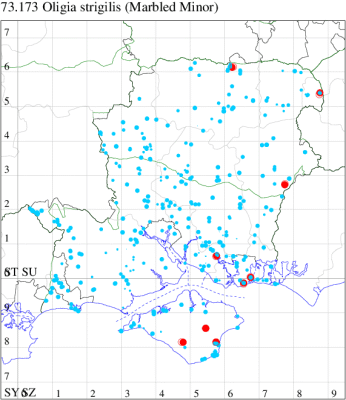
Records by year
Records by week (adult)
Records by week (larval)
Record Details
VC10: Kingston, three, 22 Jun (ENes); Haseley Manor, one, gen det, 28 May; Shanklin, one, gen det, 21 Apr; one, gen det, 26 May (IOu);
VC11: Fareham, one, to actinic, gen det, 15 Jun (MLO det. KJW); Portsmouth, one, gen det, 25 Jun (IRT); Northney, Hayling Island, present, 24 May; present, 22 Jun (JWP); Southsea, one, 21 May; one, 24 May; one, 25 May; one, 26 May; one, 01 Jun; one, 02 Jun (JRL);
VC12: Pamber Forest, two, 15 Jun (GJD); Liss, six, 25 Jun; one, 17 Jul (LBe); Farnborough, one, 21 May; one, 02 Jun (KBW)
73.174 [B&F: 2339] Tawny Marbled Minor Oligia latruncula ([Denis & Schiffermüller], 1775) - Common
Common in grassland, woodland rides, gardens and a wide range of other habitats throughout much of the British Isles. In Hampshire and on the Isle of Wight widespread and common, possibly more so than Marbled Minor O. strigilis. Wingspan 24-27 mm. Marbled Minor O. strigilis, Rufous Minor O. versicolor and Tawny Marbled Minor O. latruncula, especially their melanic forms, can only reliably be separated by dissection of the genitalia. Typical examples of Tawny Marbled Minor have the forewing blackish brown, the outer area with a distinct coppery burnish; reniform and orbicular stigmata usually indistinct except with a lens; antemedian line dentate, often very indistinct and incomplete; postmedian line curving more evenly to dorsum than in Marbled Minor (MBGBI Vol 10). It is possible with experience to assign well-marked individuals to Tawny Marbled Minor at a particular site once the observer is familiar with the forms present in that area. Larva feeds on various grasses, including Cock's-foot.
Records prior to 2020
| Vice County | #Records | #Individuals | First Record | Last Record |
|---|---|---|---|---|
| 10 | 43 | 87 | 1900 | 2018 |
| 11 | 1997 | 3218 | 1951 | 2019 |
| 12 | 252 | 349 | 1951 | 2019 |
2020 records
| Vice County | #Records | #Individuals | Max Quantity |
|---|---|---|---|
| 10 | 12 | 25 | 8 |
| 11 | 15 | 15 | 2 |
| 12 | 4 | 4 | 1 |
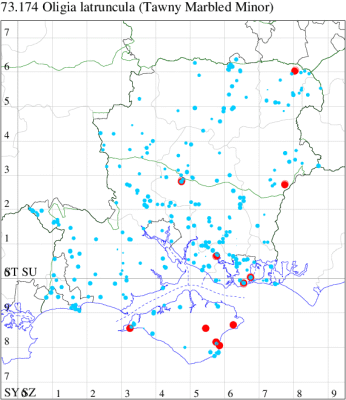
Records by year
Records by week (adult)
Records by week (larval)
Record Details
VC10: West High Down Quarry, eight, 07 Aug; Haseley Manor, two, 09 Jun; Shanklin, one, gen det, 28 May; one, 05 Jun; one, 07 Jun; one, 09 Jun; one, 14 Jun; one, 15 Jun; one, 14 Aug; Shanklin Upper Chine, two, 16 Jun; one, 08 Aug; Bembridge Fort*, five, 06 Aug (IOu);
VC11: Winchester, one, 07 Jul (THW); Fareham, one, to actinic, gen det, 16 May; one, to actinic, gen det, 29 May; one, to actinic, 14 Jun (MLO); Portsmouth, one, gen det, 02 Jun; one, gen det, 13 Jun (IRT); Northney, Hayling Island, present, 03 Jun (JWP); Southsea, one, 18 May; one, 01 Jun; one, 02 Jun (JRL);
VC12: Liss, one, 05 Jun; one, 04 Jul (LBe); Yateley, one, ♂ gen det, 16 Jun (JHH det. JHH)
73.175 [B&F: 2338] Rufous Minor Oligia versicolor (Borkhausen, 1792) - Local
Local in woodland, heathland, sea cliffs and gardens throughout much of southern England and Wales. In Hampshire and on the Isle of Wight this appears to be the least common of the three similar Oligia species, although it is undoubtedly under-recorded; even so, it does seem to have increased in the last 25 years and is evidently the commonest species by far in Bentley Wood. Wingspan 23-28 mm. Marbled Minor O. strigilis, Rufous Minor O. versicolor and Tawny Marbled Minor O. latruncula, especially their melanic forms, can only reliably be separated by dissection of the genitalia. Typical examples of Rufous Minor have reniform stigma larger, fuller and rounder than in the other species, and often conspicuously pale against the dark median shade, and it may possible with experience to assign well-marked individuals to Rufous Minor at a particular site once the observer is familiar with the forms present in that area. Larva feeds on various grasses.
Records prior to 2020
| Vice County | #Records | #Individuals | First Record | Last Record |
|---|---|---|---|---|
| 10 | 17 | 22 | 1981 | 2009 |
| 11 | 428 | 441 | 1951 | 2019 |
| 12 | 72 | 67 | 1951 | 2018 |
2020 records
| Vice County | #Records | #Individuals | Max Quantity |
|---|---|---|---|
| 11 | 1 | 1 | 1 |
| 12 | 1 | 1 | 1 |
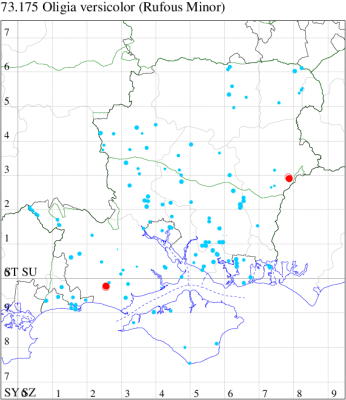
Records by year
Records by week (adult)
Records by week (larval)
Record Details
VC11: Sway, one, 08 Jun (S&SL);
VC12: Warren Hill, Liss Forest, one, 27 Jun (RJM)
73.176 [B&F: 2340] Middle-barred Minor Oligia fasciuncula (Haworth, 1809) - Common
Common in damp grassland, marshes, fens, woodland and gardens throughout much of the British Isles. In Hampshire and on the Isle of Wight widespread and fairly common in all three vice-counties. Wingspan 22-26 mm. Characterised by mottled reddish fuscous forewing, especially on costa and termen, with a median band between ante- and postmedian lines which forms a central bar along the dorsum (MBGBI Vol 10). Larva feeds on various grasses, including Tufted Hair-grass.
Records prior to 2020
| Vice County | #Records | #Individuals | First Record | Last Record |
|---|---|---|---|---|
| 10 | 187 | 322 | 1951 | 2019 |
| 11 | 1900 | 3483 | 1951 | 2019 |
| 12 | 794 | 1889 | 1950 | 2019 |
2020 records
| Vice County | #Records | #Individuals | Max Quantity |
|---|---|---|---|
| 10 | 33 | 64 | 5 |
| 11 | 55 | 64 | 2 |
| 12 | 50 | 68 | 5 |
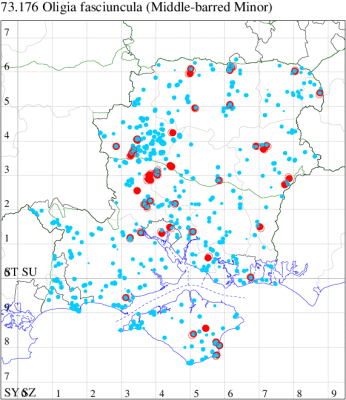
Records by year
Records by week (adult)
Records by week (larval)
Record Summary
VC10: Earliest: Bonchurch, 25 May, 1 (JHa) Latest: Shanklin Upper Chine, 16 Jun, 1 (IOu) Max count: Rookley, 27 May, 5 (JBa)
VC11: Earliest: Woodlands, New Forest, 21 May, 0 (RBW) Latest: Pennington, 21 May, 1 (RFC) Max count: Romsey, 10 Jun, 2 (SLay)
VC12: Earliest: Over Wallop, 12 Jun, 1 (CM) Latest: Yateley, 09 Jun, 1 (JHH) Max count: Overton, 08 Aug, 5 (MSi)
73.178 [B&F: 2226] Beautiful Gothic Leucochlaena oditis (Hübner, [1822]) - Nationally Scarce
A rare Red Data Book species, on grassy slopes and sea cliffs, on the Isle of Wight, and on the southern coasts of Cornwall, Devon and Dorset. On the Isle of Wight, although the number of colonies is small, the moth is firmly established in the south and west of the island, and the outlook appears good; also probably still frequent along the Freshwater cliffs and occasionally a little way inland. In Hampshire recorded for the first time at Sandy Point, Hayling, on 12 September 2010, most likely representing a wanderer from the island. Wingspan 28-36 mm. Larva feeds on various grasses, including Common Couch and Annual Meadow-grass.
Records prior to 2020
| Vice County | #Records | #Individuals | First Record | Last Record |
|---|---|---|---|---|
| 10 | 75 | 221 | 1800 | 2019 |
| 11 | 3 | 3 | 2010 | 2018 |
2020 records
| Vice County | #Records | #Individuals | Max Quantity |
|---|---|---|---|
| 10 | 3 | 6 | 4 |
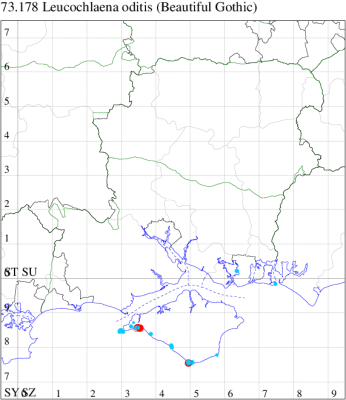
Records by year
Records by week (adult)
Records by week (larval)
Record Details
VC10: Freshwater Bay, one, 07 Nov (SDa); one, to actinic, 21 Sep (PBa); Windy Corner, four, 14 Sep (IOu)
73.179 [B&F: 2271] Orange Sallow Tiliacea citrago (Linnaeus, 1758) - Common
Common in broad-leaved woodland, parks and gardens throughout much of the British Isles. In Hampshire and on the Isle of Wight probably occurs wherever there are mature stands of lime, and hence mainly a suburban moth. Infrequently recorded at light, it can be best found by searching for larvae in late spring or sugaring the foliage of limes in autumn to attract the adult. Wingspan 33-38 mm. Larva feeds on Common Lime, Small-leaved Lime and Large-leaved Lime, over-wintering as an egg.
Records prior to 2020
| Vice County | #Records | #Individuals | First Record | Last Record |
|---|---|---|---|---|
| 10 | 24 | 18 | 1929 | 2019 |
| 11 | 149 | 107 | 1944 | 2019 |
| 12 | 74 | 64 | 1944 | 2019 |
2020 records
| Vice County | #Records | #Individuals | Max Quantity |
|---|---|---|---|
| 10 | 4 | 4 | 1 |
| 11 | 16 | 17 | 3 |
| 12 | 12 | 13 | 2 |
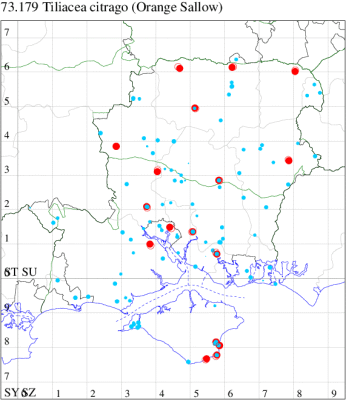
Records by year
Records by week (adult)
Records by week (larval)
Record Details
VC10: Ventnor Botanic Garden, one, to actinic, 29 Sep (PBa); Bonchurch, one, 02 Oct (JHa); Shanklin, one, 14 Sep; Shanklin Upper Chine, one, 14 Sep (IOu);
VC11: Marchwood, one, 09 Sep; one, 19 Sep (CTh); Romsey, one, 12 Sep; one, 14 Sep (MB); Southampton, one, 12 Sep (MEdg); one, to actinic, 21 Sep (MGP); Eastleigh, one, to actinic, 16 Sep (KArb); Kings Somborne, one, to actinic, 08 Sep (GCE); Fareham, one, 09 Sep (KJW); Botley, one, to actinic, 20 Sep; three, to actinic, 21 Sep (SLB); Northney, Hayling Island, present, 19 Aug (JWP);
VC12: Over Wallop*, one, 12 Sep (CM); Cholderton, one, field observation, 05 Sep (TJN, LF); Anna Valley, Andover, one, 14 Sep (TJN); Harestock, one, to actinic, 13 Sep (GRog); Burghclere, two, 19 Sep (PBl); Cheriton, one, to actinic, 18 Sep (DAS); Overton, one, 22 Sep (MSi); Pamber Forest, one, 20 Oct (GJD); Whitehill, one, 14 Sep (ASto); Yateley*, one, 08 Sep (JHH)
73.180 [B&F: 2272] Barred Sallow Tiliacea aurago ([Denis & Schiffermüller], 1775) - Common
Common in broad-leaved woodland, mature hedgerows, scrubland, downland and gardens throughout much of England. In Hampshire and on the Isle of Wight widespread and often common, mainly but not exclusively on the chalk in beech woodland. Wingspan 33-38 mm. Fairly unmistakable. Larva feeds on Field Maple and Beech, over-wintering as an egg.
Records prior to 2020
| Vice County | #Records | #Individuals | First Record | Last Record |
|---|---|---|---|---|
| 10 | 211 | 369 | 1965 | 2019 |
| 11 | 1790 | 2738 | 1949 | 2019 |
| 12 | 873 | 1820 | 1951 | 2019 |
2020 records
| Vice County | #Records | #Individuals | Max Quantity |
|---|---|---|---|
| 10 | 16 | 33 | 8 |
| 11 | 105 | 152 | 10 |
| 12 | 41 | 102 | 20 |
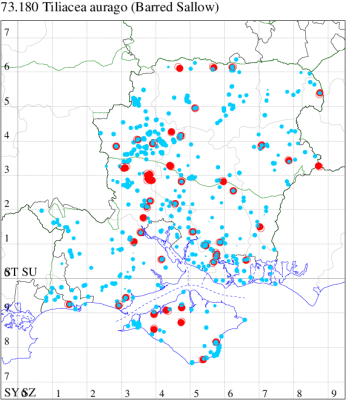
Records by year
Records by week (adult)
Records by week (larval)
Record Summary
VC10: Earliest: Brook Down, 19 Sep, 4 (PBa) Latest: Shanklin, 18 Oct, 1 (IOu) Max count: Shanklin, 16 Oct, 8 (IOu)
VC11: Earliest: Ashurst, NF, 14 Sep, 1 (SAB) Latest: Pennington, 19 Oct, 1 (RFC) Max count: Kings Somborne, 28 Sep, 10 (GCE)
VC12: Earliest: Over Wallop, 22 Sep, 1 (CM) Latest: Farnborough, 05 Oct, 1 (KBW) Max count: Beech, 28 Sep, 20 (NDP)
73.181 [B&F: 2273] Pink-barred Sallow Xanthia togata (Esper, 1788) - Common
Common in broad-leaved, often damp, woodland, marshes, fens, heathland and gardens throughout the British Isles; frequently recorded and well distributed across much of Hampshire and the Isle of Wight. Wingspan 29-37 mm. Easily distinguished from other superficially similar autumnal sallows by the distinctive purple head and patagium. Larva feeds on catkins of Sallow and Poplar, over-wintering as an egg
Records prior to 2020
| Vice County | #Records | #Individuals | First Record | Last Record |
|---|---|---|---|---|
| 10 | 104 | 149 | 1955 | 2019 |
| 11 | 1426 | 2216 | 1946 | 2019 |
| 12 | 453 | 603 | 1951 | 2019 |
2020 records
| Vice County | #Records | #Individuals | Max Quantity |
|---|---|---|---|
| 10 | 8 | 23 | 10 |
| 11 | 39 | 86 | 33 |
| 12 | 18 | 22 | 3 |
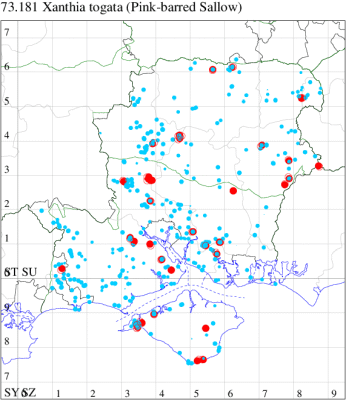
Records by year
Records by week (adult)
Records by week (larval)
Record Details
VC10: Freshwater Bay, one, 20 Sep (SDa); Afton Marsh, 10, to light, 28 Sep (IOu); Freshwater, one, to actinic, 21 Sep; three, to actinic, 20 Sep (PBa); Cranmore, present, to actinic, 14 Sep (CHic); St Lawrence Undercliff, one, to actinic, 28 Sep; St Lawrence: Salem Close, one, to actinic, 28 Sep (PBa); Haseley Manor, six, 21 Sep (IOu);
VC11: Brockwood, two, 12 Sep; one, 19 Sep (SDut); Marchwood, three, 19 Sep; one, to lighted window, 07 Sep (CTh); Woodlands, New Forest, present, 15 Sep (RBW); Ashurst, NF, one, 18 Sep (SAB); Ashurst, one, 19 Sep (NSK); East Tytherley, one, to actinic, 14 Sep; one, to actinic, 14 Sep; one, to actinic, 14 Sep; Kings Somborne, one, to actinic, 28 Sep; one, to actinic, 22 Sep (GCE); Romsey, one, 05 Sep; one, 18 Sep; three, 22 Sep (NRJ); Kings Somborne, five, to actinic, 28 Sep; three, to actinic, 28 Sep; two, to actinic, 28 Sep; two, to actinic, 28 Sep; two, to actinic, 28 Sep (GCE); Dibden Purlieu, one, 19 Sep; one, 17 Sep (RAC); Blackfied, one, to lighted window, 24 Sep (PGS); Botley Wood, 33, field observation, 18 Sep (MLO); Fareham, one, 05 Oct (KJW); Botley, one, to actinic, 15 Sep; one, to actinic, 20 Oct; one, to actinic, 18 Oct (SLB); Wickham Common, one, 11 Sep (F.M.G.); one, 23 Aug (KC); West Meon, one, 16 Oct (F.M.G. det. KJW); Stroud, Petersfield, one, to actinic, 19 Sep; one, to actinic, 20 Sep; one, to actinic, 21 Sep; one, to actinic, 06 Oct; one, to actinic, 10 Oct; one, to actinic, 13 Oct; one, to actinic, 18 Oct (RAll);
VC12: Chilbolton, one, to a lighted window, 14 Sep (GCE); Anna Valley, Andover, one, 28 Sep (TJN); Bullington, three, to actinic, 20 Sep; Wonston, one, to actinic, 20 Sep; Bullington, one, to actinic, 20 Sep; Wonston, two, to actinic, 20 Sep (GCE); Axmansford, one, 30 Oct (ACB); Pamber Forest, two, 21 Sep (GJD); Liss, one, 18 Sep (LBe); Liss Forest, one, field observation, 23 Sep (RJM); Alton, one, to actinic, 19 Sep (DBO); Whitehill, one, 10 Oct (ASto); Headley, Bordon, present, field observation, 23 Sep (iNat); Hammer Vale, Woolmer, one, 16 Oct; one, 19 Oct (ASw); Church Crookham, one, to actinic, 27 Sep; two, to actinic, 29 Sep; one, to actinic, 11 Oct (DDim)
73.182 [B&F: 2274] Sallow Cirrhia icteritia (Hufnagel, 1766) - Common
Common in broad-leaved woodland, fens, heathland, moorland and gardens throughout the British Isles, a species of conservation concern under the UK Biodiversity Action Plan. Widespread and common in Hampshire and on the Isle of Wight. Wingspan 34-38 mm. Usually unmistakable, although several not infrequent almost plain forms can be confusing, the wing-shape (costa straight and termen convex at apex) is diagnostic. Larva feeds within catkins of Black and White Poplar, and Sallow, over-wintering as an egg.
Records prior to 2020
| Vice County | #Records | #Individuals | First Record | Last Record |
|---|---|---|---|---|
| 10 | 265 | 794 | 1900 | 2019 |
| 11 | 2486 | 4604 | 1946 | 2019 |
| 12 | 687 | 1398 | 1951 | 2019 |
2020 records
| Vice County | #Records | #Individuals | Max Quantity |
|---|---|---|---|
| 10 | 12 | 64 | 43 |
| 11 | 108 | 195 | 47 |
| 12 | 22 | 26 | 2 |
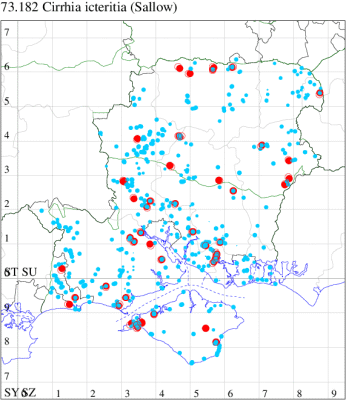
Records by year
Records by week (adult)
Records by week (larval)
Record Summary
VC10: Earliest: Totland, 18 Sep, 1 (RTe) Latest: Shanklin, 22 Oct, 1 (IOu) Max count: Haseley Manor, 21 Sep, 43 (IOu)
VC11: Earliest: Brockwood, 19 Sep, 2 (SDut) Latest: Pennington, 04 Oct, 1 (RFC) Max count: Botley Wood, 18 Sep, 47 (MLO)
VC12: Earliest: Anna Valley, Andover, 28 Sep, 2 (TJN) Latest: Farnborough, 21 Sep, 1 (KBW) Max count: Anna Valley, Andover, 28 Sep, 2 (TJN)
73.183 [B&F: 2275] Dusky-lemon Sallow Cirrhia gilvago ([Denis & Schiffermüller], 1775) - Local
Local in broad-leaved woodland, hedgerows and parks throughout much of England, northwards to central Scotland, a species of conservation concern under the UK Biodiversity Action Plan. In Hampshire and on the Isle of Wight in the past, scattered small colonies of this species occurred amongst Wych Elm, but as this tree is all but extinct in the county, the moth has gone the same way. Nowadays individuals turn up annually, but are assumed to be wanderers from the continent. Wingspan 34-40 mm. Forewing with termen more rounded than in others of the genus (MBGBI Vol 10). Larva feeds on buds, leaves and seeds of Wych Elm, over-wintering as an egg.
Records prior to 2020
| Vice County | #Records | #Individuals | First Record | Last Record |
|---|---|---|---|---|
| 10 | 10 | 7 | 1904 | 2018 |
| 11 | 81 | 101 | 1934 | 2019 |
| 12 | 25 | 15 | 1944 | 2019 |
2020 records
| Vice County | #Records | #Individuals | Max Quantity |
|---|---|---|---|
| 11 | 1 | 0 | 0 |
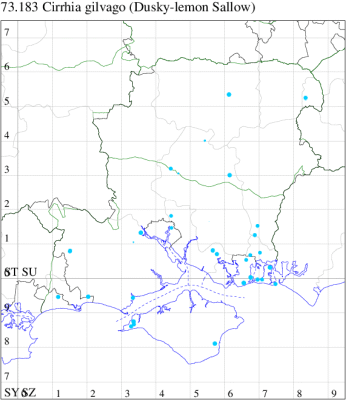
Records by year
Records by week (adult)
Records by week (larval)
Record Details
VC11: Northney, Hayling Island, present, 19 Sep (JWP)
73.184 [B&F: 2276] Pale-lemon Sallow Cirrhia ocellaris (Borkhausen, 1792) - Nationally Scarce
Nationally scarce (Na) in plantations, roadside verges and parks throughout much of south-eastern England. In our area first recorded at Wootton, IoW, on 5 October 1997, and at Portsmouth, Hampshire on 3 October 2003. In both counties there have been an increase in sightings, although it is generally less than annual. Wingspan 36-42 mm. The main confusion species is Dusky-lemon Sallow X. gilvago, but X. ocellaris has slightly hooked forewings, and is generally darker. Larva feeds on catkins of Black Poplar, over-wintering as an egg.
Records prior to 2020
| Vice County | #Records | #Individuals | First Record | Last Record |
|---|---|---|---|---|
| 10 | 4 | 4 | 1997 | 2015 |
| 11 | 13 | 13 | 2003 | 2019 |
2020 records
| Vice County | #Records | #Individuals | Max Quantity |
|---|---|---|---|
| 10 | 1 | 1 | 1 |
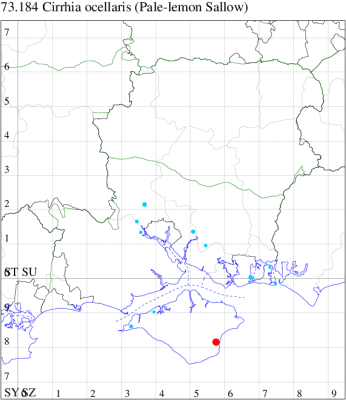
Records by year
Records by week (adult)
Records by week (larval)
Record Details
VC10: Shanklin*, one, 21 Sep (IOu)
73.186 [B&F: 2267] Beaded Chestnut Agrochola lychnidis ([Denis & Schiffermüller], 1775) - Common
Common in broad-leaved woodland, scrub, hedgerows, grassland, heathland and gardens throughout England, Wales and southern Scotland, a species of conservation concern under the UK Biodiversity Action Plan. Widespread and common in Hampshire and on the Isle of Wight. Wingspan 32-42 mm. Most likely confusion species is Brown-spot Pinion A. litura, but reniform stigma narrower, and orbicular stigma smaller and elongated. Larva feeds on Hawthorn.
Records prior to 2020
| Vice County | #Records | #Individuals | First Record | Last Record |
|---|---|---|---|---|
| 10 | 366 | 1049 | 1949 | 2019 |
| 11 | 3159 | 9563 | 1949 | 2019 |
| 12 | 1114 | 5964 | 1950 | 2019 |
2020 records
| Vice County | #Records | #Individuals | Max Quantity |
|---|---|---|---|
| 10 | 20 | 46 | 8 |
| 11 | 141 | 355 | 27 |
| 12 | 51 | 114 | 8 |
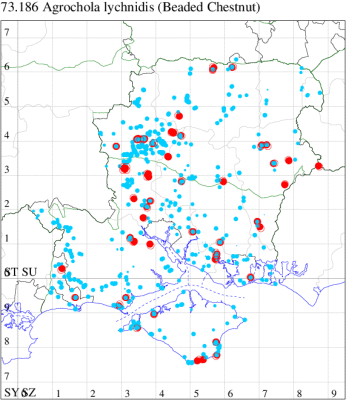
Records by year
Records by week (adult)
Records by week (larval)
Record Summary
VC10: Earliest: Freshwater Bay, 13 Oct, 2 (SDa) Latest: Shanklin, 17 Nov, 1 (IOu) Max count: Shanklin, 07 Oct, 8 (IOu)
VC11: Earliest: Brockwood, 19 Sep, 3 (SDut) Latest: Pennington, 21 Nov, 1 (RFC) Max count: Broughton, 18 Oct, 27 (GCE)
VC12: Earliest: Over Wallop, 17 Oct, 3 (CM) Latest: Hammer Vale, Woolmer, 19 Oct, 1 (ASw) Max count: Cholderton, 10 Oct, 8 (TJN, LF)
73.193 [B&F: 2270] Lunar Underwing Anchoscelis lunosa (Haworth, 1809) - Common
Common in a wide range of habitats, including grassland, parks, downland and gardens throughout the British Isles. In Hampshire and on the Isle of Wight one of the commonest autumn species on downland and grassy heaths, but also found less frequently in deciduous woodland. Wingspan 32-37 mm. Variable in colour and extent of markings, but the pattern of clearly defined whitish veins and subterminal line of black dots makes this an easily recognised noctuid. See also Beaded Chestnut Agrochola lychnidis and Brown-spot Pinion Anchoscelis litura.
Larva feeds on various grasses, including Cock's-foot, Annual Meadow-grass and Yorkshire-fog.
Records prior to 2020
| Vice County | #Records | #Individuals | First Record | Last Record |
|---|---|---|---|---|
| 10 | 771 | 7790 | 1951 | 2019 |
| 11 | 7986 | 54712 | 1949 | 2019 |
| 12 | 2131 | 13115 | 1951 | 2019 |
2020 records
| Vice County | #Records | #Individuals | Max Quantity |
|---|---|---|---|
| 10 | 79 | 1185 | 109 |
| 11 | 499 | 3480 | 73 |
| 12 | 159 | 1223 | 53 |
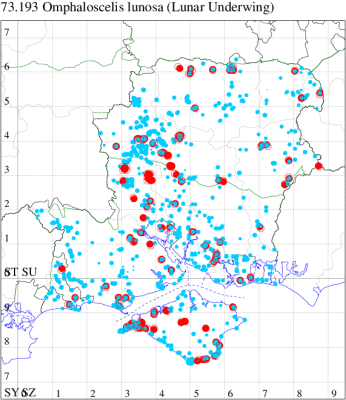
Records by year
Records by week (adult)
Records by week (larval)
Record Summary
VC10: Earliest: Headon Warren, 17 Sep, 2 (PBa) Latest: Seaview, 19 Sep, 1 (JMas) Max count: Shanklin, 21 Sep, 109 (IOu)
VC11: Earliest: Brockwood, 19 Sep, 4 (SDut) Latest: Southsea, 09 Oct, 3 (JGe) Max count: Broughton, 21 Sep, 73 (GCE)
VC12: Earliest: Over Wallop, 22 Sep, 1 (CM) Latest: Yateley, 14 Sep, 2 (JHH) Max count: Beech, 21 Sep, 53 (NDP)
73.187 [B&F: 2266] Brown-spot Pinion Anchoscelis litura (Linnaeus, 1761) - Common
Common in broad-leaved woodland, parkland, heathland, fens, scrub, hedgerows and gardens throughout the British Isles, a species of conservation concern under the UK Biodiversity Action Plan. Widespread and moderately common in Hampshire but scarce on the Isle of Wight, with only two records so far this century. Wingspan 32-39 mm. The main confusion species is Beaded Chestnut A. lychnidis, which see. Larva feeds on various herbaceous plants, including Meadowsweet, Common Sorrel and Bladder Campion.
Records prior to 2020
| Vice County | #Records | #Individuals | First Record | Last Record |
|---|---|---|---|---|
| 10 | 8 | 4 | 1856 | 2004 |
| 11 | 466 | 723 | 1949 | 2019 |
| 12 | 712 | 1824 | 1950 | 2019 |
2020 records
| Vice County | #Records | #Individuals | Max Quantity |
|---|---|---|---|
| 11 | 18 | 40 | 7 |
| 12 | 22 | 36 | 4 |
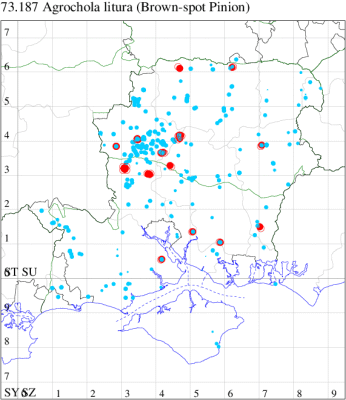
Records by year
Records by week (adult)
Records by week (larval)
Record Details
VC11: Broughton, four, to actinic, 21 Sep; one, to actinic, 21 Sep; two, to actinic, 21 Sep; one, to actinic, 18 Oct; two, to actinic, 21 Sep; one, to actinic, 18 Oct; one, to actinic, 21 Sep; seven, to actinic, 18 Oct; five, to actinic, 21 Sep; five, to actinic, 21 Sep; Ashley, two, to actinic, 22 Sep; two, to actinic, 22 Sep; two, to actinic, 22 Sep (GCE); Dibden Purlieu, one, 08 Nov (RAC); Botley, one, to actinic, 23 Sep (SLB); Wickham Common, one, 04 Oct (KC); Horndean, one, to actinic, 18 Sep (PHog);
VC12: Over Wallop, one, 12 Sep (CM); Cholderton, four, 10 Oct; three, 17 Oct (TJN, LF); Goodworth Clatford, one, to actinic, 17 Oct; one, to actinic, 06 Sep; one, to actinic, 17 Oct; Chilbolton, one, to actinic, 15 Sep; one, to actinic, 15 Sep; one, to actinic, 15 Sep; one, to actinic, 15 Sep; Crawley, one, to actinic, 17 Sep; Bullington, one, to actinic, 20 Sep; two, to actinic, 20 Sep; Wonston, one, to actinic, 20 Sep; Bullington, three, to actinic, 20 Sep; Wonston , two, to actinic, 20 Sep (GCE); Burghclere, one, 19 Sep (PBl); Pamber Forest, one, 28 Sep (GJD); Alton, one, to actinic, 21 Oct (BCA)
73.188 [B&F: 2265] Flounced Chestnut Anchoscelis helvola (Linnaeus, 1758) - Common
Common in broad-leaved woodland, scrubby downland, heathland and moorland throughout much of the British Isles, a species of conservation concern under the UK Biodiversity Action Plan. In Hampshire and on the Isle of Wight present in all three vice-counties, but usually at low density and mainly in deciduous woodland. Wingspan 35-45 mm. Larva feeds on Sessile Oak, Pedunculate Oak, Wych Elm, English Elm, Silver Birch, Downy Birch, Eared Willow, Goat Willow, Grey Willow, broad-leaved trees, Heather and Bilberry, over-wintering as an egg.
Records prior to 2020
| Vice County | #Records | #Individuals | First Record | Last Record |
|---|---|---|---|---|
| 10 | 30 | 20 | 1903 | 2018 |
| 11 | 338 | 442 | 1946 | 2018 |
| 12 | 40 | 19 | 1951 | 2015 |
2020 records
| Vice County | #Records | #Individuals | Max Quantity |
|---|---|---|---|
| 11 | 2 | 1 | 1 |
| 12 | 1 | 1 | 1 |
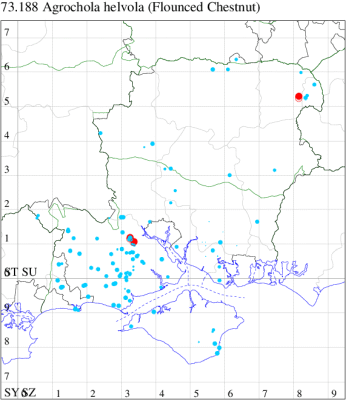
Records by year
Records by week (adult)
Records by week (larval)
Record Details
VC11: Woodlands, New Forest, present, 19 Oct (RBW); Ashurst, NF, one, 19 Oct (SAB);
VC12: Fleet, one, 19 Sep (MHals)
73.191 [B&F: 2264a] Southern Chestnut Anchoscelis haematidea (Duponchel, 1827) - RDB2
A vulnerable Red Data Book species, on heathland in parts of Sussex, Hampshire and Dorset. It was first discovered in Britain in West Sussex in 1990. In Hampshire first discovered in the county in 1996 at Linford, it has subsequently been found found to occur widely in the New Forest. While it may have been a new arrival in the country at that time, it may well have been previously overlooked due to its late season and short flight period, which is for only half an hour at dusk. Not recorded from the Isle of Wight to date. Wingspan 32-38 mm. Distinguished from Beaded Chestnut Agrochola lychnidis by the very pointed apex and slightly smaller size. Larva feeds on flowers of Bell Heather, over-wintering as an egg.
Records prior to 2020
| Vice County | #Records | #Individuals | First Record | Last Record |
|---|---|---|---|---|
| 11 | 148 | 294 | 1996 | 2019 |
2020 records
| Vice County | #Records | #Individuals | Max Quantity |
|---|---|---|---|
| 11 | 2 | 2 | 1 |
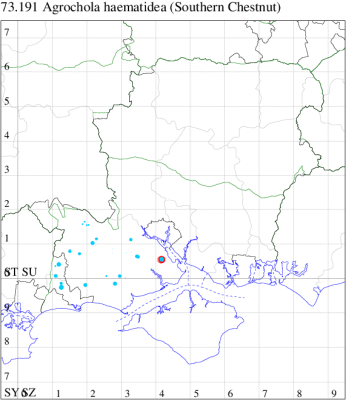
Records by year
Records by week (adult)
Records by week (larval)
Record Details
VC11: Dibden Purlieu, one, 28 Sep (RAC)
73.189 [B&F: 2263] Red-line Quaker Leptologia lota (Clerck, 1759) - Common
Common in woodland rides, scrub, hedgerows, fens, marshes, heathland and gardens throughout the British Isles. Widespread and common in Hampshire and on the Isle of Wight. Wingspan 33-39 mm. A late autumn moth, slate grey with subterminal line yellowish white, proximally bordered vermilion (MBGBI Vol 10), but see also Yellow-line Quaker A. macilenta. Larva feeds on catkins and leaves of Eared, Goat and Grey Willow.
Records prior to 2020
| Vice County | #Records | #Individuals | First Record | Last Record |
|---|---|---|---|---|
| 10 | 298 | 497 | 1951 | 2019 |
| 11 | 2592 | 4195 | 1951 | 2019 |
| 12 | 644 | 947 | 1950 | 2019 |
2020 records
| Vice County | #Records | #Individuals | Max Quantity |
|---|---|---|---|
| 10 | 6 | 7 | 2 |
| 11 | 116 | 156 | 4 |
| 12 | 40 | 65 | 7 |
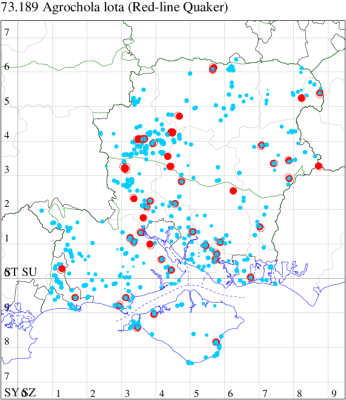
Records by year
Records by week (adult)
Records by week (larval)
Record Summary
VC10: Earliest: Freshwater Bay, 18 Oct, 2 (SDa) Latest: Shanklin, 08 Nov, 1 (IOu) Max count: Freshwater Bay, 18 Oct, 2 (SDa)
VC11: Earliest: Brockwood, 17 Oct, 3 (SDut) Latest: Southsea, 26 Oct, 2 (JRL) Max count: Marchwood, 21 Oct, 4 (CTh)
VC12: Earliest: Cholderton, 10 Oct, 1 (TJN, LF) Latest: Farnborough, 14 Oct, 1 (KBW) Max count: Wherwell, 17 Oct, 7 (GCE)
73.190 [B&F: 2264] Yellow-line Quaker Leptologia macilenta (Hübner, [1809]) - Common
Common in broad-leaved woodland, scrub, heathland, moorland, hedgerows and gardens throughout the British Isles. Widespread and common in Hampshire and on the Isle of Wight. Wingspan 37-40 mm. Straight subterminal fascia distinguishes this species from the otherwise similar Brick A. circellaris and warm brown wings from the grey-winged Red-line Quaker A. lota. Larva feeds on various deciduous trees and shrubs, including Sessile and Pedunculate Oak, White and Black Poplar, Beech, Sallow, Hawthorn and Heather, and, when approaching maturity, on various herbaceous plants, over-wintering as an egg.
Records prior to 2020
| Vice County | #Records | #Individuals | First Record | Last Record |
|---|---|---|---|---|
| 10 | 314 | 964 | 1951 | 2019 |
| 11 | 1998 | 5975 | 1951 | 2019 |
| 12 | 796 | 1928 | 1950 | 2019 |
2020 records
| Vice County | #Records | #Individuals | Max Quantity |
|---|---|---|---|
| 10 | 14 | 42 | 10 |
| 11 | 124 | 176 | 7 |
| 12 | 51 | 98 | 7 |
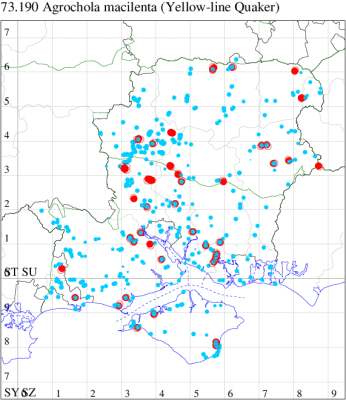
Records by year
Records by week (adult)
Records by week (larval)
Record Summary
VC10: Earliest: Freshwater Bay, 07 Nov, 1 (SDa) Latest: Shanklin, 24 Nov, 1 (IOu) Max count: Shanklin, 08 Nov, 10 (IOu)
VC11: Earliest: Brockwood, 10 Oct, 4 (SDut) Latest: Pennington, 22 Nov, 1 (RFC) Max count: Botley, 29 Oct, 7 (SLB)
VC12: Earliest: Cholderton, 17 Oct, 3 (TJN, LF) Latest: Yateley, 08 Nov, 2 (JHH) Max count: Teg Down, Winchester, 09 Nov, 7 (CKn)
73.192 [B&F: 2262] Brick Sunira circellaris (Hufnagel, 1766) - Common
Common in broad-leaved woodland, scrubland, parks and gardens throughout the British Isles. In Hampshire and on the Isle of Wight most frequent in areas of mature ash, less so in localities where the larval foodplant is the catkins of sallows or poplars. Wingspan 38-42 mm. The main confusion species is Yellow-line Quaker A. macilenta, which differs in subterminal line straight and very conspicuous, sinuate in A. circellaris. Larva feeds on Wych Elm, Aspen, White Poplar, White Poplar, Sallow and Ash, over-wintering as an egg.
Records prior to 2020
| Vice County | #Records | #Individuals | First Record | Last Record |
|---|---|---|---|---|
| 10 | 127 | 203 | 1951 | 2019 |
| 11 | 816 | 1208 | 1946 | 2019 |
| 12 | 381 | 434 | 1951 | 2019 |
2020 records
| Vice County | #Records | #Individuals | Max Quantity |
|---|---|---|---|
| 10 | 11 | 13 | 2 |
| 11 | 31 | 33 | 2 |
| 12 | 10 | 20 | 5 |
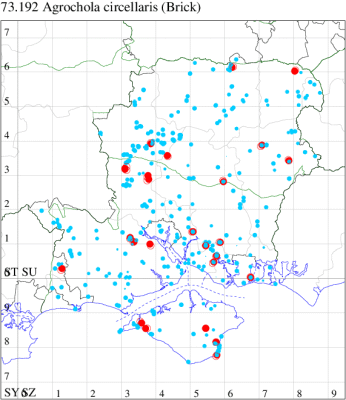
Records by year
Records by week (adult)
Records by week (larval)
Record Details
VC10: Freshwater, one, to actinic, 15 Sep; Compton Down, one, to actinic, 14 Sep (PBa); Bonchurch, one, 09 Aug; one, 07 Nov (JHa); Haseley Manor, two, 21 Sep; Shanklin, two, 26 Oct; one, 07 Nov; one, 08 Nov; one, 10 Nov; one, 17 Nov; one, 24 Nov (IOu);
VC11: Brockwood, one, 26 Oct (SDut); Marchwood, two, 26 Oct (CTh); Woodlands, New Forest, present, 07 Nov (RBW); Ashurst, NF, one, 20 Sep; one, 22 Sep (SAB); Ashley, one, to actinic, 22 Sep; Kings Somborne, one, to actinic, 16 Nov; Broughton, one, to actinic, 18 Oct; one, to actinic, 18 Oct (GCE); Botley Wood, one, 18 Sep; one, field observation, on guelder rose berries by torchlight, 23 Oct; one, 11 Dec; one, 11 Dec (F.M.G.); Fareham, one, 21 Nov (ADT); one, to actinic, 17 Oct; one, to actinic, 27 Nov (MLO); Botley, one, to actinic, 19 Oct; one, to actinic, 30 Oct; one, to actinic, 08 Nov (SLB); Wickham Common, one, 22 Nov (KC); Portsmouth, one, 17 Nov (IRT); Lovedean, one, 09 Nov; one, 10 Nov; two, 12 Nov; one, 21 Nov; one, 25 Nov (ARJ);
VC12: Chilbolton, one, field observation, 29 Sep; Crawley, one, to actinic, 16 Oct (GCE); Hinton Ampner, one, 07 Nov; two, 08 Nov; four, 22 Nov; five, 23 Nov (ASD); Pamber Forest, one, 20 Oct (GJD); Alton, one, to actinic, 07 Nov (DBO); Whitehill, one, 09 Nov (ASto); Yateley*, three, 08 Nov (JHH)
73.194 [B&F: 2258] Chestnut Conistra vaccinii (Linnaeus, 1761) - Common
Common in broad-leaved woodland, scrub, hedgerows and gardens throughout the British Isles. Widespread and common in Hampshire and on the Isle of Wight. Wingspan 28-36 mm. Distinguished from the generally less common Dark Chestnut C. ligula by the rounded termen and rather blunt apex. Larva feeds on flowers and leaves of various deciduous trees and shrubs, including Pedunculate and Sessile Oak, Elm, Blackthorn, Hawthorn and Downy Birch, and occasionally on herbaceous plants such as Dock.
Records prior to 2020
| Vice County | #Records | #Individuals | First Record | Last Record |
|---|---|---|---|---|
| 10 | 524 | 996 | 1951 | 2019 |
| 11 | 4756 | 9043 | 1951 | 2019 |
| 12 | 2333 | 5451 | 1950 | 2019 |
2020 records
| Vice County | #Records | #Individuals | Max Quantity |
|---|---|---|---|
| 10 | 48 | 102 | 6 |
| 11 | 234 | 427 | 16 |
| 12 | 127 | 320 | 16 |
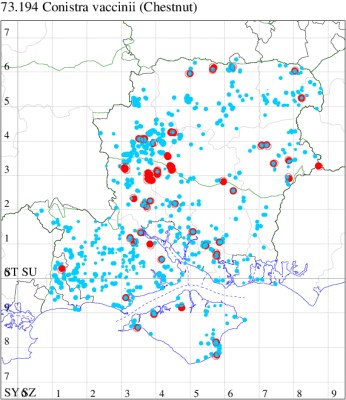
Records by year
Records by week (adult)
Records by week (larval)
Record Summary
VC10: Earliest: Freshwater Bay, 07 Nov, 1 (SDa) Latest: Shanklin, 24 Nov, 2 (IOu) Max count: Parkhurst Forest, 16 Oct, 6 (IOu)
VC11: Earliest: Brockwood, 17 Oct, 6 (SDut) Latest: Boldre, 11 Apr, 2 (JDur) Max count: Botley Wood, 24 Jan, 16 (F.M.G.)
VC12: Earliest: Cholderton, 10 Oct, 2 (TJN, LF) Latest: Yateley, 08 Nov, 1 (JHH) Max count: Pamber Forest, 08 Nov, 16 (GJD)
73.195 [B&F: 2259] Dark Chestnut Conistra ligula (Esper, 1791) - Common
Common in woodland, farmland and gardens throughout England and southern Scotland. Widespread but rather uncommon in Hampshire and on the Isle of Wight. Wingspan 31-35 mm. Distinguished from the more numerous Chestnut C. vaccinii by the shape of the termen and angle subtended by the apex, but care needs to be taken with worn individuals after they have hibernated. Larva feeds on various deciduous trees and shrubs, such as Blackthorn, Hawthorn, Sessile and Pedunculate Oak, and Sallow, and when nearly fully grown on various herbaceous plants, such as Dandelion and Dock.
Records prior to 2020
| Vice County | #Records | #Individuals | First Record | Last Record |
|---|---|---|---|---|
| 10 | 73 | 65 | 1950 | 2019 |
| 11 | 583 | 607 | 1951 | 2019 |
| 12 | 137 | 153 | 1950 | 2019 |
2020 records
| Vice County | #Records | #Individuals | Max Quantity |
|---|---|---|---|
| 10 | 1 | 1 | 1 |
| 11 | 27 | 29 | 2 |
| 12 | 13 | 23 | 5 |
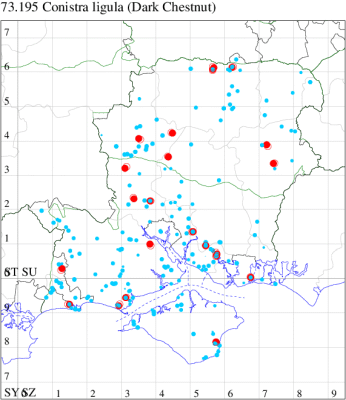
Records by year
Records by week (adult)
Records by week (larval)
Record Details
VC10: Shanklin, one, 10 Nov (IOu);
VC11: Brockwood, one, 31 Jan; one, 11 Dec (SDut); Marchwood, one, 15 Oct (CTh); Stanbrige Earls, one, to actinic, 07 Nov (JRMi); Romsey, two, 01 Feb (NRJ); Broughton, one, to actinic, 18 Oct (GCE); Botley Wood, two, field observation, on guelder rose berries and rose hips by torchlight, 23 Oct; one, 23 Oct (F.M.G. det. KJW); Fareham, one, to actinic, 08 Nov (MLO); one, 08 Nov (KJW); Botley, one, to actinic, 08 Jan; one, to actinic, 08 Jan; one, to actinic, 16 Jan; one, to actinic, 16 Jan; one, to actinic, 09 Oct; one, to actinic, 09 Jan; one, to actinic, 24 Jan; one, to actinic, 12 Oct; one, to actinic, 11 Nov (SLB); Portsmouth, one, 17 Nov (IRT); Stroud, Petersfield*, one, to actinic, 18 Oct (RAll); Tuckton, Bournemouth, one, 06 Nov (APar); Milford on Sea, one, 07 Nov (MMcM); Pennington, one, 22 Oct; one, 09 Nov; one, 16 Nov (RFC);
VC12: Goodworth Clatford, one, 17 Oct; Crawley, one, to actinic, 16 Oct; Barton Stacey, one, to actinic, 22 Oct (GCE); Axmansford, one, 22 Sep; four, 21 Oct; two, 30 Oct; one, 17 Oct (ACB); Pamber Forest, five, 20 Oct; two, 30 Oct; two, 08 Nov (GJD); Petersfield*, one, to actinic, 25 Apr (SBro); Alton, one, to actinic, 17 Oct; Selborne, one, 22 Oct (CJP)
73.197 [B&F: 2260] Dotted Chestnut Conistra rubiginea ([Denis & Schiffermüller], 1775) - Nb
Nationally scarce (Nb) in woodland, wooded heathland, farmland and hedgerows in parts of England, most commonly in the south-west; increasing. In Hampshire this species appears to have become much more widespread in recent years, though still at low density: up until the 1970s, its stronghold was on the Bagshot Sands area in the north-east, but recently there have been records from across the county. On the Isle of Wight, it remains distinctly uncommon, but two in 2009 hint at an increase. Wingspan 34-40 mm. Larva feeds on Apple.
Records prior to 2020
| Vice County | #Records | #Individuals | First Record | Last Record |
|---|---|---|---|---|
| 10 | 57 | 68 | 1864 | 2019 |
| 11 | 338 | 317 | 1800 | 2019 |
| 12 | 244 | 242 | 1900 | 2019 |
2020 records
| Vice County | #Records | #Individuals | Max Quantity |
|---|---|---|---|
| 10 | 5 | 6 | 2 |
| 11 | 9 | 9 | 1 |
| 12 | 4 | 4 | 1 |
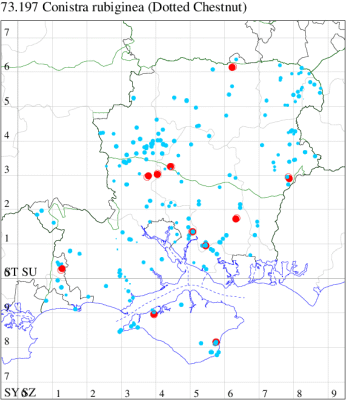
Records by year
Records by week (adult)
Records by week (larval)
Record Details
VC10: Cranmore, present, to actinic, 02 Apr (CHic); Shanklin, one, 23 Feb; two, 14 Mar; two, 15 Mar; one, 07 Apr (IOu);
VC11: Brockwood, one, 19 Mar (SDut); Ashley, one, 19 Feb; one, to actinic, 17 Mar (GCE); Botley Wood, one, 17 Mar (KJW); Botley, one, to actinic, 18 Oct (SLB); Wickham, one, 24 Apr (JRDS); Stoke Wood, Soberton, one, 08 Apr (BRP); Sway, one, 11 Apr (SKe);
VC12: Crawley, one, to actinic, 18 Mar (GCE); Pamber Forest, one, 05 Apr; one, 12 Apr (GJD); Liss Forest, one, 10 Apr (RJM)
73.200 [B&F: 2235] Tawny Pinion Lithophane semibrunnea (Haworth, 1809) - Local
Local in broad-leaved woodland, parks and gardens throughout much of southern England; in Hampshire and on the Isle of Wight, occurs at very low density throughout, the majority being taken at light after hibernation. Wingspan 40-44 mm. The main confusion species is Pale Pinion L. hepatica, especially dark forms, but the forewing is less narrow, with slightly arched costa and no black pre-tornal streak (MBGBI Vol 10). Larva feeds on Ash.
Records prior to 2020
| Vice County | #Records | #Individuals | First Record | Last Record |
|---|---|---|---|---|
| 10 | 35 | 23 | 1900 | 2019 |
| 11 | 170 | 120 | 1946 | 2019 |
| 12 | 68 | 52 | 1946 | 2019 |
2020 records
| Vice County | #Records | #Individuals | Max Quantity |
|---|---|---|---|
| 11 | 3 | 3 | 1 |
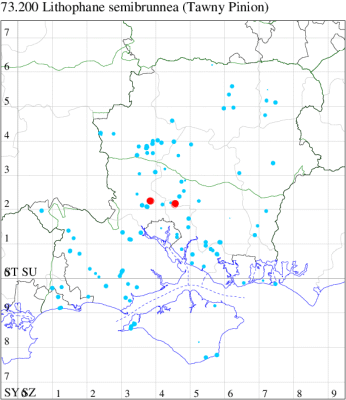
Records by year
Records by week (adult)
Records by week (larval)
Record Details
VC11: Romsey, one, 19 Apr (NRJ); Allbrook, one, 18 May (SI)
73.201 [B&F: 2236] Pale Pinion Lithophane socia (Hufnagel, 1766) - Local
Local in broad-leaved woodland and parks throughout much of England and Wales. In Hampshire and on the Isle of Wight occurs at low density, often seen in spring after emerging from hibernation, either at light or sallow bloom. Wingspan 40-46 mm. The main confusion species is Tawny Pinion L. semibrunnea, but paler and without heavy apical streaking. Larva feeds on various trees and shrubs, including Oak, Sallow, Birch, Apple, Horse-chestnut, Bramble and White Poplar.
Records prior to 2020
| Vice County | #Records | #Individuals | First Record | Last Record |
|---|---|---|---|---|
| 10 | 119 | 113 | 1800 | 2019 |
| 11 | 601 | 541 | 1951 | 2019 |
| 12 | 265 | 268 | 1940 | 2019 |
2020 records
| Vice County | #Records | #Individuals | Max Quantity |
|---|---|---|---|
| 10 | 5 | 5 | 1 |
| 11 | 8 | 8 | 1 |
| 12 | 2 | 2 | 1 |
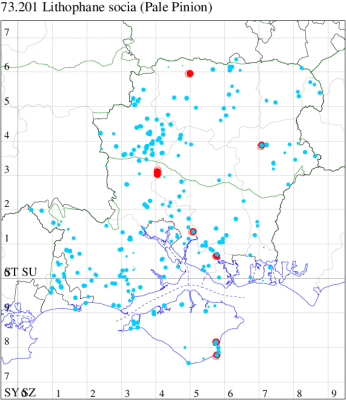
Records by year
Records by week (adult)
Records by week (larval)
Record Details
VC10: Bonchurch, one, 11 Apr (JHa); Shanklin, one, 03 Mar; one, 08 Apr; one, 11 Apr; one, 14 May (IOu);
VC11: Southampton, one, 07 May (MEdg); Ashley, one, to actinic, 26 May; Kings Somborne, one, to actinic, 17 Mar (GCE); Fareham, one, to actinic, 08 Apr (MLO); Botley, one, to actinic, 09 Mar; one, to actinic, 10 Mar (SLB); Sway, one, 07 Apr; one, 27 May (SKe);
VC12: Ecchinswell, one, to actinic, 25 Apr (MTa, CSu); Alton, one, to actinic, 11 Apr (BCA)
73.202 [B&F: 2237] Grey Shoulder-knot Lithophane ornitopus (Hufnagel, 1766) - Common
Common in oak woodland, broad-leaved woodland and parks throughout much of southern England and Wales. In Hampshire and on the Isle of Wight following a period of scarcity during the post-War years, this species has recovered quite well and is now not uncommon in oak woodland in all three vice-counties. In the New Forest it reportedly can often be found resting on pine trunks in mixed woodland. Wingspan 37-42 mm. The most likely confusion species is Blair's Shoulder-knot L. leautieri, which see for differences. Larva feeds on Pedunculate Oak and Sessile Oak.
Records prior to 2020
| Vice County | #Records | #Individuals | First Record | Last Record |
|---|---|---|---|---|
| 10 | 129 | 120 | 1951 | 2019 |
| 11 | 1002 | 962 | 1945 | 2019 |
| 12 | 326 | 329 | 1951 | 2019 |
2020 records
| Vice County | #Records | #Individuals | Max Quantity |
|---|---|---|---|
| 10 | 1 | 0 | 0 |
| 11 | 17 | 17 | 2 |
| 12 | 9 | 9 | 1 |
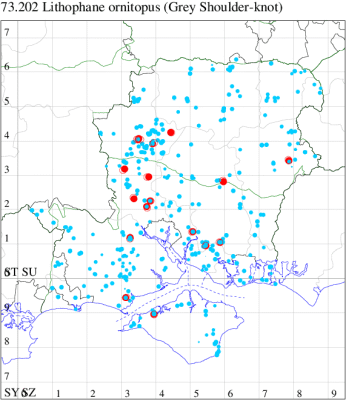
Records by year
Records by week (adult)
Records by week (larval)
Record Details
VC10: Cranmore, present, to actinic, 24 Jan (CHic);
VC11: Woodlands, New Forest, present, 24 Feb (RBW); Stanbrige Earls, one, to actinic, 28 Sep (JRMi); Romsey, one, 21 Mar (MB); Kings Somborne, one, to actinic, 19 Feb (GCE); Romsey, one, 15 Mar; one, 25 Mar (NRJ); Broughton, one, to actinic, 18 Oct (GCE); Botley Wood, one, 13 Mar (F.M.G.); Botley, one, to actinic, 20 Dec (SLB); Wickham Common, one, 25 Nov (KC); Lovedean, one, 23 Feb; one, 24 Mar; one, 22 Oct (ARJ); Stroud, Petersfield*, one, to actinic, 12 Oct (RAll); Sway, one, 03 Apr (SKe); Pennington, one, 23 Oct (RFC);
VC12: Chilbolton, one, to actinic, 04 Apr (GCE); one, to actinic, 08 Oct (SLE det. GCE); Goodworth Clatford, one, to actinic, 17 Oct; one, 17 Oct; Barton Stacey, one, to actinic, 22 Oct (GCE); Hinton Ampner, one, 23 Nov (ASD); Beech, one, 18 Oct (NDP); Whitehill, one, to actinic, 22 Feb; one, 08 Nov (ASto)
73.206 [B&F: 2240] Blair's Shoulder-knot Lithophane leautieri (Boisduval, 1829) - Common
Common in coniferous woodland, plantations, parks and gardens throughout much of England and Wales. First recorded nationally on the Isle of Wight in 1951, rapidly spreading northwards: in Sussex, first two in 1954, common by 1957; in Dorset, 1959 and soon plentiful; in Surrey, first in 1960, widespread by 1978; in north Hampshire, one at Whitehill, 1960 and widely in south Hampshire from 1965 onwards; north Wiltshire, 1969. Since then its spread has accelerated, reaching west to Cornwall and South Wales, north through the Midlands to Warwickshire and Leicestershire, east to Kent and Suffolk. In Hampshire and on the Isle of Wight it is now one of the commonest autumn moths, benefiting from the widespread planting of Cypress trees in gardens and parks. Wingspan 40-45 mm. The most likely confusion species is Grey Shoulder-knot L. ornitopus which is lighter grey, has broader and rounder wings, a furcate basal dash, and terminal fascia composed of black dots (MBGBI Vol 10). Larva feeds on flowers and leaves of Monterey Cypress, Lawson's Cypress and Leyland Cypress, over-wintering as an egg.
Records prior to 2020
| Vice County | #Records | #Individuals | First Record | Last Record |
|---|---|---|---|---|
| 10 | 216 | 337 | 1951 | 2019 |
| 11 | 3282 | 7933 | 1951 | 2019 |
| 12 | 664 | 1155 | 1951 | 2019 |
2020 records
| Vice County | #Records | #Individuals | Max Quantity |
|---|---|---|---|
| 10 | 10 | 10 | 2 |
| 11 | 59 | 72 | 5 |
| 12 | 10 | 10 | 1 |
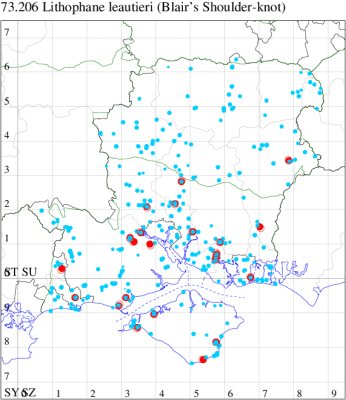
Records by year
Records by week (adult)
Records by week (larval)
Record Details
VC10: Freshwater Bay, one, 13 Oct (SDa); Cranmore, present, to actinic, 09 Oct (CHic); St Lawrence: Salem Close, one, to actinic, 26 Sep (PBa); Shanklin, one, 07 Oct; one, 14 Oct; two, 16 Oct; one, 20 Oct; one, 17 Nov (IOu);
VC11: Brockwood, one, 10 Oct; one, 04 Nov; one, 11 Nov (SDut); Marchwood, one, 15 Oct; one, 06 Nov (CTh); Woodlands, New Forest, present, 19 Oct (RBW); Ashurst, NF, one, 19 Oct; one, 20 Oct (SAB); Totton, one, 08 Nov (LH); Romsey, one, 16 Oct (MB); Southampton, one, 29 Oct; one, 07 Nov (MEdg); Allbrook, one, to actinic, 16 Oct; one, to actinic, 17 Oct (SI); Winchester, two, 16 Oct (THW); Fareham, one, 17 Nov (IMcP); one, to actinic, 11 Oct; one, to actinic, 17 Oct; one, to actinic, 10 Nov (MLO); one, 10 Oct; one, 20 Oct (KJW); Botley, one, to actinic, 24 Sep; two, to actinic, 02 Oct; three, to actinic, 03 Oct; three, to actinic, 09 Oct; one, to actinic, 20 Oct; one, to actinic, 23 Oct; two, to actinic, 02 Oct; one, to actinic, 03 Oct; one, to actinic, 05 Oct; two, to actinic, 06 Oct; one, to actinic, 17 Oct; one, to actinic, 18 Oct; one, to actinic, 05 Nov; one, to actinic, 13 Nov; one, to actinic, 14 Nov (SLB); Wickham Common, one, 24 Sep (KC); Portsmouth, two, 20 Oct (IRT); Lovedean, one, 08 Nov (ARJ); Northney, Hayling Island, present, 23 Oct; present, 25 Oct (JWP); Horndean, one, to actinic, 09 Oct (PHog); Burton, nr Christchurch, one, 04 Oct (JSw); Milford on Sea, one, 16 Oct; one, 18 Oct; one, 17 Nov (MMcM); Pennington, one, 04 Oct; two, 05 Oct; one, 09 Oct; one, 16 Oct; five, 17 Oct; three, 19 Oct; one, 22 Oct; one, 23 Oct; one, 07 Nov (RFC);
VC12: Cholderton, one, 10 Oct (TJN, LF); Anna Valley, Andover, one, 28 Sep (TJN); Harestock, one, to actinic, 12 Oct; one, to actinic, 11 Nov (GRog); Alton, one, to actinic, 18 Oct (NDP); Whitehill, one, 07 Oct; one, 08 Oct; one, 18 Oct; one, 21 Oct (ASto)
73.210 [B&F: 2256] Satellite Eupsilia transversa (Hufnagel, 1766) - Common
Common in broad-leaved woodland, scrub, parks, gardens and moorland throughout the British Isles. Widespread and common in Hampshire and on the Isle of Wight. Wingspan 40-46 mm. Diagnostic field character is the two small satellite dots close to the reniform stigmata. Larva feeds on the foliage of broad-leaved trees and shrubs, and, as it approaches maturity, on various insects, including aphids and the larvae of other moth species.
Records prior to 2020
| Vice County | #Records | #Individuals | First Record | Last Record |
|---|---|---|---|---|
| 10 | 196 | 217 | 1951 | 2019 |
| 11 | 1544 | 2031 | 1949 | 2019 |
| 12 | 944 | 1297 | 1951 | 2019 |
2020 records
| Vice County | #Records | #Individuals | Max Quantity |
|---|---|---|---|
| 10 | 10 | 12 | 2 |
| 11 | 53 | 68 | 6 |
| 12 | 35 | 58 | 18 |
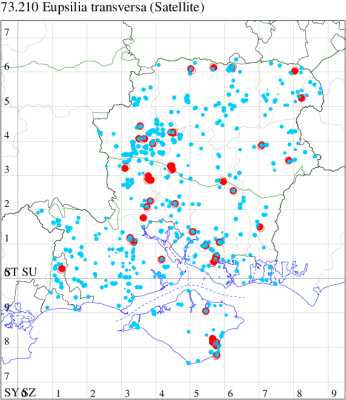
Records by year
Records by week (adult)
Records by week (larval)
Record Details
VC10: Bonchurch, one, 26 Feb; one, 01 Apr (JHa); Upper Hyde, larva, one, field observation, 18 May; America Wood, larva, two, field observation, 11 May; larva, one, field observation, 18 May; Shanklin, one, field observation, 02 Dec; two, 03 Mar; one, 07 Oct; one, 19 Oct; Sandpit Copse, larva, one, field observation, 20 May (IOu);
VC11: Brockwood, one, 17 Oct; one, 26 Oct (SDut); Woodlands, New Forest, present, 18 Oct (RBW); Ashurst, NF, present, 08 Apr; one, 07 Apr (SAB); Lee, one, 17 Oct (CTh); Romsey, one, 18 Sep (MB); Kings Somborne, two, to actinic, 14 Mar; Ashley, two, 19 Feb (GCE); Romsey, one, 17 Mar; one, 02 Apr; one, 10 Apr; one, 15 Nov (NRJ); Kings Somborne, one, to actinic, 14 Mar; one, to actinic, 14 Mar; Broughton, two, to actinic, 18 Oct (GCE); Winter Down Copse, King's Somborne, larva, one, field observation, 17 May (TJN, LF); Dibden Purlieu, one, 07 Nov (RAC); Southampton, one, 02 Feb (MEdg); Allbrook, one, 04 Apr (SI); Botley Wood, six, 24 Jan; one, 13 Mar; three, 23 Oct (F.M.G.); three, field observation, on guelder rose and hawthorn berries and rose hips by torchlight, 23 Oct (MLO); five, 11 Dec (F.M.G.); Fareham, one, 24 Mar (ADT); one, 20 Oct (IMcP); one, to actinic, 08 Nov (MLO); Botley, one, to actinic, 31 Jan; one, to actinic, 31 Jan; one, to actinic, 22 Feb; one, to actinic, 12 Oct; one, to actinic, 27 Oct; one, to actinic, 25 Jan; one, to actinic, 04 Feb; one, to actinic, 17 Feb; one, to actinic, 15 Nov (SLB); Wickham Common, two, 07 Feb (F.M.G.); Lovedean, one, 18 Mar; one, 23 Oct; one, 07 Nov; one, 09 Nov; one, 17 Nov (ARJ); West Meon, one, 16 Oct; one, 16 Oct (F.M.G.); Horndean, one, to actinic, 07 Nov (PHog);
VC12: Chilbolton, one, to actinic, 13 Oct (SLE); one, to actinic, 08 Nov; Goodworth Clatford, one, 17 Oct (GCE); Andover, two, 25 Feb (GSD); Wherwell, one, to actinic, 17 Oct; Crawley, one, to actinic, 17 Nov; one, to actinic, 18 Mar; one, to actinic, 18 Mar; one, to actinic, 17 Sep; Sparsholt, one, to actinic, 18 Mar; Barton Stacey, one, to actinic, 22 Oct; one, to actinic, 22 Oct; two, to actinic, 22 Oct; one, to actinic, 22 Oct (GCE); Hinton Ampner, one, 24 Oct; one, 11 Nov; one, 22 Nov (ASD); Ecchinswell, one, 04 Apr (MJN); Axmansford, one, 17 Oct (ACB); Beech, one, 10 Oct; three, 18 Oct (NDP); Pamber Forest, one, 20 Oct; one, 30 Oct; 18, 08 Nov; one, 11 Dec (GJD); Alton, one, to actinic, 19 Feb (BCA); one, to actinic, 11 Apr; one, to actinic, 07 Nov (DBO); Whitehill, one, to actinic, 22 Feb; one, to actinic, 23 Feb; two, to actinic, 05 Apr; one, 19 Oct; one, 21 Oct; two, 08 Nov (ASto); Church Crookham, one, to actinic, 08 Oct (DDim); Yateley, one, 16 Apr (JHH)
73.212 [B&F: 2311] Double Kidney Ipimorpha retusa (Linnaeus, 1761) - Local
Local in damp woodland, fens, marshes, and along river-banks throughout much of England. In Hampshire and on the Isle of Wight widespread though not usually very common. Wingspan 26-32 mm. The most likely confusion species is Olive I. subtusa, which see for differences. Larva feeds on Sallow, Eared Willow, Grey Willow, Goat Willow and Black Poplar, over-wintering as an egg.
Records prior to 2020
| Vice County | #Records | #Individuals | First Record | Last Record |
|---|---|---|---|---|
| 10 | 56 | 59 | 1930 | 2019 |
| 11 | 513 | 482 | 1947 | 2019 |
| 12 | 104 | 109 | 1947 | 2018 |
2020 records
| Vice County | #Records | #Individuals | Max Quantity |
|---|---|---|---|
| 11 | 5 | 5 | 2 |
| 12 | 1 | 1 | 1 |
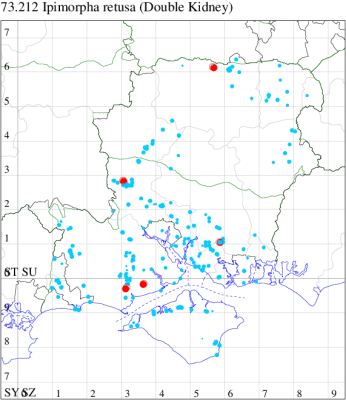
Records by year
Records by week (adult)
Records by week (larval)
Record Details
VC11: East Tytherley, one, to actinic, 10 Aug; two, to actinic, 10 Aug (GCE); Wickham Common, one, 20 Jul (KC); Lymington, one, to light, 04 Aug (ASH); Norleywood, NF, present, 09 Aug (RBW, MWa);
VC12: Axmansford, one, 13 Jul (ACB)
73.213 [B&F: 2312] Olive Ipimorpha subtusa ([Denis & Schiffermüller], 1775) - Local
Local in broad-leaved woodland, marshes, river-banks, gravel pits, gardens and parks throughout England, Wales and southern Scotland; widespread but only locally common across most of Hampshire and the Isle of Wight. Wingspan 28-34 mm. The main confusion species is Double Kidney I. retusa, but I. subtusa has distinctly convex subterminal fascia (straight in I. retusa) and much less pointed apex than I. retusa. Larva feeds high up in Aspen, Black Poplar and White Poplar trees, over-wintering as an egg.
Records prior to 2020
| Vice County | #Records | #Individuals | First Record | Last Record |
|---|---|---|---|---|
| 10 | 25 | 11 | 1893 | 2018 |
| 11 | 331 | 372 | 1951 | 2019 |
| 12 | 123 | 109 | 1951 | 2018 |
2020 records
| Vice County | #Records | #Individuals | Max Quantity |
|---|---|---|---|
| 10 | 1 | 0 | 0 |
| 11 | 1 | 1 | 1 |
| 12 | 5 | 5 | 1 |
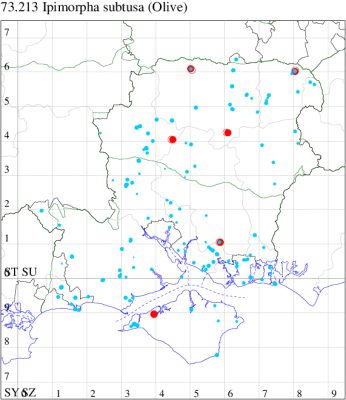
Records by year
Records by week (adult)
Records by week (larval)
Record Details
VC10: Cranmore, present, to actinic, 24 Jun (CHic);
VC11: Wickham Common, one, 20 Jul (KC);
VC12: Cholderton, one, 24 Jul (TJN, HE); Barton Stacey, one, to actinic, 12 Jul (GCE); Ecchinswell, one, 31 Jul (MJN); Preston Candover, one, 07 Aug (MJW); Yateley, one, 08 Aug (JHH)
73.215 [B&F: 2316] Lesser-spotted Pinion Cosmia affinis (Linnaeus, 1767) - Local
Local in woodland and hedgerows throughout much of southern England and Wales, south of a line from the Mersey to the Wash. In Hampshire and on the Isle of Wight Dutch elm disease has played havoc with the population of this elm-feeding species; formerly fairly widespread and not uncommon locally where there were tall elms but it has now all but disappeared. Wingspan 28-35 mm. The most likely confusion species is Lunar-spotted Pinion C. pyralina, which see for differences. Larva feeds on English Elm, Small-leaved Elm and Wych Elm, over-wintering as an egg.
Records prior to 2020
| Vice County | #Records | #Individuals | First Record | Last Record |
|---|---|---|---|---|
| 10 | 36 | 21 | 1856 | 2018 |
| 11 | 70 | 50 | 1951 | 2018 |
| 12 | 36 | 25 | 1951 | 2019 |
2020 records
| Vice County | #Records | #Individuals | Max Quantity |
|---|---|---|---|
| 11 | 3 | 3 | 1 |
| 12 | 1 | 1 | 1 |
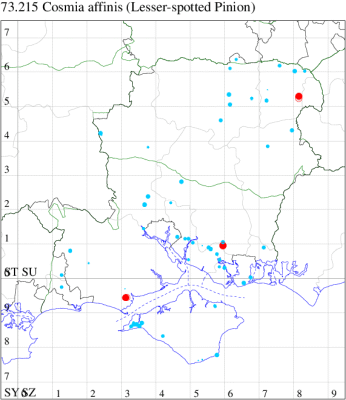
Records by year
Records by week (adult)
Records by week (larval)
Record Details
VC11: Southampton, one, 07 Aug (MEdg); Wickham, one, 07 Aug (F.M.G.); Pennington, one, 31 Jul (RFC);
VC12: Fleet, one, 01 Aug (MHals)
73.216 [B&F: 2318] Dun-bar Cosmia trapezina (Linnaeus, 1758) - Common
Common in woodland, gardens and hedgerows throughout the British Isles; very widespread and common across most of Hampshire and the Isle of Wight. Wingspan 28-38 mm. Very variable in colour, but general pattern of cross-lines always discernible, making the species generally easy to recognise. Larva polyphagous on various broad-leaved trees and shrubs including Elm, Oak, Birch, Blackthorn, Hawthorn, Hazel, Willow and Field Maple, and on the larvae of other moths, most notably on Winter Moth, but possibly also cannibalistic, over-wintering as an egg.
Records prior to 2020
| Vice County | #Records | #Individuals | First Record | Last Record |
|---|---|---|---|---|
| 10 | 790 | 2362 | 1951 | 2019 |
| 11 | 7221 | 14961 | 200 | 2019 |
| 12 | 2661 | 9121 | 1951 | 2019 |
2020 records
| Vice County | #Records | #Individuals | Max Quantity |
|---|---|---|---|
| 10 | 36 | 83 | 14 |
| 11 | 180 | 253 | 11 |
| 12 | 176 | 457 | 28 |
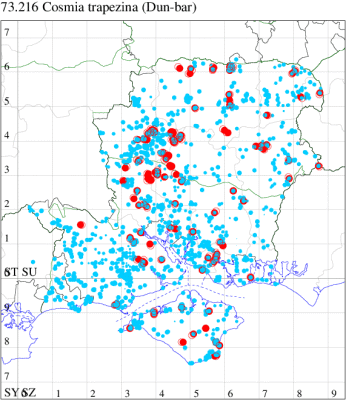
Records by year
Records by week (adult)
Records by week (larval)
Record Summary
VC10: Earliest: West High Down Quarry, 07 Aug, 5 (IOu) Latest: Firestone Copse, 21 Jul, 1 (IOu) Max count: Shanklin, 09 Aug, 14 (IOu)
VC11: Earliest: Godshill, NF, 12 Jul, 0 (RBW, MWa) Latest: Milford on Sea, 27 Jul, 1 (MMcM) Max count: Kings Somborne, 15 Jul, 11 (GCE)
VC12: Earliest: Cholderton, 10 Jul, 1 (TJN, HE) Latest: Yateley, 17 Aug, 1 (JHH) Max count: Crawley, 21 Jul, 28 (GCE)
73.217 [B&F: 2319] Lunar-spotted Pinion Cosmia pyralina ([Denis & Schiffermüller], 1775) - Local
Local in hedgerows, scrub, woodland, parks and gardens throughout much of southern England, north to Merseyside and Humberside. In Hampshire and on the Isle of Wight still widespread and moderately common, although has declined due to the ravages of Dutch Elm Disease. Wingspan 29-34 mm. The main confusion species is Lesser-spotted Pinion C. affinis; in C. pyralina the costa is relatively more arched, and the hindwing paler, without a dark border, so that the cilia contrast less with the rest of the wing (MBGBI Vol 10). Larva polyphagous on many deciduous trees and shrubs, favouring elm, and over-wintering as an egg.
Records prior to 2020
| Vice County | #Records | #Individuals | First Record | Last Record |
|---|---|---|---|---|
| 10 | 166 | 255 | 1856 | 2019 |
| 11 | 424 | 428 | 1951 | 2019 |
| 12 | 187 | 186 | 1951 | 2019 |
2020 records
| Vice County | #Records | #Individuals | Max Quantity |
|---|---|---|---|
| 10 | 9 | 9 | 1 |
| 11 | 3 | 3 | 1 |
| 12 | 4 | 7 | 4 |
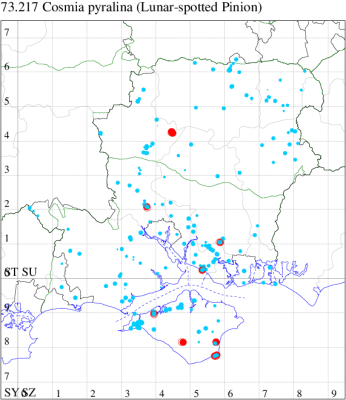
Records by year
Records by week (adult)
Records by week (larval)
Record Details
VC10: Ningwood Common, one, to actinic, 16 Jun (JMar); Kingston, one, 01 Jul; one, 16 Jul; one, 29 Jul (ENes); Wheelers Bay, one, 09 Aug (ABu); Bonchurch, one, 24 Jun; one, 12 Jul; one, 16 Aug (JHa); Shanklin, one, 30 Jul (IOu);
VC11: Romsey, one, 06 Aug (MB); Titchfield Haven NNR, one, 17 Jul (F.M.G. det. KJW); Wickham Common, one, 06 Jul (KC);
VC12: Barton Stacey, four, to actinic, 16 Jul; one, to actinic, 25 Jun; one, to actinic, 16 Jul; one, to actinic, 25 Jun (GCE)
73.219 [B&F: 2269] Centre-barred Sallow Atethmia centrago (Haworth, 1809) - Common
Common in broad-leaved woodland, hedgerows and gardens throughout much of the British Isles. In Hampshire and on the Isle of Wight widespread and common, a species of conservation concern under the UK Biodiversity Action Plan. Wingspan 32-38 mm. Unmistakable. Larva feeds on flower buds of Ash, preferring isolated, mature trees.
Records prior to 2020
| Vice County | #Records | #Individuals | First Record | Last Record |
|---|---|---|---|---|
| 10 | 85 | 80 | 1943 | 2019 |
| 11 | 1129 | 1466 | 1949 | 2019 |
| 12 | 475 | 838 | 1951 | 2019 |
2020 records
| Vice County | #Records | #Individuals | Max Quantity |
|---|---|---|---|
| 10 | 32 | 117 | 15 |
| 11 | 128 | 206 | 8 |
| 12 | 26 | 45 | 4 |
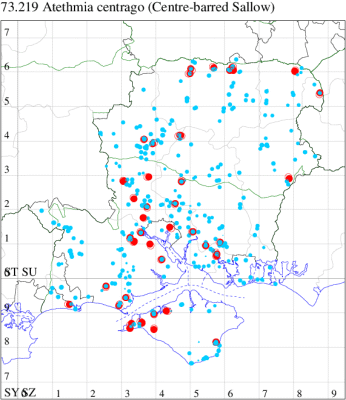
Records by year
Records by week (adult)
Records by week (larval)
Record Summary
VC10: Earliest: West High Down Quarry, 08 Sep, 5 (IOu) Latest: Shanklin, 20 Sep, 1 (IOu) Max count: Freshwater, 18 Sep, 15 (PBa)
VC11: Earliest: Marchwood, 29 Aug, 1 (CTh) Latest: Pennington, 15 Sep, 1 (RFC) Max count: Allbrook, 08 Sep, 8 (SI)
VC12: Earliest: Cholderton, 05 Sep, 4 (TJN, LF) Latest: Yateley, 08 Sep, 2 (JHH) Max count: Cholderton, 05 Sep, 4 (TJN, LF)
73.220 [B&F: 2225] Minor Shoulder-knot Brachylomia viminalis (Fabricius, [1777]) - Common
Common in damp woodland, marshes, fens and gardens throughout the British Isles, a species of conservation concern under the UK Biodiversity Action Plan;. Well distributed across much of Hampshire and on the Isle of Wight. Wingspan 29-35 mm. Potential confusion species all lack basal streak on forewing and emerge earlier in the year. Larva feeds on most species of Sallow, amongst which the larvae are often common in the spun shoots, over-wintering as an egg.
Records prior to 2020
| Vice County | #Records | #Individuals | First Record | Last Record |
|---|---|---|---|---|
| 10 | 245 | 805 | 1856 | 2019 |
| 11 | 1177 | 1983 | 1881 | 2019 |
| 12 | 362 | 691 | 1949 | 2019 |
2020 records
| Vice County | #Records | #Individuals | Max Quantity |
|---|---|---|---|
| 10 | 2 | 5 | 5 |
| 11 | 6 | 5 | 1 |
| 12 | 14 | 19 | 4 |
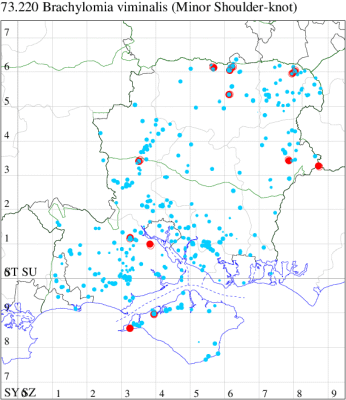
Records by year
Records by week (adult)
Records by week (larval)
Record Details
VC10: West High Down Quarry, five, 07 Aug (IOu); Cranmore, present, to actinic, 13 Jun (CHic);
VC11: Marchwood, one, 24 Jun (CTh); Woodlands, New Forest, present, 02 Jul (RBW); Stockbridge Down NT, one, to actinic, 19 Jun; one, to actinic, 19 Jun; one, to actinic, 19 Jun (GCE);
VC12: Axmansford, one, 13 Jul (ACB); Basingstoke, one, 26 Jun (MJW); Pamber Forest, one, 14 Jun; one, 17 Jun; one, 23 Jun; two, 01 Jul; four, 03 Jul (GJD); Whitehill, one, to actinic, 20 Jun; two, to actinic, 25 Jun; one, to actinic, 27 Jun (ASto); Castle Bottom NNR, present, 25 Jun (JHH, AMD); Hammer Vale, Woolmer, one, 10 Jul (ASw); Yateley, one, 23 Jun (JHH)
73.221 [B&F: 2268] Suspected Parastichtis suspecta (Hübner, [1817]) - Local
Local in fens, damp woodland, scrubby heathland and moorland throughout the British Isles. In Hampshire this species occurs in birch-heath country, mainly in the New Forest and the north-east. There are two records from the Isle of Wight, one very old. Wingspan 29-34 mm. Easily overlooked amongst the far more numerous rustic and minor species of high summer, but candidates can usually be picked out from these on the basis of size and wing-shape — look for a slightly arched costa, rounded termen, and somewhat pointed apex — rather variable in colour and intensity of markings, but often variable shades of red, with finely white-edged reniform and orbicular stigmata, and dentate black cross-lines often reduced or faint. Larva feeds on Silver and Downy Birch, and Sallow, over-wintering as an egg.
Records prior to 2020
| Vice County | #Records | #Individuals | First Record | Last Record |
|---|---|---|---|---|
| 10 | 4 | 5 | 1897 | 2019 |
| 11 | 535 | 705 | 1951 | 2019 |
| 12 | 150 | 247 | 1951 | 2019 |
2020 records
| Vice County | #Records | #Individuals | Max Quantity |
|---|---|---|---|
| 11 | 8 | 9 | 2 |
| 12 | 6 | 6 | 2 |
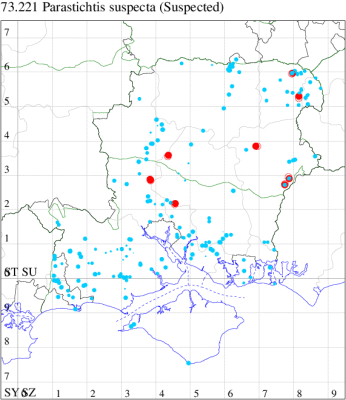
Records by year
Records by week (adult)
Records by week (larval)
Record Details
VC11: Kings Somborne, one, to actinic, 09 Jul; two, to actinic, 09 Jul (GCE); Allbrook, one, 24 Jun (SI); Wickham, one, 04 Jul; one, 05 Jul; one, 09 Jul; one, 14 Jul (JRDS);
VC12: Crawley, one, to actinic, 12 Aug (GCE); Beech, one, 14 Jul (NDP); Liss, two, 07 Aug (LBe); Liss Forest, one, field observation, 05 Jul (RJM); Castle Bottom NNR, present, 25 Jun (JHH, AMD); Fleet, one, 15 Jul (MHals)
73.222 [B&F: 2314] Dingy Shears Fissipunctia ypsillon ([Denis & Schiffermüller], 1775) - Local
Local in damp woodland, marshes and fens throughout much of England and Wales. In Hampshire and on the Isle of Wight scattered through the three vice-counties, mainly along the river valleys. Wingspan 32-42 mm. Characterised by the pale, sinuous subterminal line, often edged basally by two or more moderately distinct, dark wedge-shaped spots (MBGBI Vol 10). Larva feeds on catkins and leaves of Eared Willow, Grey Willow, Goat Willow, Sallow, Black Poplar and White Poplar, over-wintering as an egg.
Records prior to 2020
| Vice County | #Records | #Individuals | First Record | Last Record |
|---|---|---|---|---|
| 10 | 28 | 7 | 1856 | 2018 |
| 11 | 727 | 792 | 1951 | 2019 |
| 12 | 228 | 297 | 1940 | 2019 |
2020 records
| Vice County | #Records | #Individuals | Max Quantity |
|---|---|---|---|
| 11 | 6 | 6 | 1 |
| 12 | 1 | 1 | 1 |
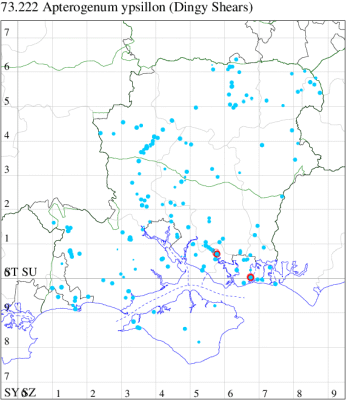
Records by year
Records by week (adult)
Records by week (larval)
Record Details
VC11: Fareham, one, 25 Jun; one, 26 Jun (KJW); Portsmouth, one, 15 Jun (IRT); Lovedean, one, 12 Jun; one, 13 Jun (ARJ); Horndean, one, field observation, 24 Apr (JAN)
73.222 [B&F: 2314] Dingy Shears Apterogenum ypsillon ([Denis & Schiffermüller], 1775) - Local
Local in damp woodland, marshes and fens throughout much of England and Wales. In Hampshire and on the Isle of Wight scattered through the three vice-counties, mainly along the river valleys. Wingspan 32-42 mm. Characterised by the pale, sinuous subterminal line, often edged basally by two or more moderately distinct, dark wedge-shaped spots (MBGBI Vol 10). Larva feeds on catkins and leaves of Eared Willow, Grey Willow, Goat Willow, Sallow, Black Poplar and White Poplar, over-wintering as an egg.
Records prior to 2020
| Vice County | #Records | #Individuals | First Record | Last Record |
|---|---|---|---|---|
| 10 | 28 | 7 | 1856 | 2018 |
| 11 | 727 | 792 | 1951 | 2019 |
| 12 | 228 | 297 | 1940 | 2019 |
2020 records
| Vice County | #Records | #Individuals | Max Quantity |
|---|---|---|---|
| 11 | 6 | 6 | 1 |
| 12 | 1 | 1 | 1 |

Records by year
Records by week (adult)
Records by week (larval)
Record Details
VC11: Fareham, one, 25 Jun; one, 26 Jun (KJW); Portsmouth, one, 15 Jun (IRT); Lovedean, one, 12 Jun; one, 13 Jun (ARJ); Horndean, one, field observation, 24 Apr (JAN)
73.223 [B&F: 2246a] Oak Rustic Dryobota labecula (Esper, 1788) - Nationally Scarce
This species was found in Jersey in 1991 and is now established on Evergreen (Holm) Oak in the Channel Islands. First recorded in Britain at Freshwater, Isle of Wight, on 15 October 1999, and now annual in Freshwater and Ventnor in reasonable numbers, although only one confirmed larval record exists, from Fort Victoria in 2006; subsequently appearing in mainland Hampshire on 15 October 2005, and increasingly thereafter along the south coast: there have been two larval records to 2015. Wingspan 30-32 mm. The main confusion species are certain forms of Common Rustic Mesapamea secalis and Lesser Common Rustic Mesapamea didyma, but Oak Rustic usually has orange (occasionally white) reniform stigmata and flies very late in the season.
Records prior to 2020
| Vice County | #Records | #Individuals | First Record | Last Record |
|---|---|---|---|---|
| 10 | 159 | 833 | 1999 | 2019 |
| 11 | 172 | 234 | 2005 | 2019 |
| 12 | 1 | 1 | 2011 | 2011 |
2020 records
| Vice County | #Records | #Individuals | Max Quantity |
|---|---|---|---|
| 10 | 7 | 14 | 7 |
| 11 | 5 | 4 | 1 |
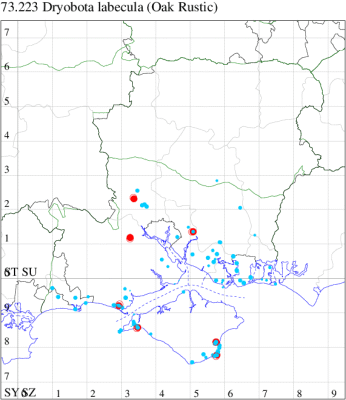
Records by year
Records by week (adult)
Records by week (larval)
Record Details
VC10: Freshwater Bay, one, 18 Oct; one, 22 Nov (SDa); Bonchurch, one, 07 Nov; seven, 08 Nov; two, 11 Dec (JHa); Shanklin, one, 19 Oct; one, 08 Nov (IOu);
VC11: Woodlands, New Forest*, present, 09 Nov (RBW); Stanbrige Earls, one, to actinic, 07 Nov (JRMi); Botley, one, to actinic, 29 Oct (SLB); Milford on Sea, one, 07 Nov (MMcM)
73.224 [B&F: 2247] Merveille du Jour Griposia aprilina (Linnaeus, 1758) - Common
Common in broad-leaved woodland, especially mature oak woods, parks, hedgerows and gardens throughout the British Isles; still widespread and common in Hampshire and on the Isle of Wight. Wingspan 42-52 mm. Similar in general appearance to Scarce Merveille du Jour Moma alpium, but flies much later in the year, and is less heavily marked with black. Larva feeds on flowers and leaves of Oak, over-wintering as an egg; in spring the larvae can be found by day, wedged into crevices in the bark of old oak trees.
Records prior to 2020
| Vice County | #Records | #Individuals | First Record | Last Record |
|---|---|---|---|---|
| 10 | 177 | 287 | 1930 | 2019 |
| 11 | 1568 | 2322 | 1951 | 2019 |
| 12 | 345 | 419 | 1951 | 2019 |
2020 records
| Vice County | #Records | #Individuals | Max Quantity |
|---|---|---|---|
| 10 | 12 | 17 | 4 |
| 11 | 106 | 150 | 5 |
| 12 | 37 | 60 | 5 |
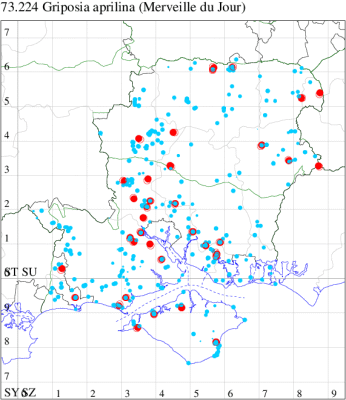
Records by year
Records by week (adult)
Records by week (larval)
Record Summary
VC10: Earliest: Freshwater Bay, 07 Nov, 1 (SDa) Latest: Shanklin, 07 Nov, 1 (IOu) Max count: Shanklin, 14 Oct, 4 (IOu)
VC11: Earliest: Brockwood, 17 Oct, 2 (SDut) Latest: Pennington, 16 Nov, 1 (RFC) Max count: Romsey, 07 Nov, 5 (MB)
VC12: Earliest: Cholderton, 10 Oct, 1 (TJN, LF) Latest: Farnborough, 19 Oct, 1 (KBW) Max count: Axmansford, 17 Oct, 5 (ACB)
73.225 [B&F: 2248] Brindled Green Dryobotodes eremita (Fabricius, 1775) - Common
Common wherever there are oak trees, in broad-leaved woodland, parks and gardens throughout the British Isles. Widespread and reasonably common in Hampshire and on the Isle of Wight. Wingspan 32-39 mm. A regular visitor to light traps in autumn, usually in small numbers. Larva feeds on buds and leaves of Pedunculate and Sessile Oak.
Records prior to 2020
| Vice County | #Records | #Individuals | First Record | Last Record |
|---|---|---|---|---|
| 10 | 166 | 286 | 1951 | 2019 |
| 11 | 1743 | 2383 | 1946 | 2019 |
| 12 | 532 | 924 | 1951 | 2019 |
2020 records
| Vice County | #Records | #Individuals | Max Quantity |
|---|---|---|---|
| 10 | 11 | 16 | 4 |
| 11 | 72 | 100 | 5 |
| 12 | 33 | 51 | 6 |
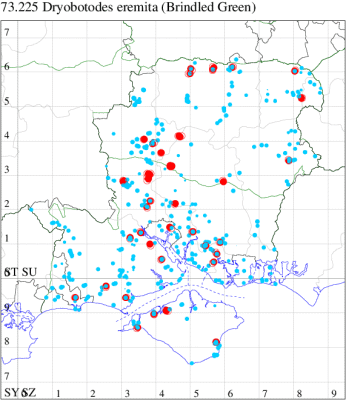
Records by year
Records by week (adult)
Records by week (larval)
Record Summary
VC10: Earliest: Freshwater Bay, 14 Sep, 2 (SDa) Latest: Shanklin, 22 Oct, 1 (IOu) Max count: Walter's Copse, Newtown, 22 Sep, 4 (PBa)
VC11: Earliest: Marchwood, 26 Sep, 1 (CTh) Latest: Pennington, 17 Oct, 1 (RFC) Max count: East Tytherley, 14 Sep, 5 (GCE)
VC12: Earliest: Chilbolton, 08 Oct, 1 (SLE) Latest: Yateley, 14 Sep, 2 (JHH) Max count: Axmansford, 22 Sep, 6 (ACB)
73.227 [B&F: 2248b] Sombre Brocade Dryobotodes tenebrosa (Esper, 1789) - Migrant
Very rare immigrant from southern Europe, appearing in Guernsey at Icart Point on 3 October 2006, since when it has become quite regular there. Recorded for the first time on mainland Britain at Durlston CP, Dorset, on 12 October 2008, with four at the same site between 29 September 2009 and 10 October 2009, suggesting that the species may be breeding locally. In Hampshire recorded for the first time at Sandy Point, Hayling, on 28 September 2010, the sixth British record, with two more records subsequently; on the Isle of Wight, it was first seen in 2012, and then underwent a remarkable transformation of status: after five in 2013, there have been multiple annual records, and it is almost certainly locally resident in the Bonchurch / Ventnor area. Wingspan 36-40 mm. Much darker and larger than Brindled Green D. eremita and appears very much later than Dark Brocade Blepharita adusta, from which distinguished by its generally smaller size, lack of white scaling in the reniform stigma, less angled forewing termen, and well-defined, curved postmedian line on the hindwing. Larva feeds on Evergreen Oak, no evidence of breeding in the UK.
Records prior to 2020
| Vice County | #Records | #Individuals | First Record | Last Record |
|---|---|---|---|---|
| 10 | 41 | 54 | 2012 | 2019 |
| 11 | 2 | 2 | 2010 | 2016 |
2020 records
| Vice County | #Records | #Individuals | Max Quantity |
|---|---|---|---|
| 10 | 4 | 6 | 3 |
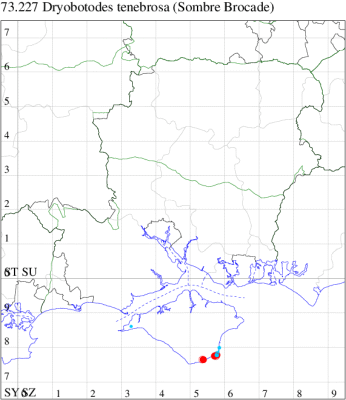
Records by year
Records by week (adult)
Records by week (larval)
Record Details
VC10: St Lawrence: Salem Close, one, to actinic, 26 Sep (PBa); Wheelers Bay, one, 16 Sep (ABu); Bonchurch, one, 07 Sep; three, 26 Sep (JHa)
73.229 [B&F: 2251] Flame Brocade Trigonophora flammea (Esper, 1785) - Recent colonist
Established, probably by prior immigration, from at least 1855 to about 1892; thereafter an occasional immigrant from northern Europe, appearing in southern England, in some years arriving in sufficient numbers to breed, in very small numbers. In Hampshire and on the Isle of Wight this species remains an extremely scarce migrant to southern coasts, but is being reported with increasing regularity, and following the influx of 2011 it is known to have established a small breeding presence in Dorset and East Sussex. Wingspan 45-53 mm. Larva feeds on Lesser Celandine, Meadow Buttercup, Blackthorn and Broom.
Records prior to 2020
| Vice County | #Records | #Individuals | First Record | Last Record |
|---|---|---|---|---|
| 10 | 56 | 62 | 1990 | 2018 |
| 11 | 24 | 24 | 1968 | 2015 |
2020 records
| Vice County | #Records | #Individuals | Max Quantity |
|---|---|---|---|
| 10 | 2 | 2 | 1 |
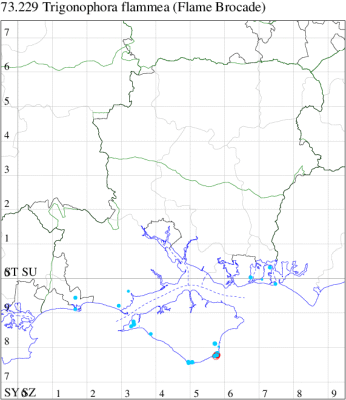
Records by year
Records by week (adult)
Records by week (larval)
Record Details
VC10: Bonchurch, one, 20 Oct; one, 22 Oct (JHa)
73.230 [B&F: 2230] Feathered Brindle Aporophyla australis (Boisduval, 1829) - Nb
Nationally scarce (Nb) on shingle beaches, sand-dunes and sea cliffs, along the coasts of southern and south-eastern England from Cornwall to Suffolk and, locally, on the southern slopes of the South Downs. On the Isle of Wight, common on the Freshwater cliffs. In Hampshire there have been two records, at Southsea in September 1988, and Hengistbury Head (in the Dorset section of vice-county 11) in October 1996. Wingspan 36-42 mm. The dark form ingenua could be confused with Deep-brown Dart A. lutulenta, which flies at the same time, sometimes on the same ground, but in A. lutulenta the forewing is more ample, with pointed apex; the median fascia is darker than the adjacent areas and the fringe is not chequered (MBGBI Vol 10). Larva feeds on various herbaceous plants, including Sea Campion, Common Sorrel, Bramble and Wood Sage.
Records prior to 2020
| Vice County | #Records | #Individuals | First Record | Last Record |
|---|---|---|---|---|
| 10 | 66 | 137 | 1856 | 2017 |
| 11 | 8 | 4 | 1981 | 2016 |
2020 records
| Vice County | #Records | #Individuals | Max Quantity |
|---|---|---|---|
| 10 | 13 | 52 | 8 |
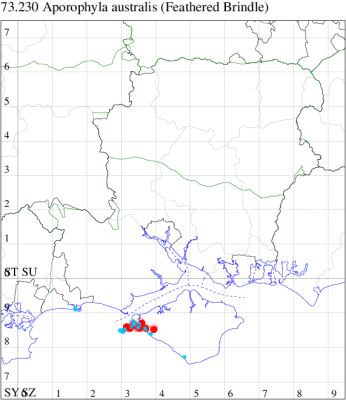
Records by year
Records by week (adult)
Records by week (larval)
Record Details
VC10: Headon Warren, one, to actinic, 17 Sep (PBa); West High Down Quarry, six, to light, 08 Sep (IOu); Freshwater, one, 14 Sep (DBW); Freshwater Bay, one, 14 Sep (SDa); four, to actinic, 15 Sep; three, to actinic, 17 Sep; seven, to actinic, 19 Sep; four, to actinic, 21 Sep; Freshwater, one, to actinic, 20 Sep; Compton Down, eight, to actinic, 13 Sep; six, to actinic, 14 Sep; seven, to actinic, 20 Sep; Brook Down, three, to actinic, 19 Sep (PBa)
73.232 [B&F: 2231a] Deep-brown Dart Aporophyla lueneburgensis (Freyer, 1848) - Common
Common on calcareous grassland, rough meadows, downland, heathland, sand-dunes and gardens throughout England; wanderers do turn up some distance from known colonies, a species of conservation concern under the UK Biodiversity Action Plan. Fairly well distributed and common in Hampshire, but restricted on the Isle of Wight to the western tip. Wingspan 38-42 mm. Larva feeds on Broad-leaved Dock, Common Sorrel, Sheep's Sorrel and other herbaceous plants, and various grasses.
Records prior to 2020
| Vice County | #Records | #Individuals | First Record | Last Record |
|---|---|---|---|---|
| 10 | 44 | 54 | 1900 | 2018 |
| 11 | 874 | 1280 | 1949 | 2019 |
| 12 | 164 | 265 | 1951 | 2019 |
2020 records
| Vice County | #Records | #Individuals | Max Quantity |
|---|---|---|---|
| 10 | 10 | 12 | 3 |
| 11 | 90 | 153 | 8 |
| 12 | 13 | 16 | 2 |
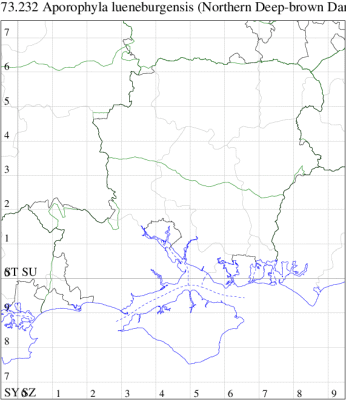
Records by year
Records by week (adult)
Records by week (larval)
Record Summary
VC10: Earliest: Totland, 19 Sep, 1 (RTe) Latest: Shanklin, 16 Oct, 1 (IOu) Max count: Freshwater Bay, 21 Sep, 3 (PBa)
VC11: Earliest: Brockwood, 12 Sep, 1 (SDut) Latest: Pennington, 28 Sep, 2 (RFC) Max count: Botley, 20 Sep, 8 (SLB)
VC12: Earliest: Cholderton, 10 Oct, 1 (TJN, LF) Latest: Fleet, 02 Oct, 1 (MHals) Max count: Burghclere, 19 Sep, 2 (PBl)
73.233 [B&F: 2232] Black Rustic Aporophyla nigra (Haworth, 1809) - Common
Common on heathland, moorland, calcareous grassland, roadside verges, gardens and woodland rides throughout most of the British Isles. Widespread and common in Hampshire and on the Isle of Wight. Wingspan 40-46 mm. Larva feeds on various woody and herbaceous plants, including Tufted Hair-grass, Heather, Clover and Dock.
Records prior to 2020
| Vice County | #Records | #Individuals | First Record | Last Record |
|---|---|---|---|---|
| 10 | 562 | 2154 | 1951 | 2019 |
| 11 | 5311 | 14313 | 1949 | 2019 |
| 12 | 1550 | 6421 | 1951 | 2019 |
2020 records
| Vice County | #Records | #Individuals | Max Quantity |
|---|---|---|---|
| 10 | 36 | 92 | 12 |
| 11 | 334 | 761 | 12 |
| 12 | 106 | 248 | 10 |
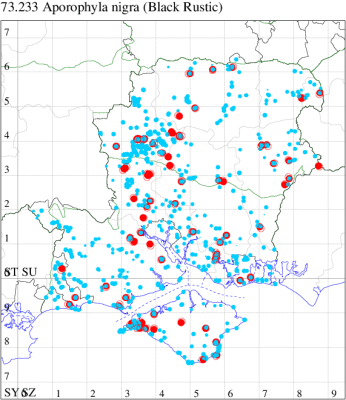
Records by year
Records by week (adult)
Records by week (larval)
Record Summary
VC10: Earliest: Totland, 18 Sep, 1 (RTe) Latest: Shanklin, 20 Oct, 3 (IOu) Max count: Shanklin, 16 Oct, 12 (IOu)
VC11: Earliest: Brockwood, 19 Sep, 9 (SDut) Latest: Southsea, 28 Oct, 1 (JGe) Max count: Botley, 23 Sep, 12 (SLB)
VC12: Earliest: Over Wallop, 17 Oct, 2 (CM) Latest: Farnborough, 19 Oct, 2 (KBW) Max count: Cholderton, 10 Oct, 10 (TJN, LF)
73.234 [B&F: 2229] Brindled Ochre Dasypolia templi (Thunberg, 1792) - Local
Local on grassland, sea cliffs, sand-dunes, upland grassland, moorland and sand-dunes throughout much of Scotland, northern England and south-western England, predominantly coastal, a species of conservation concern under the UK Biodiversity Action Plan. The species is almost entirely coastal in southern England, but it occurs also inland from the north Midlands northward; in the southern part of the range it is always found in association with rocks, but further north it is more generally distributed, and in Scotland becomes progressively more common from south to north, abundant in Orkney and Shetland (MBGBI Vol 10). In Hampshire and on the Isle of Wight there is an established population in the Freshwater area of the Island, and a scattering of records in south-west Hampshire. Wingspan 40-56 mm. Larva feeds on Hogweed and Wild Angelica.
Records prior to 2020
| Vice County | #Records | #Individuals | First Record | Last Record |
|---|---|---|---|---|
| 10 | 51 | 75 | 1875 | 2019 |
| 11 | 14 | 5 | 1951 | 2001 |
| 12 | 1 | 1 | 1969 | 1969 |
2020 records
| Vice County | #Records | #Individuals | Max Quantity |
|---|---|---|---|
| 10 | 1 | 1 | 1 |
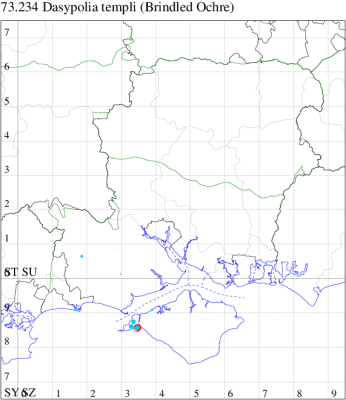
Records by year
Records by week (adult)
Records by week (larval)
Record Details
VC10: Freshwater Bay, one, 18 Oct (SDa)
73.235 [B&F: 2255] Feathered Ranunculus Polymixis lichenea (Hübner, [1813]) - Local
Local on sea cliffs, sand-dunes, shingle beaches and grassy slopes, on the coast of England and Wales. In Hampshire fairly common in the south and on the Isle of Wight, but very uncommon in the north. Wingspan 39-43 mm. Can only be confused with Black-banded P. xanthomista or Large Ranunculus P. flavicincta, which see. Larva feeds on Hound's-tongue, Sea Plantain, Thrift and Biting Stonecrop.
Records prior to 2020
| Vice County | #Records | #Individuals | First Record | Last Record |
|---|---|---|---|---|
| 10 | 448 | 1380 | 1856 | 2019 |
| 11 | 2529 | 7038 | 1947 | 2019 |
| 12 | 15 | 12 | 1979 | 2008 |
2020 records
| Vice County | #Records | #Individuals | Max Quantity |
|---|---|---|---|
| 10 | 27 | 72 | 9 |
| 11 | 112 | 198 | 12 |
| 12 | 1 | 1 | 1 |
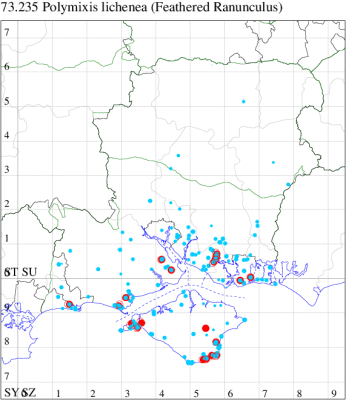
Records by year
Records by week (adult)
Records by week (larval)
Record Summary
VC10: Earliest: Totland, 19 Sep, 2 (RTe) Latest: Shanklin, 26 Oct, 1 (IOu) Max count: Ventnor, 27 Oct, 9 (JPat)
VC11: Earliest: Dibden Purlieu, 15 Sep, 1 (RAC) Latest: Southsea, 30 Oct, 2 (JRL) Max count: Portsmouth, 22 Oct, 12 (IRT)
VC12: Earliest: Harestock, 18 Oct, 1 (GRog) Max count: Harestock, 18 Oct, 1 (GRog)
73.237 [B&F: 2252] Large Ranunculus Polymixis flavicincta ([Denis & Schiffermüller], 1775) - Local
Local in gardens, waste ground, damp meadows and rough ground throughout much of southern England and Wales. In Hampshire previously very local and by no means common, except in the Alton/Selborne area, but in recent years has become a relatively common autumn moth, perhaps indicating a recent range expansion and growth in population. On the Isle of Wight, remains extremely uncommon. Wingspan 42-52 mm. Larva feeds on Dandelion, Rosebay Willowherb, Red Valerian and Common Ragwort, over-wintering as an egg.
Records prior to 2020
| Vice County | #Records | #Individuals | First Record | Last Record |
|---|---|---|---|---|
| 10 | 10 | 8 | 1908 | 2019 |
| 11 | 181 | 196 | 1951 | 2019 |
| 12 | 576 | 891 | 1948 | 2019 |
2020 records
| Vice County | #Records | #Individuals | Max Quantity |
|---|---|---|---|
| 11 | 2 | 2 | 1 |
| 12 | 14 | 19 | 3 |
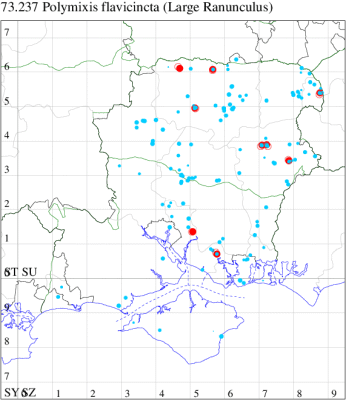
Records by year
Records by week (adult)
Records by week (larval)
Record Details
VC11: Fareham, one, ♂, 28 Sep (KJW); Botley, one, to actinic, 05 Oct (SLB); Stroud, Petersfield, one, to actinic, 30 Sep (RAll);
VC12: Burghclere, one, 19 Sep (PBl); Overton, three, 29 Sep (MSi); Axmansford, one, to artificial light, 06 Oct (ACB); Alton, one, to actinic, 17 Sep (DBO); one, to actinic, 18 Sep (CJP); Whitehill, one, 15 Sep; two, 19 Sep; one, 22 Sep; one, 28 Sep; one, 05 Oct; one, 08 Oct (ASto); Lower Froyle, one, 11 Sep (EFig); Farnborough, one, 05 Oct (KBW)
()().jpg)
()(report only).jpg)
(to actinic)().jpg)


()().jpg)